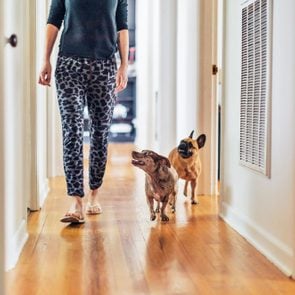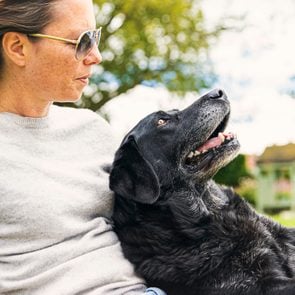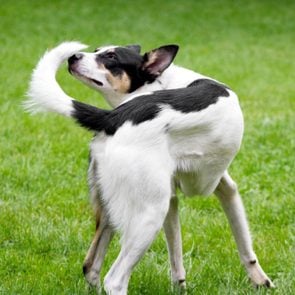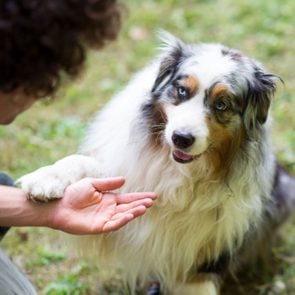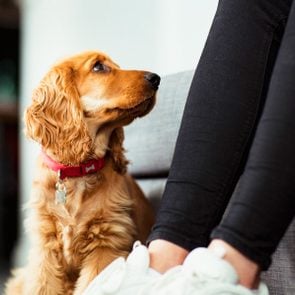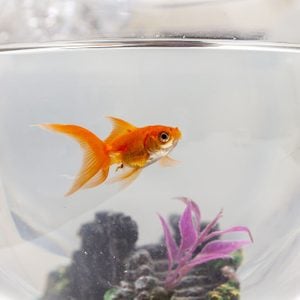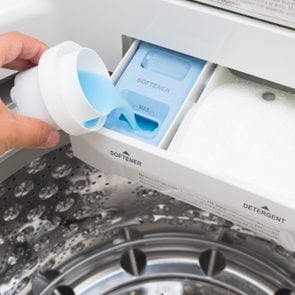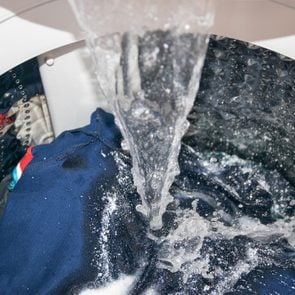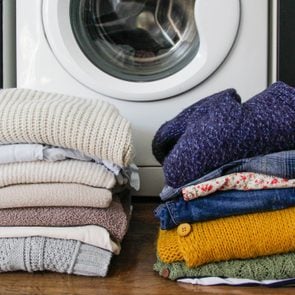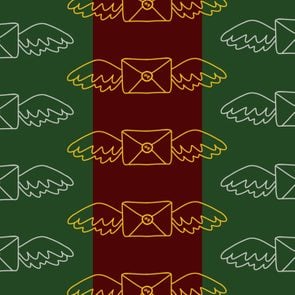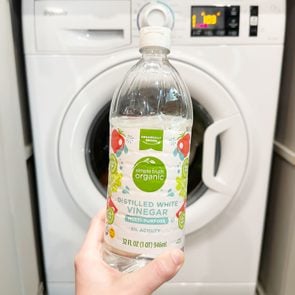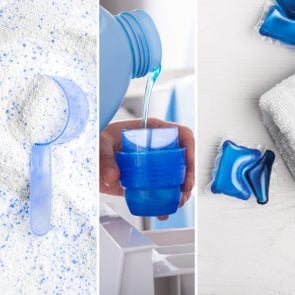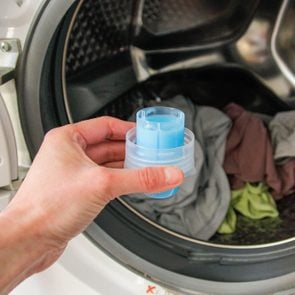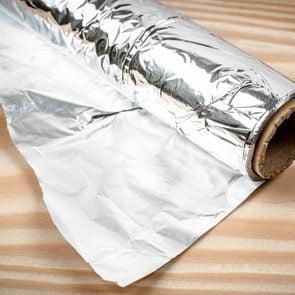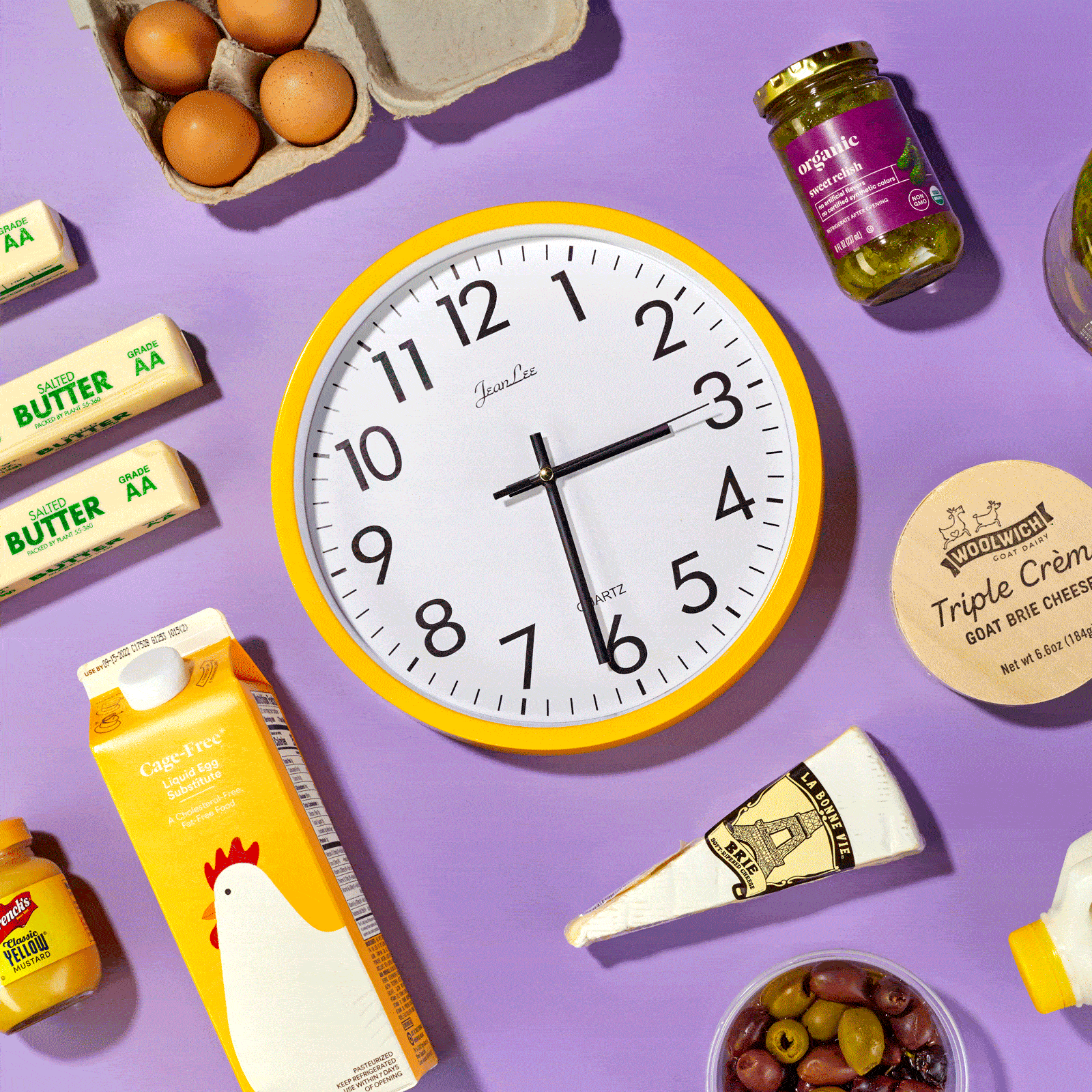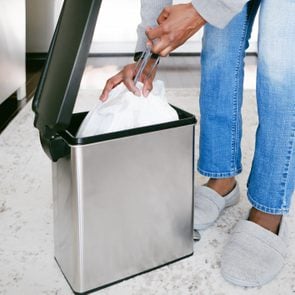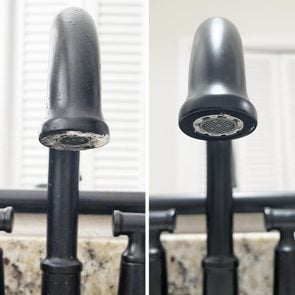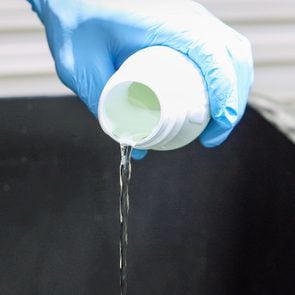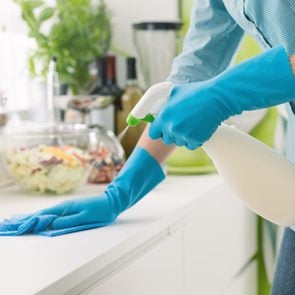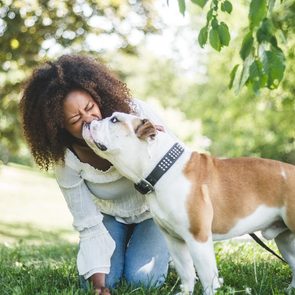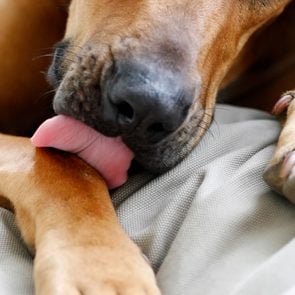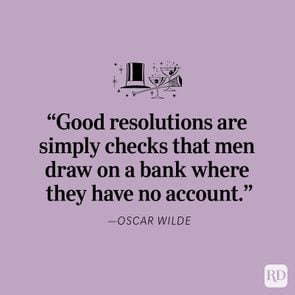If you’ve ever playfully teased a dog, you know it’s all fun and games until, well, it’s no longer fun. After you’ve stolen a dog’s bone or pretended to throw a ball one too many times, the dog may bark, stiffen, growl or even walk away. Most pet owners have been there, sheepishly wondering Is my dog mad at me?
Can dogs even get angry? What about frustrated or annoyed? It sure seems that way sometimes. Even though we’re different species, it’s tempting to interpret dog behavior through a human lens. After all, when it comes to emotions, we have a lot in common with our four-legged friends.
In over 13 years as a certified professional dog trainer, I’ve come to appreciate that dogs share many of the same basic feelings we do. My Chihuahua gets scared during fireworks shows, happy when he plays with his snuffle mat and, yes, angry when he is removed from a lap. I appreciate those feelings, encourage the positive ones and help alleviate the negative ones. Once you can recognize emotions like anger in your dog, you can better empathize and respond.
With that in mind, I asked three canine behavior experts to help me explore doggy anger. Ahead, learn why it happens, what it looks like and how to respond.
Get Reader’s Digest’s Read Up newsletter for more pet insights, humor, travel, tech and fun facts all week long.
About the experts
|
Do dogs get mad?
Yes, dogs get mad. But “Is my dog mad at me?” isn’t such a simple question. See, when we talk about anger, we do so from a very human perspective, considering secondary emotions that often tangle with anger. We might say a child is mad when he’s really a mix of angry and jealous or embarrassed.
It’s human nature to treat animal emotions similarly. So you might wonder if your pet is resentful of your plate of chicken, jealous that you’re paying more attention to the cat or exasperated with your absorption in your cell phone. Truth is, your pooch probably feels none of the above, although the jury is still out on jealousy. Canine anger is a much simpler emotion.
What does it mean when a dog is mad?
If you’re asking “Is my dog mad at me?” and speaking specifically about rage, the science is clearer. To understand it, you need to know the difference between emotions that are considered basic, or primary, and those considered sophisticated, or secondary.
Jaak Panksepp, a neuroscientist who pioneered the science of how the brain processes emotions, developed the concept of the seven primary emotions, which he said all mammalian brains shared. Those systems, as he called them, are seeking (exploring for resources), care (nurturing), play (social joy), lust, fear (anxiety), panic (sadness) and rage (anger). They’re instinctive emotions and very different from secondary emotions, like jealousy, that involve a component of learning and experience.
It’s not surprising that dogs share these primary emotions with us. According to veterinary psychiatrist Sagi Denenberg, DVM, a diplomate of the American College of Veterinary Behavior, dogs have brain structures and neurochemistry similar to humans. Plus, they show similar behaviors in similar situations.
But that doesn’t mean their actions reflect sophisticated emotions—emotions pet owners are quick to attribute to their furry best friends. “We have to be careful of anthropomorphism,” Dr. Denenberg says. “Animals are not human, nor should they be treated as such. Many behaviors or emotions are based on interpretation and colored by differing thought processes and cultural, religious and societal factors, which are human factors.”
Why is your dog mad?
If dogs can experience anger and rage, they can definitely get mad at humans, just as we can get angry with them. But it’s important to realize that although we share emotions with dogs, we don’t necessarily experience them the same way. Your dog’s motivation for anger may not be the same as yours. For example, dogs don’t do things to be vindictive or out of spite, but they do get frustrated.
And the types of situations that might trigger you can trigger your dog. Certified dog behavior consultant Michael Shikashio points to a common problem with resource-guarding dogs that become upset when their food or chew bones are taken away. “If you’re really hungry and you’re sitting down at your favorite restaurant and somebody comes over and snatches your plate away or sticks their hand in your food,” he says, “you might get startled at first, so there’s that fear system, but then it can quickly shift over to rage or anger.”
Signs your dog is mad at you
There’s no one-size-fits-all response to anger—for humans or animals. Think about it: Some people lash out physically when angry; others scream and shout, while others give the silent treatment. “I like to say there’s human joy, dog joy, cat joy, chimpanzee joy, etc., and there may be differences within species, just as there are among humans,” says Marc Bekoff, PhD, professor emeritus of ecology and evolutionary biology at the University of Colorado in Boulder. “So it’s essential to appreciate that individuals may vary with how they experience and express their emotions, and that is what makes the study of the emotional lives of animals so fascinating.”
He’s seen firsthand how dogs react to anger in disparate ways. “Among the many dogs with whom I’ve shared my home, there were differences—some simply avoided me or another human, whereas others clearly told me they were upset by barking at me or snarling or growling,” he says.
Although dogs’ reactions can vary, the signs below will help you identify when they’re angry.
Aggression
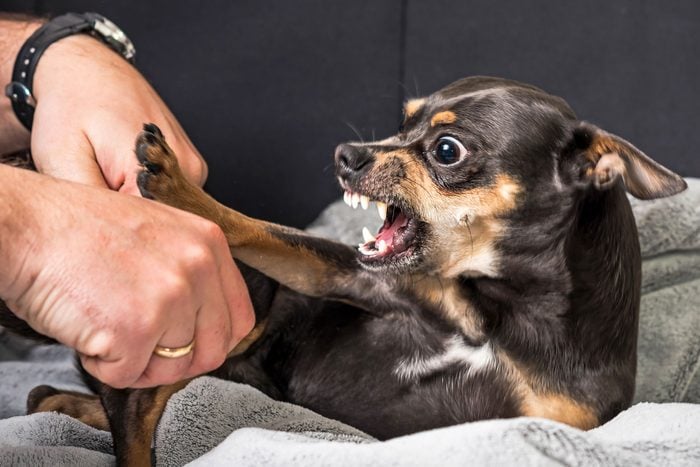
When dogs are truly angry, they might threaten you or even attack you. Such a dramatic response will occur if you push dogs past what they can handle—maybe you steal a hungry dog’s food or force physical contact (like grooming or pats) on a dog experiencing pain. Even actions you think are benign, such as patting a dog on the top of the head or staring, could lead to anger because they’re considered rude in dog language. Different dogs have different triggers for their anger.
But what does that aggressive anger look like? It can range from lunging at the source of anger to warning you off with a low growl. Although some dogs growl when they play, most dogs also use growling to say, “You’re making me uncomfortable. Please stop!” The more you understand dog vocalizations and canine body language, the better you’ll be able to recognize your dog’s frustration and rage.
Shikashio advises looking for forward-facing ears, hard staring (a gaze fixed on the target) and an agonistic pucker (corners of the lips pulled forward into a C shape and teeth bared).
But there are other signs of anger as well. “Their weight shifts forward, [their] front and rear legs usually stiffen and go straight, their spine is in straight alignment and their tail is often high and flagging,” he says. “Rapid-fire, kind of staccato barking is another sign the dog might be experiencing rage or anger.”
The signs aren’t always that cut and dried, though. “It is not always that simple to differentiate,” Dr. Denenberg says. “Dogs may experience multiple emotions simultaneously.” Just as you might experience excitement and fear at the same time, for instance, an anxious dog might be angry about being forced into a scary situation.
Avoidance
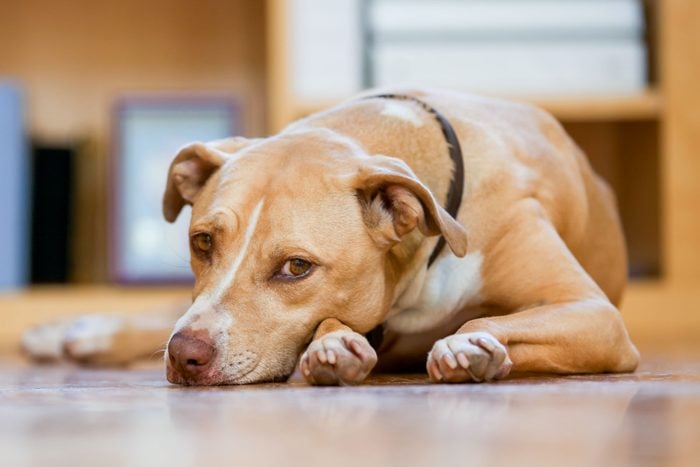
Angry dogs aren’t always aggressive. Instead of barking or growling when mad, some dogs might simply avoid you. You might see pooches turn their heads, sniff the ground or otherwise disengage. Or it might be more obvious: Your dog walks away or right out of the room.
Don’t just assume avoidance indicates anger, though. These behaviors could also be a response to stress—for example, if you yell at or punish your dog. Or your dog may simply want some quiet time alone.
To determine your dog’s motivation for avoiding you, consider the situation that instigated it. Did you do something to annoy your pet? Or have you done something frightening? Look at the accompanying body language: Are there signs of stress, like pulled-back ears, yawning or a tucked tail? Or is your dog tuning you out? By examining the whole package, you should be able to tell if your dog is angry or feeling another emotion.
How to respond to your dog’s anger
When your dog expresses anger, it’s important to empathize. After all, anger is a natural emotion for both us and our dogs. And just as reacting with anger to another person’s rage isn’t the most effective course of action, you shouldn’t respond to your dog’s anger with further conflict. Don’t yell at your pet or use physical confrontation. This will only escalate the situation and put your dog in a defensive position, which can lead to aggressive behavior such as snapping or biting. You could also make your pet fearful of you, thereby eroding your bond.
Think like a dog
Shikashio suggests self-reflection as a starting point. “Ask, ‘Why would my dog need to feel anger or rage toward me or somebody else?’ And it’s typically because of what we’re doing,” he says. “It’s hard not to take offense to that, especially if we’re the ones feeding the dog. You can be like, ‘How dare you bite the hand that feeds you?’ But it’s just a very normal, basic emotion that all of us can experience.”
Not only do you need to know how to read dog communication, but you must also understand your dog specifically. “It’s essential to understand that there are large individual differences among dogs, and we must learn and appreciate these differences, even among littermates and older siblings,” Bekoff says. “To be able to figure out what a dog is feeling, we need to be fluent in dog—become dog literate—to be able to read them accurately and do what they need to reduce their anger.”
De-escalate the situation
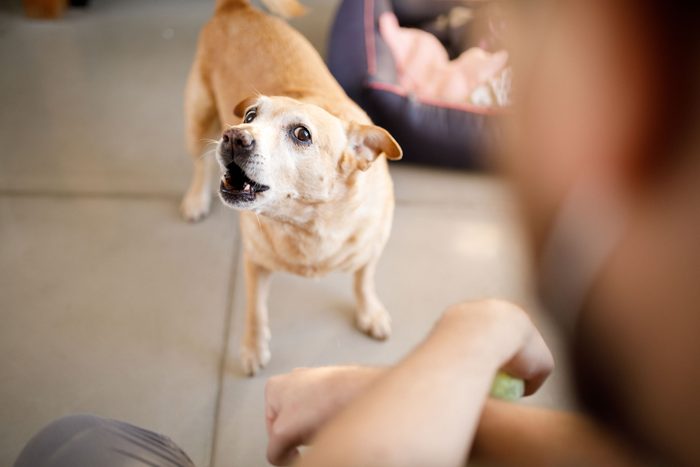
In the short term, Dr. Denenberg recommends putting safety first. If your dog is expressing anger through aggressive behaviors (such as growling or barking) or is threatening you, stop what you’re doing and give your pup some space. That might mean moving away from your dog and/or trying to stop the situation from escalating. Forcing your attention or a certain set of circumstances on your dog puts you at risk.
If your dog isn’t aggressive but has chosen to avoid you, simply wait. Dogs tend to live in the moment, so you likely won’t have to wait long for the anger to subside. Give your dog at least a few minutes to calm down, and the next thing you know, your loving pet will be back at your side. From a human perspective, you might call this forgiving and forgetting.
Feel free to cuddle dogs or offer them treats when their anger has passed, especially if it makes you feel better. It serves as an apology of sorts, but your dog will just be happy the incident is in the past.
Teach alternative responses
Once safety is established and your dog has calmed down, it’s time to analyze the situation. Identify what triggered the anger so you can try to avoid similar situations in the future.
Just know that you can’t avoid every trigger. For example, if your dog gets mad at the groomer’s, you can’t avoid grooming forever. Therefore, it’s a good idea to teach your dog how to cope with those triggers and respond with more positive emotions.
You might try counterconditioning, pairing the trigger with something the dog loves, like chicken or freeze-dried liver. This will slowly change your pup’s emotional response to the situation from something negative, like anger, to something positive, like anticipation of a treat.
You can also try response substitution. With this technique, you’ll teach your dog an alternative response to the trigger that you can then reward with a treat or other item the dog loves, like a game of fetch. For example, if your dog gets angry when you approach the food bowl, teach your pet to lie down on a dog bed at mealtime so you can pick up and fill the bowl undisturbed before calling your dog over to eat. With consistency and repetition, your pooch should learn to offer that response.
“It is about setting dogs up to succeed,” Dr. Denenberg says. “Owners can also work on desensitizing the dog to a particular situation, which is done under ideal conditions before the dog is triggered. Lastly, environmental and routine management can help by avoiding the situation.”
Why trust us
At Reader’s Digest, we’re committed to producing high-quality content by writers with expertise and experience in their field in consultation with relevant, qualified experts. For this piece, Stephanie Gibeault, MSc, CPDT-KSA, tapped her experience as a certified professional dog trainer and journalist, and then Wailani Sung, DVM, a vet who owns Bay Area Vet Behavior, gave it a rigorous review to ensure that all information is accurate and offers the best possible advice to readers. We verify all facts and data, back them with credible sourcing and revisit them over time to ensure they remain accurate and up to date. Read more about our team, our contributors and our editorial policies.
Sources:
- Marc Bekoff, PhD, professor emeritus of ecology and evolutionary biology at the University of Colorado in Boulder and author of several books, including Dogs Demystified: An A-to-Z Guide to All Things Canine and The Emotional Lives of Animals; email interview, March 25, 2024
- Sagi Denenberg, DVM, veterinary behaviorist at North Toronto Veterinary Behaviour Specialty Clinic; email interview, March 29, 2024
- Michael Shikashio, CDBC, certified dog behavior consultant and founder of the Aggression in Dogs Master Course; video interview, March 29, 2024
- Frontiers in Neuroscience: “Selected Principles of Pankseppian Affective Neuroscience”
- Psychological Science: “Dogs Mentally Represent Jealousy-Inducing Social Interactions”
How many times have you been relaxing and reading on a lounge chair by the beach or pool, struggling to find a comfortable position? Let alone an even tan. Enter the Ostrich beach chair.
This comfy chaise lounger features arm and head slots for easy reading, lying on your stomach or back. It’s so comfortable, that I’ve fallen asleep in it (on numerous occasions). It’s lightweight and easy to transport with a convenient carrying strap.
What is the Ostrich beach chair?
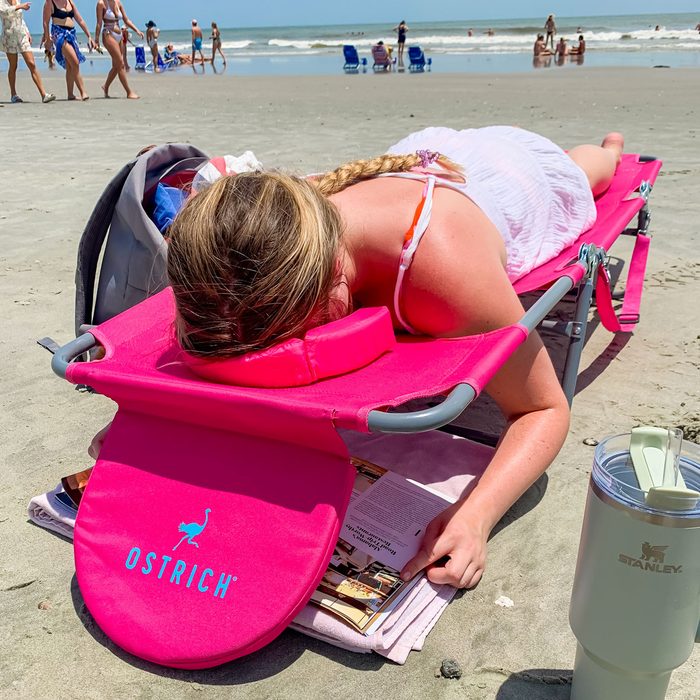
The Ostrich beach chair has been all over my TikTok feed. Thousands of five-star Amazon reviewers rave about this versatile lounger. I spend hours at the beach every weekend, so comfort is my top priority—after sun protection and hydration, of course. And nine times out of 10, my nose is buried in a book.
The Ostrich beach chair features a patented “bury your head” face hole with a pop-in, pop-out pillow pad and easy-reach arm holes that make lying face-down comfortable. Think; a massage chair for the beach. Read a book, tan your back, watch Netflix, scroll on your phone and sip from your go-to tumbler through a straw poolside or at the beach.
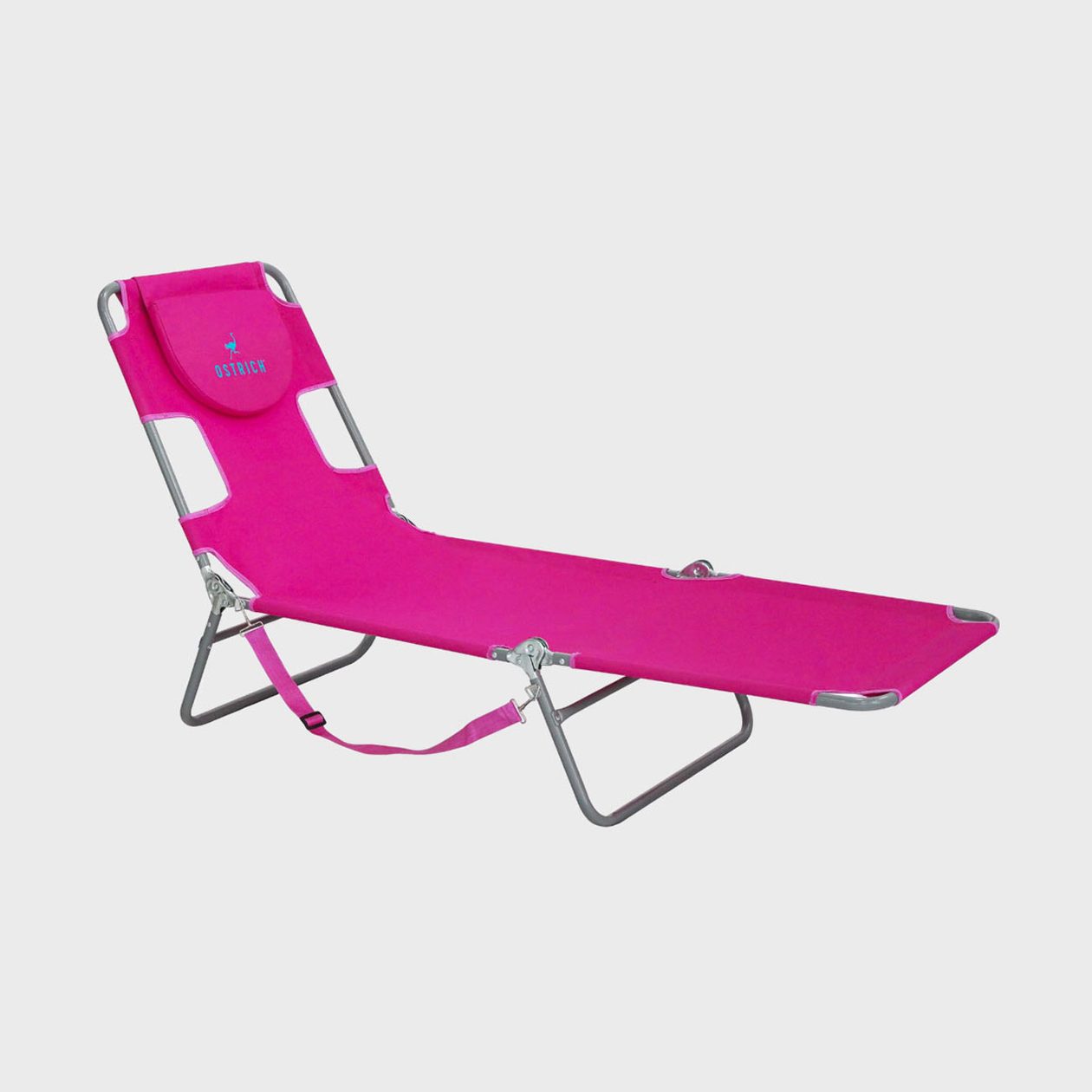 VIA MERCHANT
VIA MERCHANT
I Tried It
Ostrich Beach Chair
If you read or tan, you need the Ostrich beach chair for maximum comfort. It features face and arm holes that make lying face-down comfortable.
Ostrich beach chair features
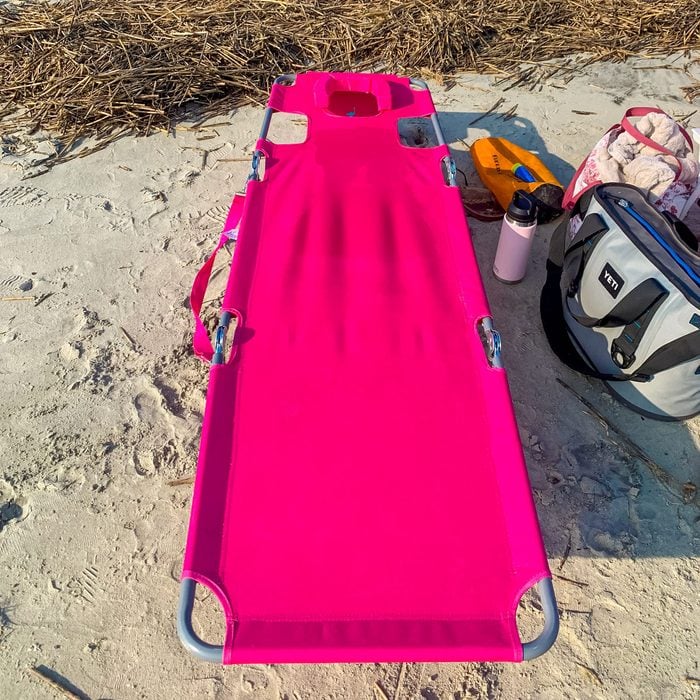
This chaise lounger is portable and lightweight at 9.8 pounds. Despite easy portability, the Ostrich beach chair is shockingly durable with a stainless steel frame and polyester body that holds up to 250 pounds. I’m not surprised that it has so many perfect reviews on Amazon. When first opening the chair, open the legs all the way. Otherwise, it’ll collapse when you attempt to sit.
The Ostrich beach chair might as well be a cot, unfolding to a full-size chaise lounger at 72 inches long. Elevate your feet and keep them out of the sand. This beach chair is quite large, but it’s lightweight and easily transported with a handy carrying strap. It transitions from chair to cot and folds up and packs away in seconds. Now, that’s a TikTok product worth purchasing!
While I enjoy the cot-length lounging setting for tanning, reading and napping, the Ostrich beach chair reclines to four different positions. Alternating between a few reclining settings, I often work outside in the backyard on my laptop. It’s that comfy.
Have you ever seen anything like it? I’ve been amazed since the first lounge. My beach days aren’t complete without my favorite swimsuit and the Ostrich beach chair.
How I tested it

As a Charleston, South Carolina resident, I’m an avid beach-goer. I use my Ostrich beach chair nine months out of the year, at the beach and in my backyard. Over the past 12 months, I’ve put this beach chaise to the test, lounging almost daily. It’s seen sand, salt water and all the elements. (I accidentally left it outside during a hurricane, and it’s still going strong.) I’ve owned several of the best beach chairs, and this one tops my roster.
Pros
- Padded face hole and pillow for reading and tanning
- Features arm holes
- Portable and lightweight
- Convenient carrying strap
- Comfortable and sturdy
- Folds easily
- Recline to four different positions
- 10 color options
Cons
- No cup holders
FAQ
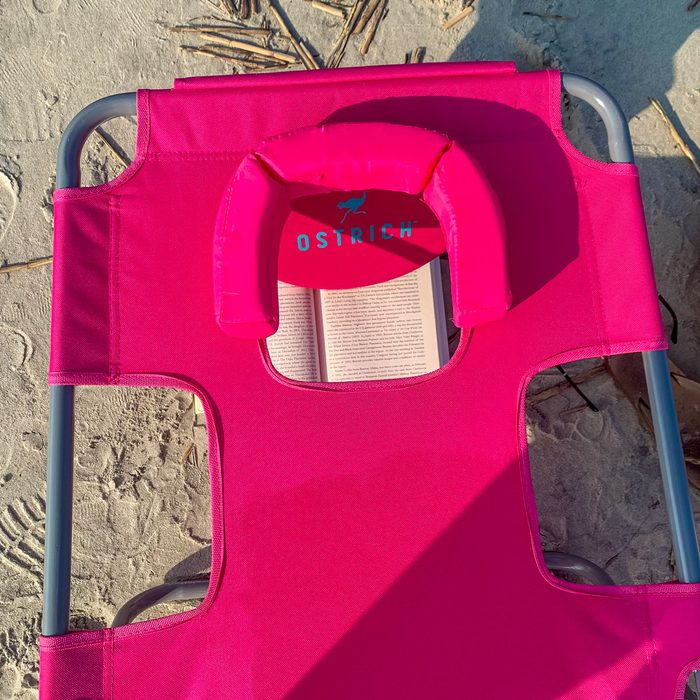
What kind of chair is best for the beach?
Why are beach chairs so close to the ground?
A low center of gravity increases a beach chair’s stability, which is extra important on uneven sandy terrain. It’s easier to get out of a chair that’s lower to the ground, and there’s extra wind protection. Comfort is another factor. The Ostrich beach chair sits 12 inches off the ground.
What other reviewers had to say
From over 18,000 ratings on Amazon, the Ostrich beach chair has earned an average of 4.3 out of five stars. Here’s what people are saying about the summer chair for avid readers:
“This is the perfect summer chair for readers!” says Becky Eisenbraun, a verified purchaser. “The arm holes are positioned perfectly, the face cushion makes the stomach laying so comfortable! The chair is great quality!”
“Super lightweight and easy to fold up!” writes five-star reviewer, Amber Post. “The color is so much prettier in person and it’s so incredibly comfortable! I tested it out in the middle of my living room and ended up falling asleep! Definitely worth it.”
“I had no idea this product existed, but was thrilled when I found it on Amazon!…I love it. It is exactly what I was looking for…Added bonus, my doggie, realized he can get to me if he goes under, so he’s always under there looking for kisses. Win-win,” says verified buyer, Tammy Humphries.
Final verdict
The Ostrich beach chair allows you to lie comfortably regardless of your lounging position. Ostrich strategically designed this lounger with face and arm holes near the head, so I can place my arms and face toward the ground while devouring my latest read (below the chair) while tanning my backside.
I’m shocked at just how comfortable the Ostrich chaise lounge really is. I’ve fallen asleep in this chair on a few occasions and tune out the world when I get absorbed in my book. When ready to tan my front, I flip the cushion back over the face hole for a padded pillow.
If you’re an avid reader or struggle to tan your back, the Ostrich beach chair belongs in your arsenal of beach essentials.
Where to buy the Ostrich beach chair
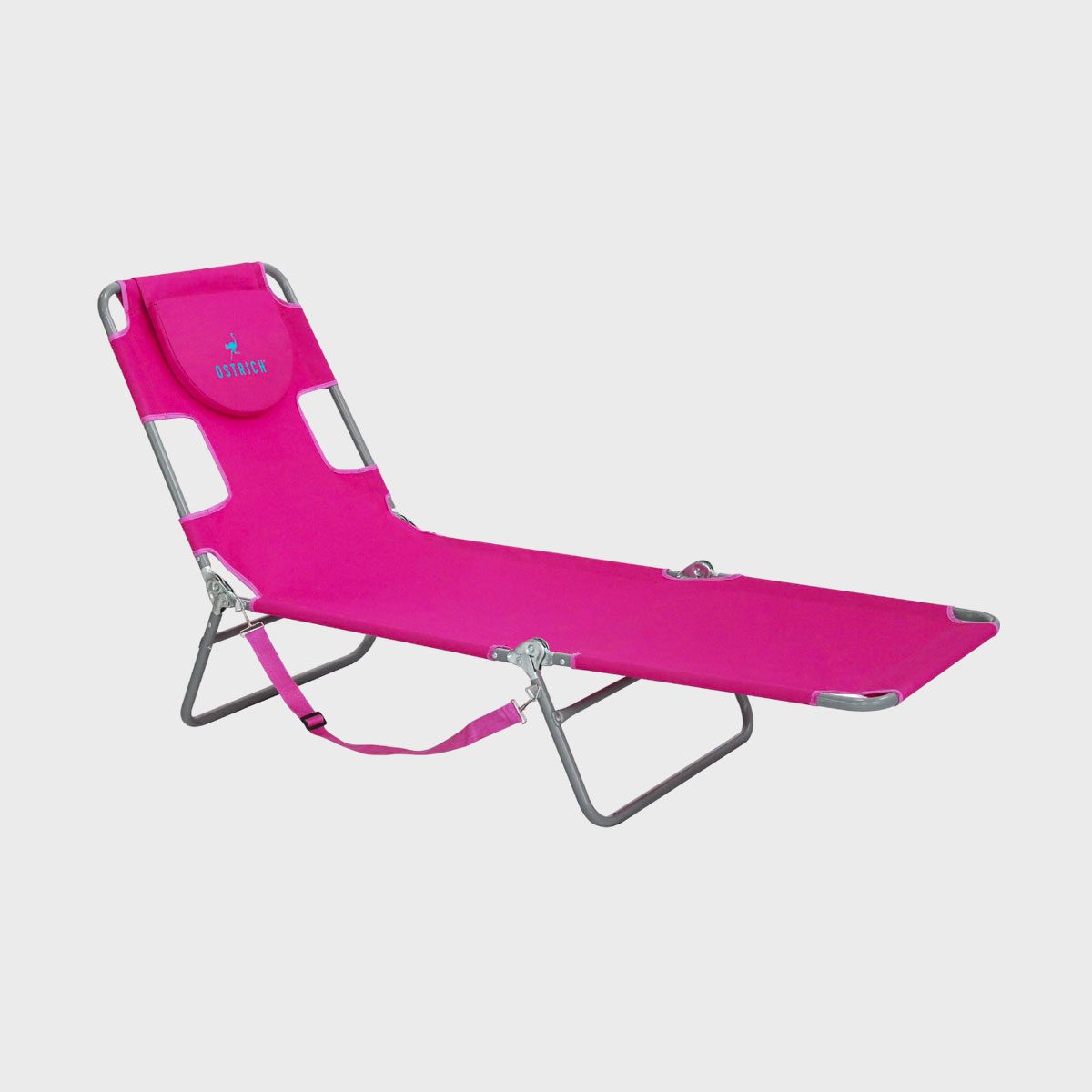 VIA MERCHANT
VIA MERCHANT
I Tried It
Ostrich Beach Chair
You can easily transport the Ostrich beach chair with its carrying strap—and then you'll be comfortable lying in the sand.
The Ostrich beach chair retails on Amazon for $67.95 to $104.99, depending on which of the 10 colors you choose. You can also shop this chair on Walmart and Wayfair. This beach chair is a complete game-changer for lounging in the sun. Act fast—TikTok makes the Ostrich lounger a consistent sell-out.
You come home from a long day of work, exhausted but thrilled to see your dog wagging his tail and looking up at you with big, expectant eyes. But when you drop to your knees and give your dog a big squeeze, he can’t wait to get away from you. What just happened? If it seems like you’re annoying your dog, that’s because you are!
I have been a veterinarian for nearly 15 years, so I deeply understand dogs and dog behavior, but even I have made the mistake of going in for the hug. Hey, I’m only human! The thing is, while we all want to shower our dogs with love and affection, our version of that may not match up with theirs.
While I’m well versed in this topic, I also spoke to fellow veterinarian Karen Todd-Jenkins, VMD, who has more than 30 years of experience, to get her perspective. Together, we will tell you exactly how you’re accidentally annoying a dog—yours or someone else’s—and provide alternate suggestions that will make them a lot happier.
Get Reader’s Digest’s Read Up newsletter for more pets, cleaning, humor, travel, tech and fun facts all week long.
About the experts
|
You stare at them
It’s not your imagination: Your dog stares at you all the time. It helps him learn your habits and quirks, promotes bonding and even communicates his needs, such as wanting food or needing to go outside. So it’s OK to stare back, right? Nope! A hard stare can annoy a dog, at best, and make it feel threatened, at worst. “Staring is confrontational for dogs and can be misinterpreted as a sign of aggression,” says Dr. Todd-Jenkins.
While it’s OK to briefly return a stare if your dog approaches you and looks into your eyes, don’t do it for more than a few seconds. Also make sure it’s a soft, loving gaze. In fact, this type of interaction is a good thing, prompting the release of oxytocin in both of you, which triggers warm and fuzzy feelings and ultimately strengthens your bond, according to a study published in Science. Whatever you do, though, “do not turn the gaze into a staring contest,” says Dr. Todd-Jenkins. Even if you don’t hold your dog’s gaze for long, you can also show your affection by briefly petting them.
You hug them
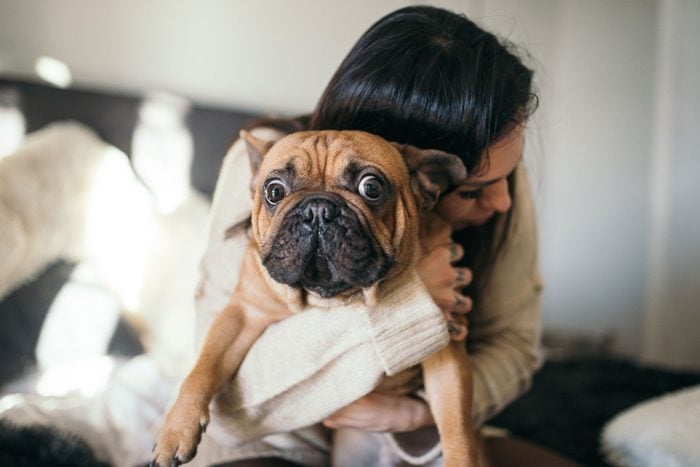
Yes, we hug our human friends and family, but I’m sorry to say that dogs generally don’t love this kind of love. Some dogs don’t mind a brief hug, but for others, “a hug can feel like being restrained, which can have negative connotations,” says Dr. Todd-Jenkins. The key here is to read your dog’s body language. If your pup rushes into your arms, that short hug is OK, but let go immediately if your dog starts wriggling or otherwise seems like he wants to be released. You also shouldn’t pursue a hug if your dog hasn’t initiated one, adds Dr. Todd Jenkins, since it could seem like you’re chasing him, which can annoy or agitate him.
You tease them with toys
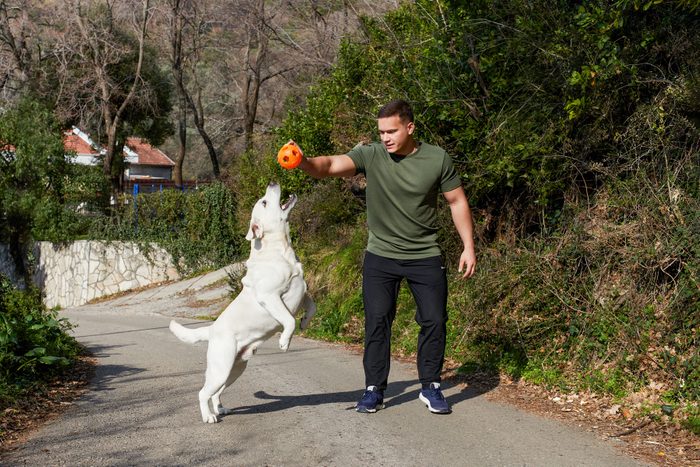
Have you ever done a fake throw of a Frisbee or ball with your dog? This sort of teasing may be funny to you, but it’s annoying to a dog. Why? Because dogs don’t think like us. They don’t understand that teasing and playing pranks can be fun and harmless. Your dog just wants to enjoy playtime with you, which, in their eyes, means that you throw them the ball so they can fetch it. Period. If you tease a dog during playtime, he may not trust you as much, which will weaken your bond.
Rather than teasing your dog, throw the ball or Frisbee whenever you make the throwing motion. If you offer your dog a toy during playtime, let him have it instead of snatching it away as he reaches for it. (Of course, this is different than a good-natured, mutually enjoyable game of tug-of-war.) By not teasing, your dog will continue to trust you, just like he trusts you to feed him when he’s hungry, let him outside to go the bathroom and take care of him when he’s injured or sick.
You talk too much
Dogs make great listening partners. When I was a kid, I would spend many nights sitting next to my 85-pound Lab mix and talking about whatever came to mind. He could have been asleep, but I imagined he was listening to and hanging on my every word. In reality, dogs understand very few of the words we say. If you talk to your dog in a normal tone of voice and launch into a lecture about why he shouldn’t do a particular behavior, like jumping up to greet someone, he simply won’t get it. And he’ll be confused and annoyed, especially if you’re clearly annoyed. While your dog will appreciate that you’re not yelling at him, he’d rather not hear you drone on, saying a bunch of words he just doesn’t understand.
Instead, be brief and use words that you know your dog understands, such as “sit,” stay” or “down.” Also, train your dog to learn and follow basic hand signals.
You talk too loudly
Talking loudly isn’t easy on anybody’s ears, and our dogs don’t like it any more than we do. To our dogs, this sounds like loud, annoying barking, not actual words. “Most dogs have a relatively limited vocabulary,” explains Dr. Todd-Jenkins. “They’re probably not understanding your words and have no idea why you’re [doing this].” And annoying can turn scary if you yell at your dog. In this case, says Dr. Todd-Jenkins, “your dog is reacting, possibly in fear, to your nonverbal cues, like your tone of voice, body posture and gestures.” In that case, your dog might cower or hide under the bed.
In general, remember that your dog’s ears are sensitive, so take it down a notch. Yes, even if you’re just having a good time. And if you are yelling at your dog, stop—you won’t get the result you’re looking for. “A better way to communicate what you want is to reward good behavior when it happens,” says Dr. Todd-Jenkins. “That way, the dog has a reason to exhibit the good behavior again.”
You’re inconsistent with routines
Dogs are happiest when they have predictable daily routines. They like knowing when to eat, play, sleep and greet you at the door. Inconsistent routines don’t allow your dog to know what’s happening when, and while your dog won’t necessarily give you the side eye to show he’s annoyed, he might start behaving badly. In fact, a study published in 2021 in Applied Animal Behaviour Science found that changes in routine were related to dogs chewing on objects. Or if your dog has no idea when you’re going to take him outside, he might start having accidents in the house.
The bottom line, says Dr. Todd-Jenkins, is that “life can be stressful for your pets when their schedules are inconsistent or unpredictable.” Instead, establish and maintain a daily schedule that works for you and your dog. With more predictability, your dog won’t act out quite as much.
You change the rules
Do you let your dog lounge on the couch on a regular day but forbid this behavior when you have guests over? Not a good idea. Changing the rules is annoying to a dog because you are being unclear about how he should behave in different situations. In the moment, your dog will probably look at you quizzically, with his head cocked to the side, waiting for you to give him clear direction on what to do. If you don’t, he might leave the room or go to his bed, deciding it’s not worth the trouble to figure out why you changed the rules.
As with routines, keep your rules consistent, no matter the situation, so your dog can feel confident about how to behave. In a multiperson household, ensure that every household member knows and enforces the rules for your dog. For example, if you have a rule that your dog can’t eat table scraps, make sure no one sneaks a morsel of food to your dog at mealtime.
You leave your dog alone for too long
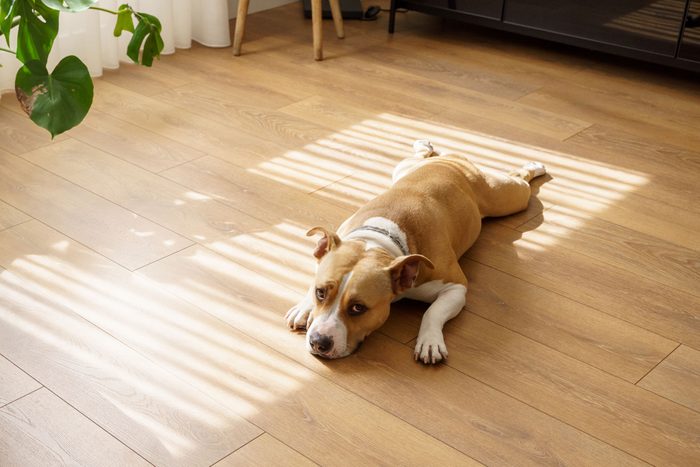
If you work outside the home, it’s hard not to leave your dog alone for a long time. Dogs are social creatures, so spending hours alone can be boring and annoying … which may lead to destructive behavior to pass the time. As a result, you may come home to chewed-up couch cushions or pee on your carpet. Trust me, they’re not happy about this either!
How can you work around this? Consider hiring a dog walker to keep your dog company during the day. Independent enrichment activities, such as food-puzzle toys, can also keep your dog happily entertained until you come home.
You interrupt your dog’s sleep
Just like we can feel annoyed or disgruntled when someone wakes us up from a sound sleep, our dogs don’t appreciate having their sleep interrupted either! If you wake up a dog suddenly, he will be disoriented and confused, wondering what the heck just happened. He will also be grouchy and probably not in the mood to hang out with you, at least until he’s fully awake.
But this is more than mere annoyance—ample sleep is a serious doggy need. Those zzzz’s provide rest and recovery from vigorous play or exercise, gives their brain time to process the day’s events and helps keep their immune system in good working order. For that reason, dogs sleep a lot: Puppies need about 18 to 20 hours of sleep per day to support healthy growth and development, while adult dogs generally do well on about 12 hours of sleep per day.
The bottom line: If your dog is sleeping and enjoying a good dream, let them sleep and wake up naturally.
You rush through your dog’s walks
“Dogs explore their world largely through scent,” says Dr. Todd-Jenkins. “Being outside allows them to experience and engage with their environment more than they would if they weren’t allowed outside of the house.” Plus, after a day of being cooped up, they’re bursting with energy and ready for both socializing with other dogs and spending quality time with you.
How could they not be annoyed if you’re rushing them through the best part of their day? That blade of grass tells them a whole story, not just about what’s happening now but also about what happened in the past. Stretching their legs feels so good. And they get to hang with their favorite human. Rather than rush, move at your dog’s pace and let him sniff and explore to his heart’s content. Schedule this time into your daily schedule so you don’t skimp on it.
You dress up your dog
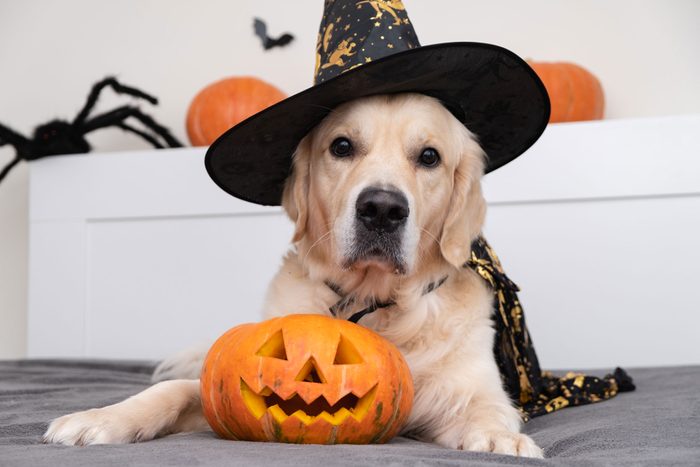
“I can’t say I’ve ever met a dog that looks forward to dressing up—most dogs I’ve encountered just tolerate it,” says Dr. Todd-Jenkins. Although playing dress-up with your dog may give you some Instagram-worthy pictures, don’t be surprised if your dog is annoyed the whole time, fidgeting and trying to get out of the outfit however they can. (Think: tugging at it, rolling on the floor, etc.)
If you can’t resist the lure of the doggy outfit, “give your dog time to get used to the idea of dressing up,” suggests Dr. Todd-Jenkins. First, show your dog the outfit and let him sniff it; then give him a treat. Next, “put the outfit on your dog for a few seconds and take it right off, followed with another treat. Over time, keep the outfit on for longer periods. Ensure the outfit doesn’t hinder movement, breathing, hearing and elimination.”
If your dog is scared of the outfit or simply refuses, respect your dog’s wishes and find another way to take a cute picture, Dr. Todd-Jenkins advises.
You wear strong fragrances
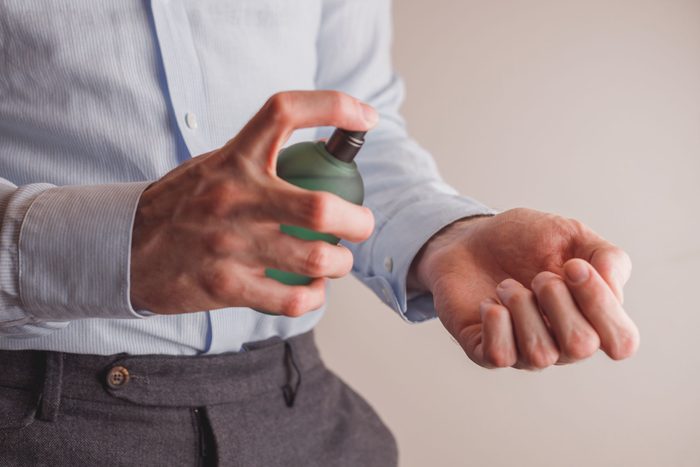
Dogs have hundreds of millions of scent receptors in their noses, so their sense of smell is far more robust than ours. With such sensitive noses, dogs can be annoyed by fragrances that don’t bother us. For example, wearing a small spritz of perfume or cologne could be overwhelming to your dog and even trigger an allergic reaction or tummy upset. And here’s an interesting dog fact: Wearing a strong fragrance hides your natural scent, which your dog uses to recognize you.
If you’re wearing perfume or cologne around your dog, he may distance himself from you to avoid the scent. To avoid offending your dog’s nose or simply confusing him, try not to wear fragrances when you’re spending time together at home.
Why trust us
At Reader’s Digest, we’re committed to producing high-quality content by writers with expertise and experience in their field in consultation with relevant, qualified experts. For this piece on the ways you may be annoying a dog, JoAnna Pendergrass, DVM, tapped her experience as a veterinarian and journalist covering pets, and then Wailani Sung, DVM, DACVB, PhD, a veterinarian specializing in behavioral medicine and the co-author of From Fearful to Fear Free: A Positive Program to Free Your Dog from Anxiety, Fears and Phobias, gave it a rigorous review to ensure that all information is accurate and offers the best possible advice to readers. We verify all facts and data, back them with credible sourcing and revisit them over time to ensure they remain accurate and up to date. Read more about our team, our contributors and our editorial policies.
Sources:
- Karen Todd-Jenkins, VMD, veterinarian and the technical director of the Shepherd Agency; email interview, April 3, 2024
- Physiology and Behavior: “Artificially elevated oxytocin concentrations in pet dogs are associated with higher proximity-maintenance and gazing towards the owners”
- American Veterinary Medical Association: “Human-animal interaction and the human-animal bond”
- Animals (Basel): “Canine olfaction: physiology, behavior, and possibilities for practical applications”
- Applied Animal Behaviour Science: “Chewing behaviour in dogs: A survey-based exploratory study”
If you’re among the millions of Americans who own a dog, you may find it challenging to spend enough time with your furry best friend. And that can cause problems. Despite our best efforts, our dogs can sense when they’re getting only the leftovers of our attention. But what are the signs your dog feels neglected, and how much attention does it need from you?
“Dogs are individuals, so there isn’t a one-size-fits-all answer for how much attention they need,” says Rhiannon Koehler, DVM, a veterinarian at the Humane Society of Greater Kansas City. “Some dogs learn to self-entertain, others enjoy just sitting by you and some demand extended, undivided attention from you.”
As a veterinarian, I am well-versed in dog behavior and understand how dogs use body language, actions and noises to tell us what they want and need from us. By interpreting those signals, we can learn how our actions—from putting off puppy playtime during a busy workweek to leaving the home for long stretches of time—can affect our four-legged friends. Ahead, you’ll discover 10 signs your dog feels neglected, with insights from Dr. Koehler and myself about dogs’ need for attention and how to give them more.
Get Reader’s Digest’s Read Up newsletter for more pets, humor, travel, tech and fun facts all week long.
About the experts
|
Signs your dog feels neglected
Determining if your dog feels neglected takes a bit of detective work. Yes, some dog breeds are more affectionate and attention-seeking than others. And sure, there are common signs your pup needs attention. But like humans, dogs experience and express their feelings in a variety of ways.
That’s why you need to know your pooch, specifically. Consider the following signs your dog feels neglected in the context of its personality, the situation and any recent behavior or health changes.
It’s destroying your furniture
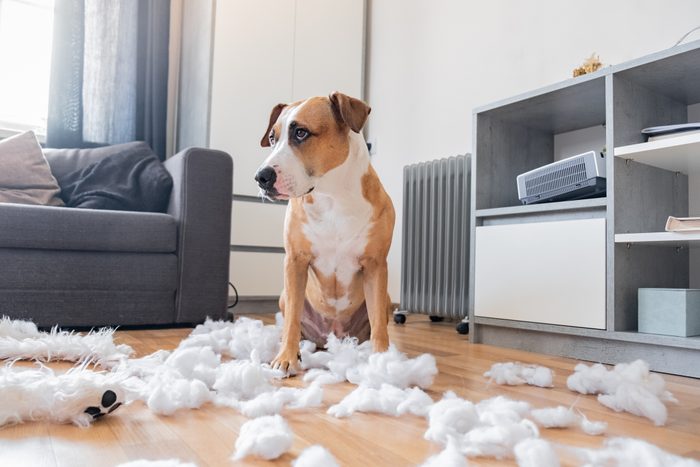
Chances are, you’ve been here before: After a long day at work, you’ve come home to find chewed furniture and doors that have been scratched during an attempted escape. Talk about a hard-to-ignore sign that something’s up with your pup! “Dogs that need more attention can be destructive to your home and themselves,” says Dr. Koehler.
Generally, she explains, dogs shouldn’t be left alone for more than four to six hours at a time. The longer they go solo, the likelier they are to feel neglected and act out. And that’s not just hazardous to your household belongings; your pup could hurt itself too. When dogs are crated and feeling neglected, Dr. Koehler says, they may chew on their crate door so much that they damage their teeth.
Destructive behavior isn’t always a sign of neglect, though. Dogs with separation anxiety can become destructive because they feel distressed when left alone. Other dogs may chew on your prized possessions simply because it’s fun.
If your typically well-behaved dog doesn’t have separation anxiety and is now tearing up your house, it may be telling you that it needs more of your attention.
It has bathroom accidents
When I was growing up, our dog would sometimes poop in the corner of the room when we left home in the evening for a family outing. Has something like this ever happened to you? It’s tempting to think your dog is heaping vengeance on you for being away from home for so long, but that’s probably not the case. Instead, your pup may feel neglected.
When dogs feel like they’re not getting enough attention, their anxiety may increase. That, in turn, may result in more frequent urination and defecation. Your pet may then have an accident in the house. Remember, dogs are not being spiteful but have an urgency to eliminate in your absence.
Of course, there’s another reasonable explanation for bathroom accidents: It might be that your dog simply couldn’t hold it any longer, she says. Dogs with medical conditions like kidney disease or urinary incontinence, in particular, may have more accidents. “If the bathroom accidents are new, take your dog to your veterinarian to rule out a medical condition,” Dr. Koehler advises.
And be mindful of how long you’re leaving your dog home alone—cutting down on its solo time will give it more opportunities for outdoor potty breaks and lessen or eliminate feelings of neglect.
It barks—a lot
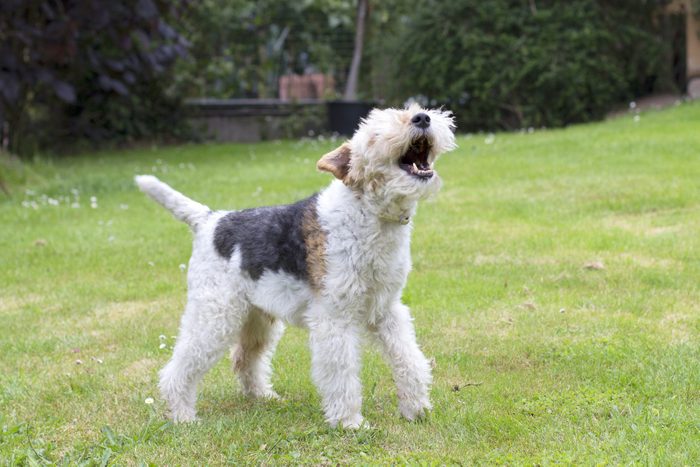
Barking is normal dog behavior and has several purposes, including expressing fear and asking for something. But if your dog is barking more than usual—and specifically at you, not the annoying squirrel outside—it may feel neglected and bark to get more attention from you. “Dogs know how to get your attention, and barking is definitely an effective strategy,” says Dr. Koehler.
She cautions that giving dogs attention when they bark could be a slippery slope. “If you always give your dog attention when they bark, you may unintentionally reinforce that barking has a positive outcome, and your dog may start to bark over little things, like asking for a treat,” she says.
Instead, give your dog more attention during the day, just not as a direct response to the barking. Spending more time with your dog can prevent future attention-seeking barking.
It’s whining and crying
Dogs have been hanging around humans for thousands of years, so they have a keen sense of what to do to get our undivided attention. But while most dog noises give us pause, whining and crying truly have a way of pulling at our heartstrings. When our pets use these sounds to beg for our attention, they may not stop until we give it to them.
Whining and crying could also indicate anxiety or pain, especially if these vocalizations persist despite extra attention. If that’s the case, your dog may need veterinary care to determine the underlying cause and relieve its symptoms.
It sleeps more than usual
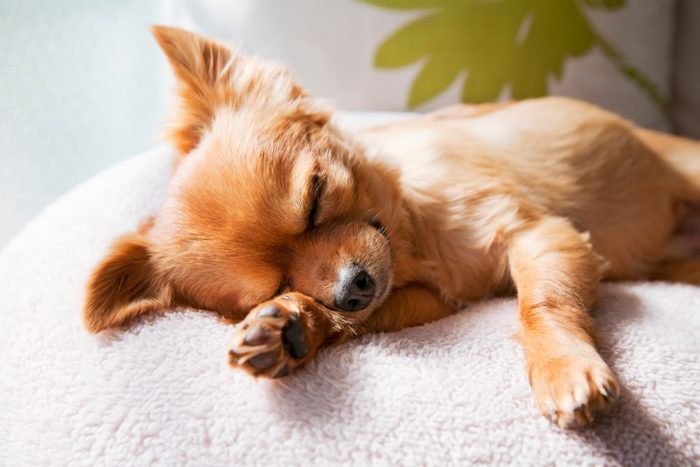
Healthy, happy adult dogs sleep about 12 hours a day, so if that describes your pooch, there’s nothing to worry about. Is your four-legged friend snoozing the day (and night) away? “Some dogs that feel neglected may sleep more than usual,” says Dr. Koehler.
Our dogs rely on us for stimulation, from playtime, walks and cuddles to bones, toys and games. If you’re not paying attention to your dog and it gets bored, it can’t scroll social media or binge its favorite TV show. Without games or activities to keep it busy and active, a neglected dog may opt to curl up and sleep to pass the time. (You would too!)
If your dog is otherwise healthy yet chooses to sleep the day away, find different ways to give it attention, such as with interactive toys and more playtime, which will get their brain working and body moving.
It has gained weight
Canine obesity is a big problem (no pun intended). According to a 2022 survey from the Association for Pet Obesity Prevention, nearly 60% of dogs in the United States are either overweight or obese. Unfortunately, dogs that feel neglected may pack on extra pounds.
“Some dogs that are bored or neglected will eat more as a form of self-entertainment, particularly if they have free access to food,” says Dr. Koehler. If your dog is eating to cope with neglect but isn’t getting enough exercise, it will soon join the ranks of other overweight and obese dogs.
A good solution for both its obesity and attention needs? Increase the amount of exercise your furry friend gets each day. You’ll appreciate the weight loss that keeps your pup healthy, and it’ll appreciate hanging out with its human pal.
It doesn’t eat much
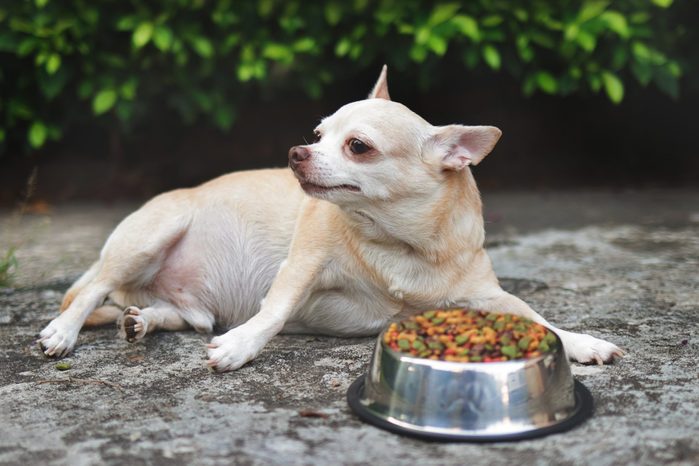
While some pups chow down for self-entertainment, other dogs eat less when they feel neglected. “Much like a person with depression, a dog that feels neglected often has changes to their appetite,” says Dr. Koehler.
Of course, a reduced appetite is also a symptom of many health conditions in dogs, such as digestive upset, so you may have to do some detective work with your veterinarian to determine why your dog isn’t eating much. If neglect is the reason, improving your dog’s mood by giving it more attention may help restore its appetite.
It’s less social
Dogs that feel neglected often don’t feel like being social. They may withdraw from family members and other pets and stop doing the things they used to enjoy, such as going out on long walks or playing with other dogs at the dog park.
To translate this behavior—and determine if it comes from a lack of attention—you need to know your pet. “Some dogs are naturally more introverted and self-sufficient,” Dr. Koehler says. If your dog is usually playful and outgoing but has started to prefer being alone, it may be feeling neglected. You’ll have to put in some time with your pup to see a change in its behavior.
It follows you around
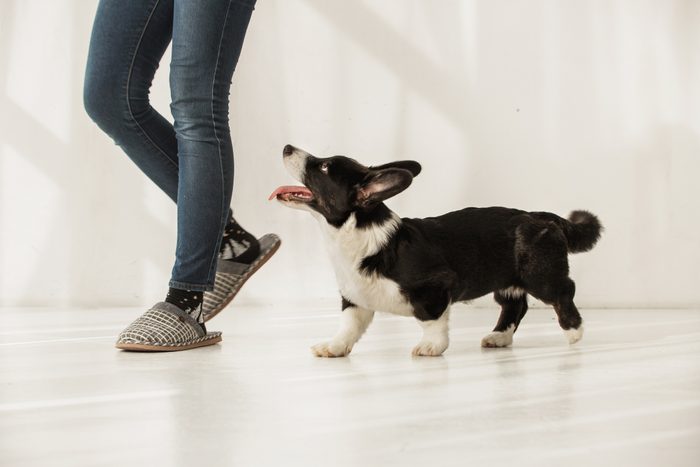
Has your dog become your shadow, following you wherever you go? It could be looking for more attention from you, determined to stay at your side no matter what. If your dog has suddenly started to stick to you like Velcro, consider giving it more of your undivided attention.
This behavior could also be a sign of separation anxiety, so you may want to talk to your vet if paying more attention to your pooch doesn’t stop it from shadowing you.
It shows signs of depression
“Unfortunately, we can’t ask our dogs how they feel,” says Dr. Koehler. But they can become depressed, and dogs that feel neglected may show signs of depression to indicate they aren’t getting enough attention.
Much like human depression, she explains, doggy depression can have vague and nonspecific signs, such as a lack of interest in previously enjoyable activities and changes in eating and sleeping behaviors. Other depressed dogs may become clingier.
How to give your dog more attention
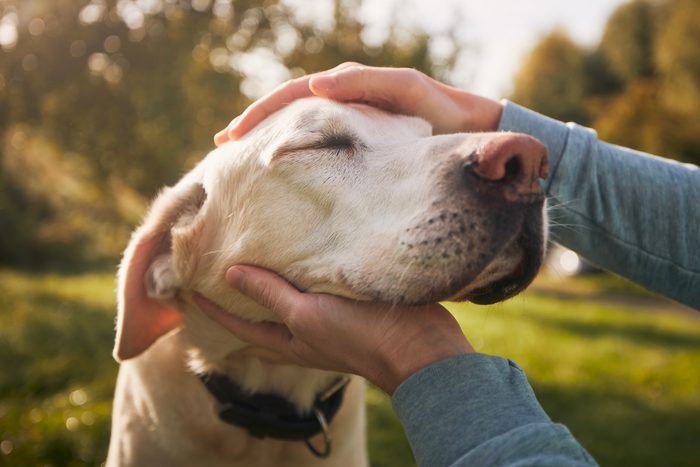
If your dog has made it loud and clear that it is feeling neglected, it’s time to work on giving your dog more attention. Here are some ways to make that happen:
- Schedule consistent, daily playtime.
- Give your dog mentally stimulating toys to keep it occupied when you can’t give it attention.
- Hire a dog sitter or dog walker to spend time with your dog during the day.
- Cuddle more with your dog on the couch.
Your dog needs your attention, but it doesn’t need it all in one big block of time. Any attention you give it throughout the day, such as walks around the neighborhood or a quick game of fetch, will go a long way toward keeping your dog from feeling neglected.
You may notice that these signs of neglect start to disappear as you give your dog more attention. However, if these signs persist despite the extra attention, schedule an appointment with your vet to determine if an underlying medical issue could be the cause.
Why trust us
At Reader’s Digest, we’re committed to producing high-quality content by writers with expertise and experience in their field in consultation with relevant, qualified experts. For this piece, JoAnna Pendergrass, DVM, tapped her experience as a veterinarian and journalist covering pets, and then Wailani Sung, MS, PhD, DVM, DACVB, a board-certified veterinary behaviorist who owns Bay Area Vet Behavior, gave it a rigorous review to ensure that all information is accurate and offers the best possible advice to readers. For this piece, we relied on reputable primary sources, including veterinarians and professional organizations, as well as our writer’s personal experience. We verified all facts and data and backed them with credible sourcing, and we will revisit them over time to ensure they remain accurate and up to date. Read more about our team, our contributors and our editorial policies.
Sources:
- Rhiannon Koehler, DVM, freelance medical writer and small-animal veterinarian at the Humane Society of Greater Kansas City; email interview, April 3, 2024
- Association for Pet Obesity Prevention: “2022 Pet Obesity Prevalence Survey”
- Journal of the American Veterinary Medical Association: “Review of epidemiological, pathological, genetic and epigenetic factors that may contribute to the development of separation anxiety in dogs”
So far this year, I’ve traveled to six countries—and each time I’ve checked a bag. Why? Because I knew my carry-on luggage, including my beloved Béis Carry-On, was designed for domestic flights and too big for international flights. Thankfully, with my frequent flier status, I can check my bags for free, so I wasn’t stuck spending a fortune. But sometimes I want the flexibility and security of having my bag onboard with me—especially after nonstop headlines last year about a record number of lost or delayed bags (ones that never made their connection). Plus, who wants to waste time waiting at baggage claim? Imagine my delight when I learned about the Béis Front Pocket Carry-On Roller international-sized bag, part of its Commuter Collection.
What is the Béis Front Pocket Carry-On?
Designed for early-career professionals and seasoned business travelers alike, the Béis Commuter Collection includes the brand’s first official international luggage: the Front Pocket Carry-On. Not only does it meet (most of) the international sizing restrictions, but it doubles as a briefcase, thanks to the handy front pocket with a laptop pocket.
This bag is smaller than a domestic carry-on, so smart packing is more important than ever. But knowing that space is at a premium, Béis recommends pairing it with the other items in the collection—including The Commuter Tote (which Reader’s Digest also loves), The Commuter Backpack, The ID Crossbody, The Belt Bag and The Duffle—to ensure you have all the space you need for an overseas trip.
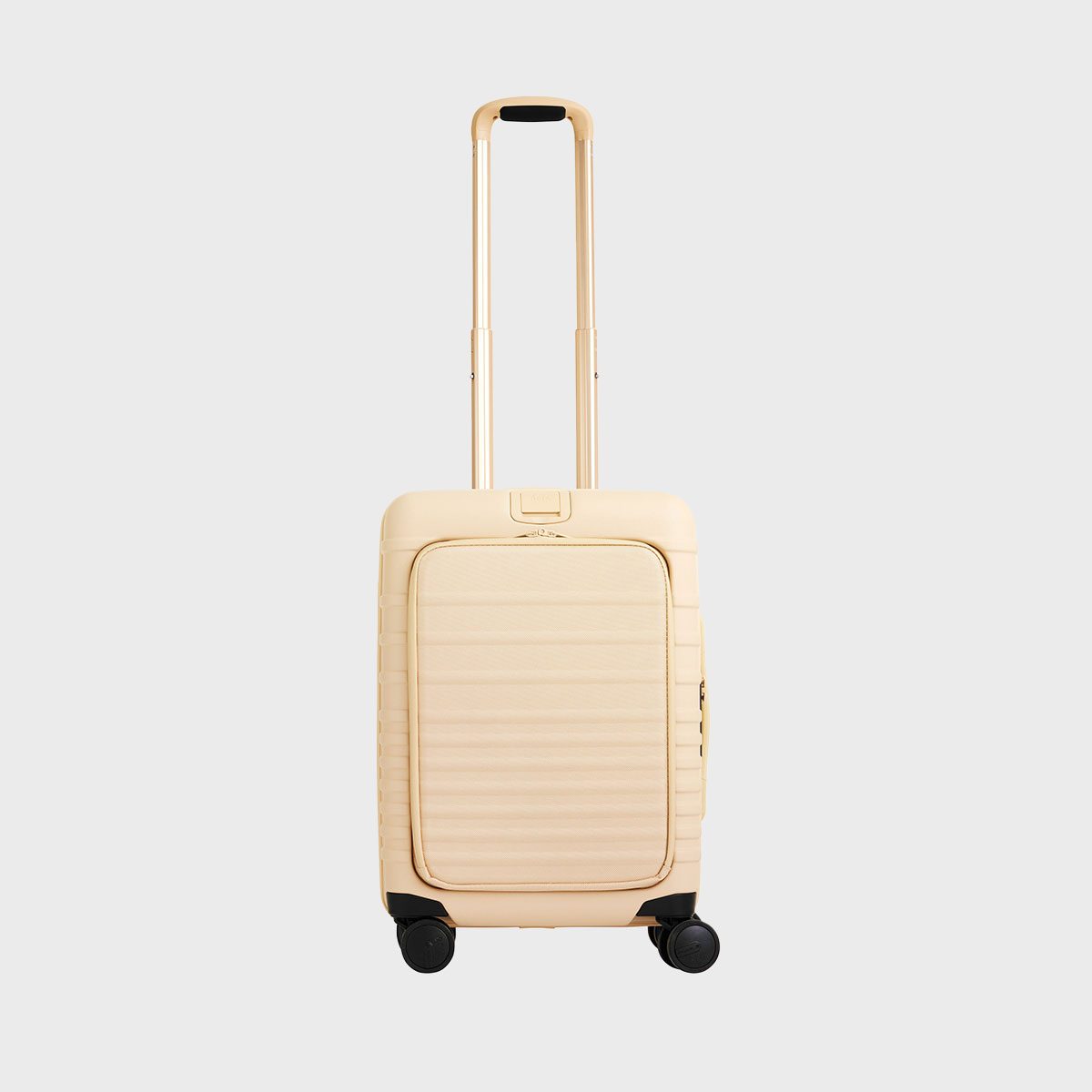 VIA MERCHANT
VIA MERCHANT
I Tried It
Béis Front Pocket Carry-On
Béis has released its first official international luggage for the ultimate overseas travel companion.
Béis Front Pocket Carry-On features
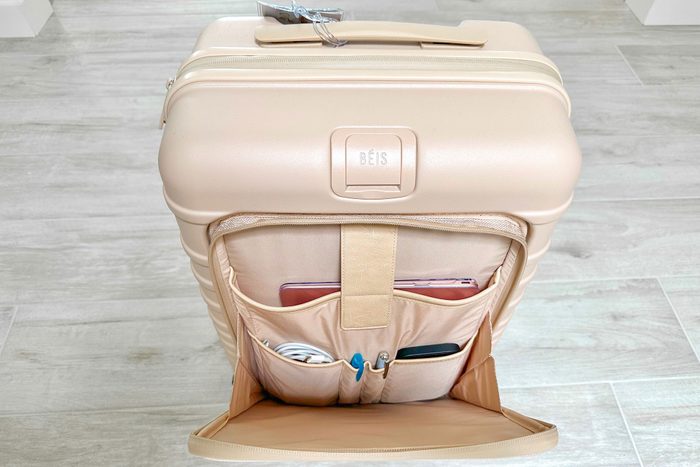
There are many features on the Béis Front Pocket Carry-On to get excited about, most notably the front pocket. It’s a first for Béis and well organized, which makes for super-convenient access to your laptop as there’s a dedicated sleeve. Two pen sleeves and two other open pouches are also helpful for your chargers, phone or snacks. There’s even space for a book.
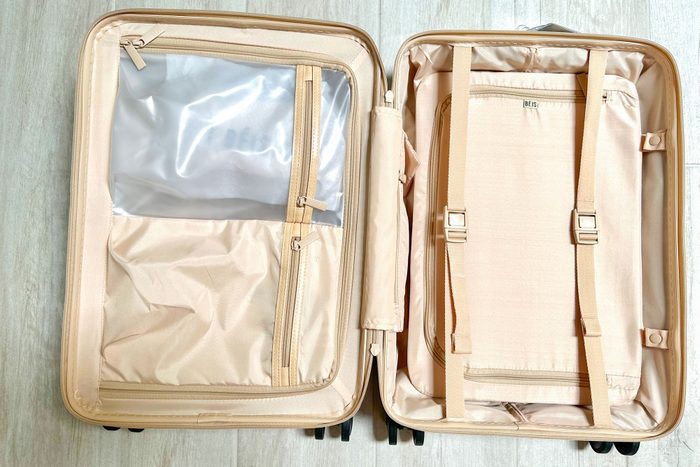
I appreciate all the interior organizational tools—something I found lacking in my Away Bigger Carry-On suitcase. This Béis bag offers two larger pouches and two other zippered areas for separating items and staying organized. And the two drawstring pouches are ideal for dirty clothes, shoes or undergarments.
Finally, the compression strap system really allows you to make the most of your space, especially when paired with packing cubes. I try not to stuff them to the gills on my outbound flight so that I have room for souvenirs on the way home.
How I tested it
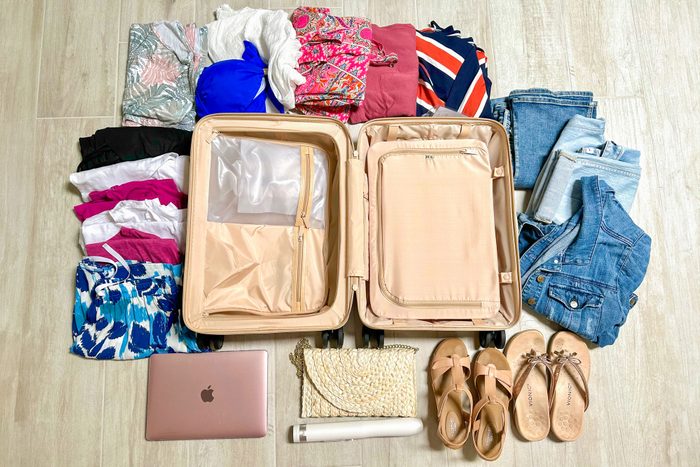
My first trip with the Béis Front Pocket Carry-On was a weekend staycation in the next town over. I was able to fit five shirts, one skirt, two dresses, one pair of pajamas, one bathing suit, one cover-up, one jumper, two pairs of jeans, one jean jacket, two pairs of shoes, one clutch and one tripod inside. Not bad at all, but there was no room for my toiletries bag or any hair tools. My 13-inch laptop fit nicely in the front pocket (I checked and my fiancé’s 16-inch laptop just barely fit), alongside some chargers and other odds and ends. Keep in mind that the front pocket isn’t part of the Transportation Security Administration (TSA) locks, though.
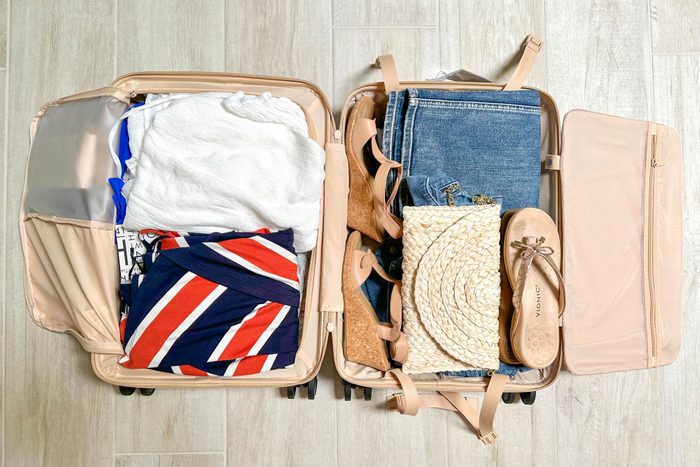
Next, my fiancé and I took a road trip to northern Arizona from our home in Phoenix. We were going glamping at Under Canvas Grand Canyon, and I knew the bag’s chic design and neutral tones would pair well with our natural tent aesthetic. I was able to fit several pairs of leggings and hiking pants, two sweatshirts, a few T-shirts and long-sleeve shirts, undergarments and a small toiletries bag inside. However, I needed to stuff my hiking boots, coat and other glamping necessities into a separate bag (we didn’t bring electronics or hair tools, as there was no electricity at this property).
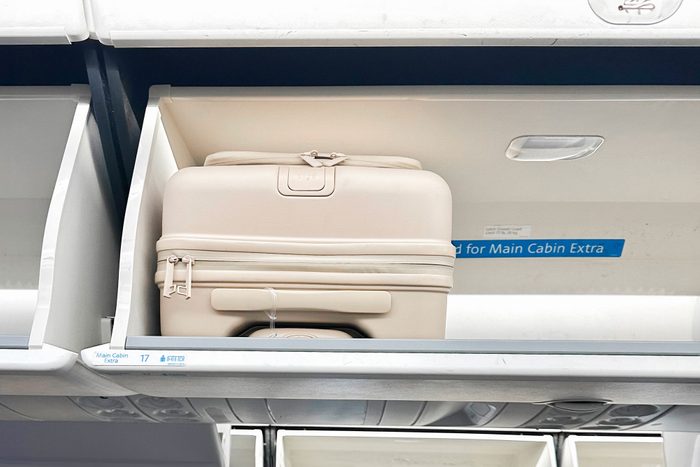
For my third outing with the bag, I took a Cathay Pacific flight from Los Angeles International Airport (LAX) to Hong Kong to Bangkok. Much to my delight, I was upgraded to a lie-flat seat in business class on the way there, so my Béis bag got to enjoy its own first-class accommodations in its own private overhead bin. On the way back home, however, I was stuck in coach and my bag still fit nicely in that shared overhead bin. I was incredibly impressed with the thick padding under the handle, which helped keep my hand comfortable while gliding it around multiple countries and airports.
And finally, I just returned from a Viking River Cruise along the Seine in France, and my Béis bag came along for the journey once again—I purposely kept it half empty on the way there so I could fill it up with souvenirs on the way home. It fit nicely in a shared bin in economy on American Airlines in both directions and held more souvenirs than I had even imagined (there was still room for more!).
Pros
- Front zippered compartment has a laptop pocket, pen pockets, and pockets
- Weight limit indicator
- 360-degree wheels
- TSA locks
- Durable, hard-sided polycarbonate
- Retractable bag with attached strap holds up to 15 pounds
- Separate pouch for dirty clothes
- Four-point compression straps and detachable compression flap
- U-zip pocket with mesh packet
- One-zip pocket, one frosted polyvinyl chloride (PVC) zip pocket and one smaller zip pouch
- Limited lifetime warranty
Cons
- A bit heavier and more expensive than the regular Béis Carry-On Roller
- Only comes in two colors
FAQ
What size is an international carry-on?
As a general rule of thumb, the standard size requirements for most domestic airlines for your larger carry-on is around 22 by 14 by 9 inches. This is true for Alaska Airlines, Allegiant Air, American Airlines, Delta Airlines, Hawaiian Airlines, Jet Blue and United Airlines. Southwest and Frontier Airlines allow for 24 x 16 x 10 inches, giving you a little more room.
By comparison, the following international carriers allow:
Aer Lingus: 21.5 by 15.5 by 9.5 inches
Aeromexico: 21.5 by 15.7 by 10 inches
Air Canada: 21.5 by 15.5 by 9 inches
Air France: 21.6 by 13.7 by 9.8 inches
British Airways: 22 by 18 by 10 inches
Emirates: 22 by 15 by 8 inches (the Béis Front Pocket Carry-On may not fit)
Lufthansa: 21.5 by 15.5 by 9 inches
Qantas: 22 by 14 by 9 inches
Qatar: 20 by 15 by 10 inches (the Béis Front Pocket Carry-On will not fit)
Ryanair: 21.5 x 15.5 x 7.5 inches (the Béis Front Pocket Carry-On may not fit)
Virgin Atlantic: 22 x 14 x 9 inches
Do international airlines allow the Béis carry-on?
Many do, but it may be a bit too large for others, including Emirates, Qatar and Ryanair. Before you travel, it’s a wise idea to double-check with your airline to ensure you’re in compliance, not only with luggage size but the weight limit, too (and that you understand carry-on allowances and any fees).
What other reviewers had to say
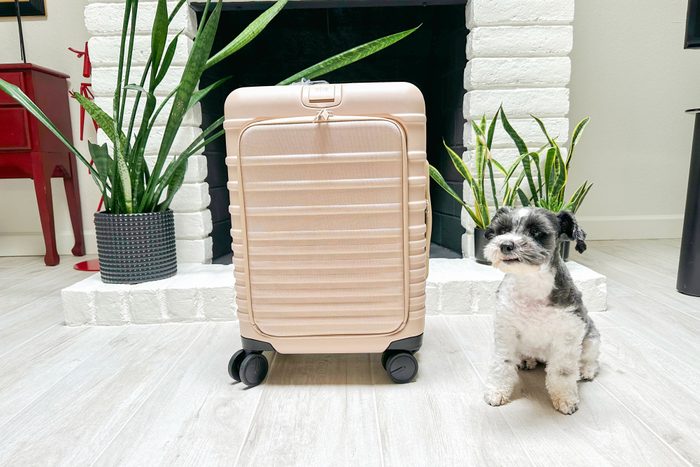
From over 160 ratings on Béis’ website alone, the Front Pocket Carry-On has an average of 4.9 out of five stars. Here’s what real-life shoppers have to say:
One Nordstrom buyer says, “My goodness, I should have purchased this sooner. This carry-on roller is 100 times better than the one I used to have. It packs so efficiently that I had room to spare. I got a Béis backpack to go with it. Both make travel so easy.”
Leslie, a verified buyer on the Béis’ website, says it’s perfect for “hot girl European summer” since she was used to having to gate-check her Béis Carry-On Roller for previous trips with European airlines. “The front pocket was a great lifesaver for last-minute things I had to slip in while packing between hotels and Airbnb. I had no issues with RyanAir or Iberia airlines,” she says.
And Kristin, another Béis verified buyer, writes, “This bag is perfection! It is the correct size for international and domestic travel and I was able to bring it onto several different airlines with zero issues (Lufthansa, Swiss Air, United, American Airlines) and it fits in the overhead compartment. The inside is incredibly well organized and the compression straps are such a game changer! Get it you won’t regret it!”
Product comparison
By and large, this bag is nearly identical to the Béis Carry-On. The only differences are the brilliant addition of the front pocket and the scaled-down size. The Béis Carry-On has a capacity of 49 to 61 liters and the dimensions are 15.7 by 22.8 by 9.8 inches.
The Béis Front Pocket Carry-On measures 13.5 by 21.5 by 9 inches (so it’s a few inches smaller) and has a capacity of just 47 liters. You need to be a strategic packer and committed to living the carry-on lifestyle in order to get away with using this bag as your sole piece of luggage on an overseas trip. It holds several fewer outfits (it’s a great time to lean into a capsule wardrobe), so you may find that you’ll need to do a load of laundry to get through a full week.
Final verdict
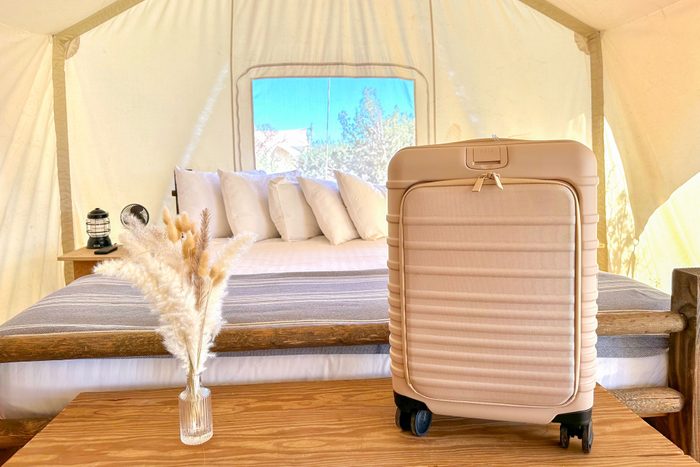
I’ve now taken the Béis Front Pocket Carry-On on trips to Asia and Europe and foresee it coming back to Europe with me again next month. But because I’ve never mastered light packing for multi-week international trips, I’ve been using this bag in conjunction with a larger checked bag. I bring it onboard to hold a couple of extra outfits in case I get delayed while in transit, gear I don’t want to check (like my tripod and binoculars) and a handful of items to make my long-haul flights more comfortable—and I leave extra room for purchases made during my travels.
In my ongoing internal debate about Away vs. Béis luggage, Béis still comes out ahead because of the internal pockets, padded handle and weight limit indicator—though Away does claim that its smallest bag, The Carry On, meets “almost any major airline’s” size requirements, including some international carriers Béis may not.
Where to buy the Béis Front Pocket Carry-On
Once you’ve got your flight booked and your passport ready, all you’ll need to do is grab the Béis Front Pocket Carry-On on the brand’s website, Revolve or Nordstrom for $248.
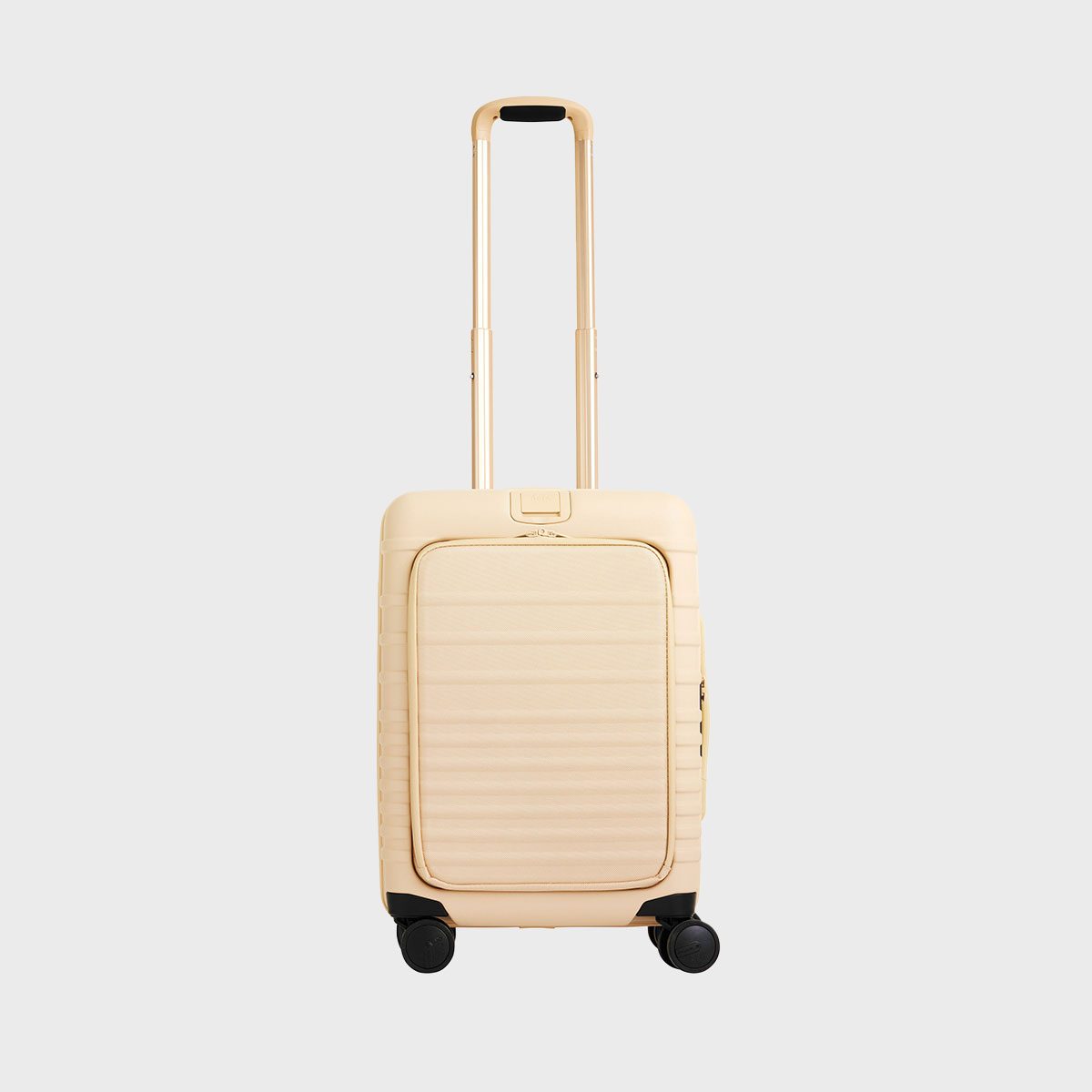 VIA MERCHANT
VIA MERCHANT
I Tried It
Béis Front Pocket Carry-On
This Béis luggage meets (most of) the international sizing restrictions you'll find on popular airlines.
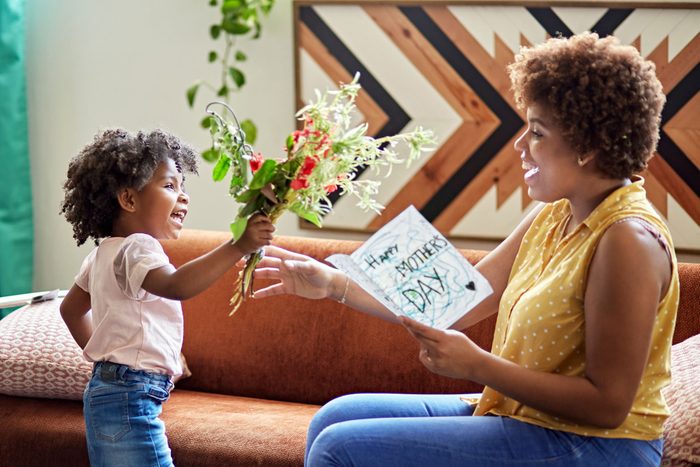
May isn’t just about blooming flowers and warmer weather—it’s a month packed with spring celebrations and appreciation. While many know about Mother’s Day, there’s a whole tapestry of May holidays and observances, from honoring educators during Teacher Appreciation Week to delving into the magical world of Harry Potter on International Harry Potter Day (on May 2, to be exact). And let’s not forget that the Force is strong with Star Wars fans on May 4, as they gear up to fight against the dark side (and enjoy a few punny Star Wars jokes too!).
So check out the many May holidays below—including some surprising monthly, weekly and daily observances—to make the month of May truly unforgettable!
Get Reader’s Digest’s Read Up newsletter for more holidays, fun facts, humor, cleaning, travel and tech all week long.
What are the popular May holidays?
Mother’s Day—which hits the calendar on Sunday, May 12, this year—isn’t the only standout event in May. From Teacher Appreciation Week and the epic clash of lightsabers on Star Wars Day to the enchanting journey through the wizarding world on International Harry Potter Day, there’s something for everyone. Plus, May isn’t just about pop culture; it’s also Asian American and Pacific Islander Heritage Month and Jewish American Heritage Month.
Monthly May observances
- ALS Awareness Month
- American Cheese Month
- American Wetlands Month
- Arthritis Awareness Month
- Asian American and Pacific Islander Heritage Month
- Better Sleep Month
- Bladder Cancer Awareness Month
- Borderline Personality Disorder Awareness Month
- Brain Cancer Awareness Month
- Building Safety Month
- Celiac Awareness Month
- Chip Your Pet Month
- Clean Air Month
- Family Wellness Month
- Fibromyalgia Education and Awareness Month
- Gardening for Wildlife Month
- Homeschool Awareness Month
- International Drum Month
- Jewish American Heritage Month
- Latino Books Month
- Lettuce Month
- Lupus Awareness Month
- Melanoma and Skin Cancer Awareness Month
- Mental Health Awareness Month
- Motorcycle Safety Awareness Month
- National Allergy and Asthma Awareness Month
- National Asparagus Month
- National Barbecue Month
- National Bicycle Safety Month
- National Blood Pressure Month
- National Cancer Research Month
- National Cystic Fibrosis Awareness Month
- National Foster Care Month
- National Hamburger Month
- National Inventors Month
- National Lyme Disease Awareness Month
- National Meditation Month
- National Pet Month
- National Physical Fitness and Sports Month
- National Salad Month
- National Salsa Month
- National Strawberry Month
- National Tennis Month
- National Walking Month
- National Wildfire Awareness Month
- Pet Sitter Safety Month
- Skin Cancer Awareness Month
- Small Business Month
- Tourette Syndrome Awareness Month (May 15–June 15)
Weekly May holidays
- American Craft Beer Week (May 13–19)
- Be Kind to Animals Week (May 5–11)
- Bike to Work Week (May 13–19)
- Children’s Book Week (May 6–12)
- Hurricane Preparedness Week (May 5–11)
- National EMS Week (May 19–25)
- National Nurses Week (May 6–12)
- National Pet Week (May 5–11)
- National Public Works Week (May 19–25)
- National Small Business Week (April 28–May 4)
- National Stuttering Awareness Week (May 13–19)
- National Travel and Tourism Week (May 19–25)
- National Vegetarian Week (May 15–21)
- National Wildflower Week (May 5–11)
- Teacher Appreciation Week (May 6–10)
- Women in Construction Week (May 5–11)
Daily May holidays and observances in 2024
May 1
- Law Day
- Learn to Ride a Bike Day
- Lei Day
- May Day
- National Anxiety Disorders Screening Day
- National Chocolate Parfait Day
- National Interpreter Appreciation Day
- National Loyalty Day
- National Mother Goose Day
- National Skilled Trades Day
- School Principals’ Day
- World Lyme Day
May 2
- International Harry Potter Day
- National Brothers and Sisters Day
- National Life Insurance Day
- National Play Your Ukulele Day
- National Truffle Day
- World Password Day
- World Tuna Day
May 3
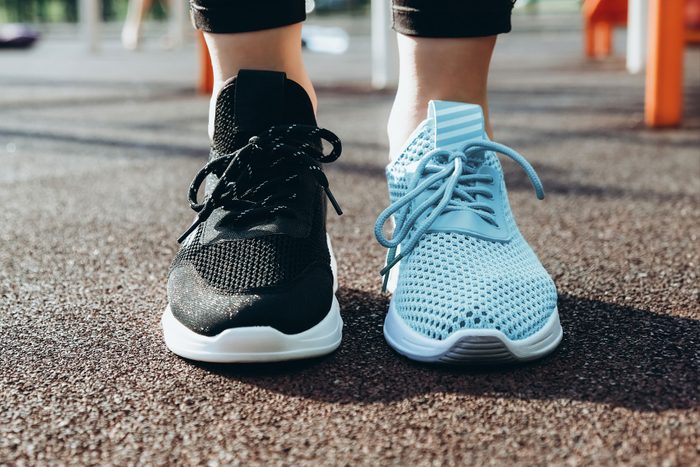
- International Wild Koala Day
- National Anxiety Disorders Screening Day
- National Chocolate Custard Day
- National Garden Meditation Day
- National Paranormal Day
- National Public Radio Day
- National Raspberry Popover Day
- National Space Day
- National Textiles Day
- National Two Different Colored Shoes Day
May 4
- Bird Day
- International Firefighters Day
- Kentucky Derby
- National Fitness Day
- National Orange Juice Day
- National Pilates Day
- National Play Outside Day
- National Renewal Day
- National Scrapbook Day
- National Weather Observers Day
- National Wildfire Community Preparedness Day
- Star Wars Day
May 5

- Cinco de Mayo
- Museum Lover’s Day
- National Astronaut Day
- National Cartoonists Day
- National Hoagie Day
- National Lemonade Day
- Sleep Apnea Awareness Day
- World Laughter Day
May 6
- Melanoma Monday
- Great Lakes Awareness Day
- National Herb Day
- National Meeting Planners Appreciation Day
- National Nurses Day
- National Scrapbooking Day
May 7
- National Asthma Day
- National Barrier Awareness Day
- National Foster Care Day
- National Teacher Appreciation Day
- National Tourism Day
May 8
- National Coconut Cream Pie Day
- National Give Someone a Cupcake Day
- National Have a Coke Day
- National Receptionists Day
- National Student Nurse Day
- Truman Day
- World Ovarian Cancer Day
- World Red Cross and Red Crescent Day
May 9

- Ascension Day
- Make a Book Day
- National Alphabet Magnet Day
- National Butterscotch Brownie Day
- National Children’s Mental Health Awareness Day
- National Lost Sock Memorial Day
- National Sleepover Day
May 10
- Child Care Provider Day
- National Clean Your Room Day
- National Golf Day
- National School Nurse Day
- National Shrimp Day
- National Small Business Day
- Public Gardens Day
- World Lupus Day
May 11
- Brunch for Lunch Day
- National Archery Day
- National Babysitter’s Day
- National Dog Mom’s Day
- National Foam Rolling Day
- National Miniature Golf Day
- National Train Day
- National Twilight Zone Day
- World Fair Trade Day
- World Migratory Bird Day
May 12
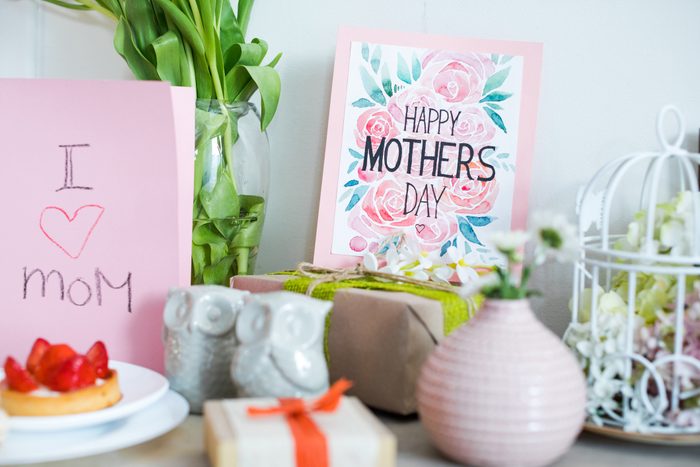
- International Nurses Day
- Mother’s Day
- Myalgic Encephalomyelitis/Chronic Fatigue Syndrome (ME/CFS) International Awareness Day
- National Fibromyalgia Awareness Day
- National Hospital Day
- National Limerick Day
- National Mental Health Provider Appreciation Day
- National Nutty Fudge Day
- World Topiary Day
May 13
- International Hummus Day
- National Apple Pie Day
- National Frog Jumping Day
- National Fruit Cocktail Day
May 14
- Bond With Your Dog Day
- International Chihuahua Appreciation Day
- National Buttermilk Biscuit Day
- National Dance Like a Chicken Day
- National Decency Day
May 15
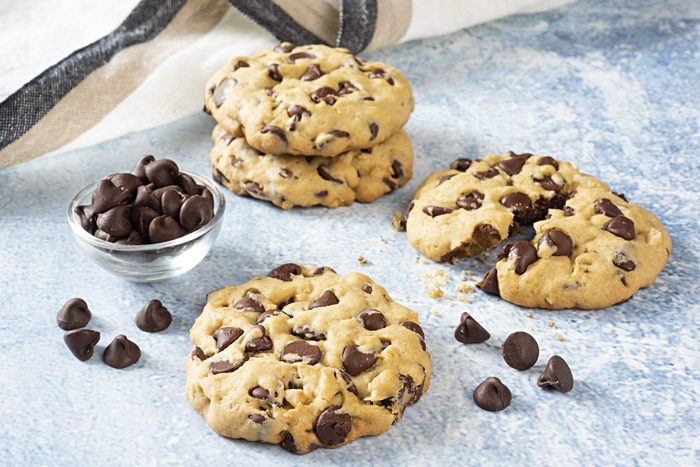
- Bring Flowers to Someone Day
- International Day of Families
- National Chocolate Chip Day
- National Nylon Stocking Day
- Peace Officers Memorial Day
- Straw Hat Day
May 16
- National Barbecue Day
- National Biographer’s Day
- National Classic Movie Day
- National Do Something Good for Your Neighbor Day
- National Love a Tree Day
- National Mimosa Day
- National Notebook Day
- National Piercing Day
- National Sea Monkey Day
- Ride a Unicycle Day
May 17
- International Day Against Homophobia, Transphobia and Biphobia
- Malcolm X Day
- NASCAR Day
- National Bike to School Day
- National Bike to Work Day
- National Cherry Cobbler Day
- National Endangered Species Day
- National Mushroom Hunting Day
- National Pizza Party Day
- National Walnut Day
- Virtual Assistants Day
- World Hypertension Day
May 18
- Armed Forces Day
- Global Accessibility Awareness Day
- National Cheese Soufflé Day
- National Learn to Swim Day
- National No Dirty Dishes Day
- National River Cleanup Day
- National Visit Your Relatives Day
- Plant a Lemon Tree Day
- Send an Electronic Greeting Card Day
May 19
- National Devil’s Food Cake Day
- Plant Something Day
- Stepmother’s Day
- World Baking Day
- World Family Doctor Day
- World Inflammatory Bowel Disease (IBD) Day
May 20
- National Be a Millionaire Day
- National Pick Strawberries Day
- National Rescue Dog Day
- National Streaming Day
- National Women in Aerospace Day
- World Bee Day
May 21

- Eat More Fruits and Vegetables Day
- National Memo Day
- National Strawberries and Cream Day
- National Talk Like Yoda Day
- National Waitstaff Day
- Pesach Sheni (evening of May 21 to nightfall on May 22)
- World Meditation Day
May 22
- Buy a Musical Instrument Day
- Emergency Medical Services for Children Day
- Harvey Milk Day
- National Craft Distillery Day
- National Maritime Day
- National Solitaire Day
- National Vanilla Pudding Day
- Sherlock Holmes Day
May 23
- International Chardonnay Day
- National Lucky Penny Day
- National Taffy Day
- World Turtle Day
May 24
- Brother’s Day
- National Asparagus Day
- National Cooler Day
- National Road Trip Day
- National Scavenger Hunt Day
- World Schizophrenia Awareness Day
May 25
- Geek Pride Day
- National Missing Children’s Day
- National Italian Beef Day
- National Tap Dance Day
- National Wine Day
- Towel Day
- World Thyroid Day
May 26

- National Blueberry Cheesecake Day
- National Family Fun Day
- National Paper Airplane Day
May 27
- Memorial Day
- National Cellophane Tape Day
- National Grape Day
- National Grape Popsicle Day
- National Sunscreen Day
May 28
- Amnesty International Day
- National Brisket Day
- National Hamburger Day
- Whooping Crane Day
- World Blood Cancer Day
- World Hunger Day
May 29
- Mount Everest Day
- National Alligator Day
- National Flip Flop Day
- National Paperclip Day
- National Senior Health and Fitness Day
- National Snail Day
- World Otter Day
May 30
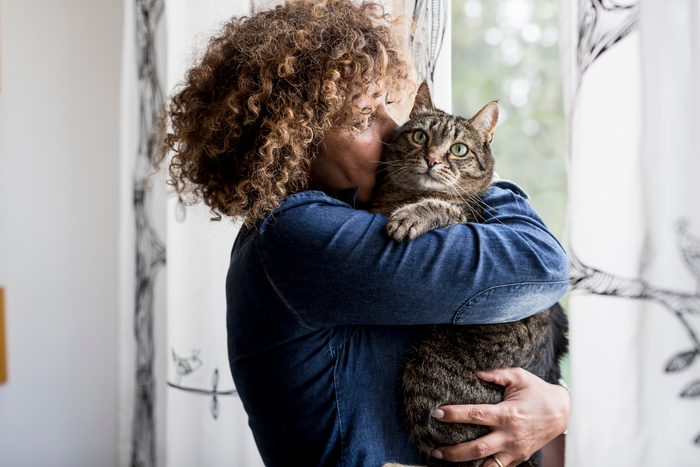
- International Hug Your Cat Day
- National Creativity Day
- National Mint Julep Day
- National Water a Flower Day
- World Multiple Sclerosis Day
May 31

- National Heat Awareness Day
- National Macaroon Day
- National Save Your Hearing Day
- National Smile Day
- World Parrot Day
Why trust us
At Reader’s Digest, we’re committed to producing high-quality content by writers with expertise and experience in their field in consultation with relevant, qualified experts. We rely on reputable primary sources, including government and professional organizations and academic institutions as well as our writers’ personal experience where appropriate. We verify all facts and data, back them with credible sourcing, and revisit them over time to ensure they remain accurate and up to date. Read more about our team, our contributors and our editorial policies.
Putting a bucket outside to catch water while it rains may not seem like a huge deal. But in more than a dozen states, it actually is. State legislatures established rules on catching rainwater, and what you can or can’t use the water for. So if you’ve built a rain barrel for your home, be sure to review local laws to make sure you’re in compliance and not accidentally doing something illegal.
Get Reader’s Digest’s Read Up newsletter for more home tips, humor, travel, tech and fun facts all week long.
Why is water collection a big deal?
According to the National Conference of State Legislatures, catching rainwater or “rainwater harvesting” can affect quality standards, public safety and water rights. Yep, water rights are actually a thing. Water rights are a type of interest that can be tacked onto real-estate ownership when a property is close to a body of water. This means the landowner has the right to use that body of water and any precipitation surrounding it. Some states mandate that all precipitation belongs to existing water-rights owners, and rain flow needs to join its rightful water drainage.
A journal article published by the University of North Carolina titled “Rainwater Collection, Water Law, and Climate Change: A Flood of Problems Waiting to Happen” dives much deeper into water rights. It states that any type of rainwater collectors—whether from gutters on your roof or any other rainwater drain control—”infringes on the water rights lawfully belonging to someone ‘downstream.'” This may not seem like a big deal, but for areas experiencing droughts or any other water worries, legislation such as this can be necessary.
Can you go to jail for collecting rain?
Obviously, your gutter isn’t doing much harm. But for some, collecting rainwater has landed them in the slammer. Back in 2012, one man in Oregon collected 13 million gallons of water and created three reservoirs on his property from rainwater harvesting. That’s right—he made three separate bodies of water from the water he collected!
While most states permit rainwater harvesting and some even encourage it, other states have specific rules and regulations around the topic. These states specify the uses of the water. For example, if the water can be collected for “non-potable” purposes, it means the water is not suitable for drinking but can be used for other things. “Potable” means it’s safe for drinking, cooking and bathing.
Here are a few with specific rules governing rainwater harvesting.
Alaska
Rainwater harvesting is encouraged in Alaska and considered a primary source of water. But for groundwater harvesting, regulations are stricter. According to the Alaska Department of Natural Resources, if you reside near a specific body of water, you need water rights to use that water. If you weren’t given a water-rights transfer from the previous owner, you need to apply for water rights, accompanied by an appropriate fee.
Arkansas
It’s fine to collect rainwater in Arkansas under specific conditions. You can collect the water for non-potable purposes as long as the system used is designed by a professional licensed engineer with appropriate cross-connection safeguards and follows the Arkansas Plumbing Code.
California
Rainwater harvesting coming from your roof is fine in California. No permit from the state board is necessary. However, collecting rainwater for landscaping purposes would require a license. If a rain-capture system is being used to create a water supply (swimming pool, hot tub, fountains, ponds), a landscaper must be authorized to enter a prime contract for that system.
Colorado
Residential homeowners can catch up to two rain barrels of water (approximately 110 gallons). However, the water should only be used for outdoor non-potable purposes on the property where it was collected, such as lawn irrigation and gardening.
For a while, Colorado had strict harvesting regulations due to the senior water rights. But after a study determined that only 3% of rain reached a stream or groundwater, Colorado decided to revise its legislation.
Illinois
Rainwater harvesting is legal, though two specific statutes apply. House Bill 991, passed in 2011, mainly deals with solar-energy rights. But it also requires homeowners associations to specify if rain collection is allowed, and if so, it must spell out the location, design and architectural requirements of those systems.
Illinois also has the Green Infrastructure for Clean Water Act. This act works through water conservation, efficiency, infrastructure and management while promoting rainwater harvesting.
Kansas
Kansas allows water collection, but like in Alaska, you need water rights to do so. The Kansas Water Appropriate Act protects people’s rights to use ground and surface water within the state. If you do not apply for a right or already hold one with your property, it’s illegal to collect.
However, it’s fine to collect water for domestic use—your household, livestock and up to two acres of lawn and gardens. If you’re unsure about what is considered domestic use, the Kansas Department of Agriculture can explain that for you.
Louisiana
Don’t worry—rainwater harvesting is legal. Just be careful that the rain barrel (also known as a cistern) has a suitable cover. Louisiana law forbids selling polluted water, which also includes ice.
Nevada
It used to be illegal to collect rainwater in Nevada, but a 2017 bill permits rain collection for non-potable domestic use. It also allows remote guzzlers for wildlife that hold up to 20,000 gallons with a capture area of no more than an acre. The piping system can’t be longer than a quarter of a mile.
North Carolina
Rainwater harvesting is legal in North Carolina, with a few regulations. The Department of Environment and Natural Resources must provide statewide outreach and technical assistance regarding water efficiency. This also includes developing best management practices for water reuse, harvesting and grey-water use. The State Law 243 authorized changes in the plumbing code facilitating the use of cistern water in residential and commercial buildings.
So what does this mean for you? Appendix C-1 talks in detail about rainwater recycling systems. All rainwater systems should be inspected and can only receive water from the roof of buildings or other catchments. All reservoirs used should be approved, and each should have an approved filter strainer that is disinfected and colored blue or green.
Ohio
It’s fine to catch rainwater in Ohio, even for potable purposes. However, to provide drinking water for less than 25 people, the system needs to be regulated by the Ohio Department of Health.
Oregon
It’s legal to collect rainwater in Oregon. But you must have a water-rights permit if you plan on using public water, unless the general public has the same access.
Texas
Texas has made many changes to its legislation regarding rainwater harvesting, and luckily the state encourages it. However, there are certain regulations regarding catching water for potable and non-potable purposes. If someone plans to connect a rainwater harvesting system to a public water supply system, they must give written notice to the municipality or the owner of that public water supply system. If there are health effects regarding that water, the municipality or the owner cannot be held liable for the consumption of that water.
There are also other rules regarding residential, commercial and industrial facilities. A municipality cannot prohibit a public facility from harvesting rainwater. And the Texas Water Development Board must provide quarterly training to municipality and county staff.
Utah
Sorry, Utah, but rainwater harvesting has some strict rules. It is only allowed on land owned or leased by the person responsible for the collection. Senate Bill 32 states that the person must be registered with the Division of Water Resources if they plan to collect up to 2,500 gallons of rainwater. Registration isn’t required if you use only one container that holds no more than 100 gallons.
Washington
Washington no longer requires a permit to collect water from rooftops, but it still has some pretty strict regulations. Some areas of Washington are stricter than others, so it’s best to check with your specific county. For now, you don’t need a rainwater-collection permit if the rainwater is used on the property and is collected from existing structures that have purposes other than collecting rainwater. Just make sure that rainwater collection isn’t restricted due to local regulations. Also, if the water being collected is used primarily for drinking in a new building, check with your county to see if that is allowed.
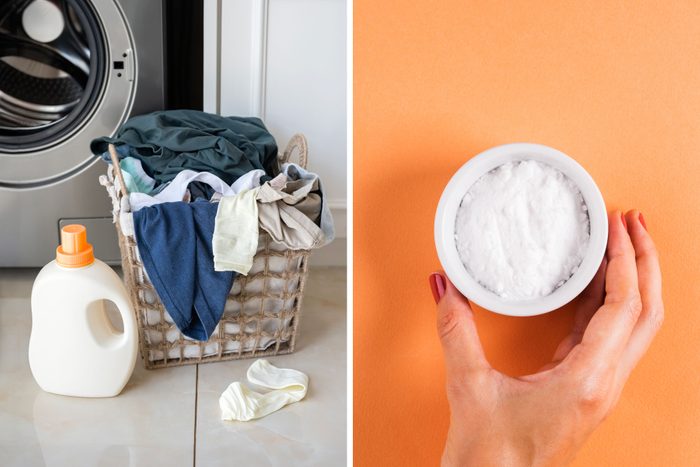
What can’t baking soda do? This simple ingredient is an unsung hero in baked goods, of course, but it also can freshen up a stinky fridge, gently remove stains from countertops and walls, and even give your laundry a boost. In fact, using baking soda in laundry is one of the best ways to get fresher clothing—and one of my tried-and-true cleaning secrets.
As the founder of Clean Mama, a former art teacher and a mom of three, I’m always on the lookout for natural ingredients that do double duty. Once I realized that baking soda (aka sodium bicarbonate) was a common ingredient in laundry products, I started trying it out for myself. After lots of testing and just one mishap involving baking soda and vinegar, I can assure you that this multitasker is an ingredient you’ll want to have on hand.
Ahead, I’ll show you what baking soda can do for your laundry—and exactly how to use it for a variety of laundry tasks, from eradicating stinky smells to lifting stubborn stains.
Get Reader’s Digest’s Read Up newsletter for more cleaning, tech, travel, humor and fun facts all week long.
Is it OK to put baking soda in laundry?
Absolutely. And if you haven’t tried this laundry hack yet, you should do so ASAP! Baking soda can eliminate stinky smells from clothes, as well as brighten dingy fabrics, remove oil stains and more. I particularly like it because it’s gentle and all natural (after all, you can eat it!), so you don’t have to worry about potentially unsafe chemicals under your nose and against your skin. What makes baking soda such a great ingredient in baking—its mild, non-acidic alkaline pH level—is also what makes it a great additive to laundry.
Bonus: Baking soda is incredibly affordable, so you can reap its many benefits for just pennies per load. I always purchase a large bag at my local wholesale club to use exclusively in laundry and other cleaning tasks, so I don’t end up raiding my baking cabinet.
How to use baking soda in laundry
Each laundry task requires different directions. Here’s how I use baking soda in laundry on a regular basis—and how you can too.
To remove odors from laundry
If you’ve ever had laundry that has lingered too long in the washing machine and has that “sour” or mildew-y smell, give it another go in the washing machine with baking soda. If you remove laundry from the dryer and it doesn’t smell fresh, do the same. Yes, it’s an extra step, but it’s worth it—and you really won’t be able to remove those odors without another proper wash. Here’s how to do it.
- Dissolve 1/2 to 1 cup of baking soda in 3 to 4 cups of warm water, and add it to your washing machine basin. If you’re able to stop your machine mid-fill, add it when the water has filled the machine.
- Add your favorite detergent, and wash on warm with a cool or cold rinse. The warm water will ensure that the baking soda dissolves completely, and the cool or cold rinse is simply my temperature preference for laundry, since it can prevent fading and shrinkage. If the care label on the garment calls for a different water temperature, go with that.
- Dry according to the fabric-care instructions.
If you want to remove odors from an unwashed batch of stinky clothes—food smells, a bonfire, sweat—follow the method noted above, but add an extra rinse to ensure the smells are eradicated. You can typically add an extra rinse cycle to a regular cycle on your machine, but if you don’t have that option, let the machine runs its full wash cycle and then run a rinse cycle.
To remove odors from fabrics that aren’t washable
If you have curtains, pillows, dry-clean-only clothes or anything else that isn’t washable but needs to be freshened up, baking soda can do that!
- Add 1 cup of baking soda to a Mason jar.
- Sprinkle in 10 drops of your favorite essential oil blend. Mix with a table knife or large spoon right in the jar.
- Put a piece of fabric or parchment paper under the Mason jar’s ring. The ring will hold the fabric or parchment paper intact, keeping the baking-soda mixture in the jar while still allowing the scent to permeate the air.
- Place the jar in a box or bin with the smelly items. Let it sit for overnight, or longer if needed.
| ♦ Pro tip |
| You can also put this mixture in a fabric sachet or a closet. Make sure that the sachet is tied or sewn, so the mixture doesn’t leak onto your items. |
To remove stains
If you have an oily stain, like a splatter from cooking or a sweat stain, baking soda is a great solution. Not only will the baking soda absorb the oil, but it also has a mild abrasive texture that you can work into stains to remove them.
- Rinse the stain from the back of the fabric, so you don’t further embed it in the fibers.
- Sprinkle the stain with baking soda—just enough to cover it.
- Add a little dish soap or Castile soap.
- Rub in the baking soda and soap with your fingers, a soft laundry brush or a clean toothbrush.
- Let the mixture sit for 15 minutes or so.
- Launder as usual.
- If the stain remains after washing, repeat the process before drying so you don’t set in the stain.
To make detergents and whiteners work better
Baking soda can give detergents and whiteners a boost, which is especially great for dingy whites or secondhand clothes. That said, while sodium bicarbonate is a common ingredient in detergents, take care to not overuse it when adding it to your laundry, and do not mix it with unknown ingredients.
- Mix 1/2 to 1 cup of baking soda with 2 cups of warm water. Stir to dissolve.
- Add the mixture to your washing machine, right on top of your laundry. If you’re able to stop your machine mid-fill, add it when the water has filled the machine.
- Add your preferred detergent, and wash on warm with a cool or cold rinse.
- Dry as normal, according to your item’s fabric-care label.
To clean an iron
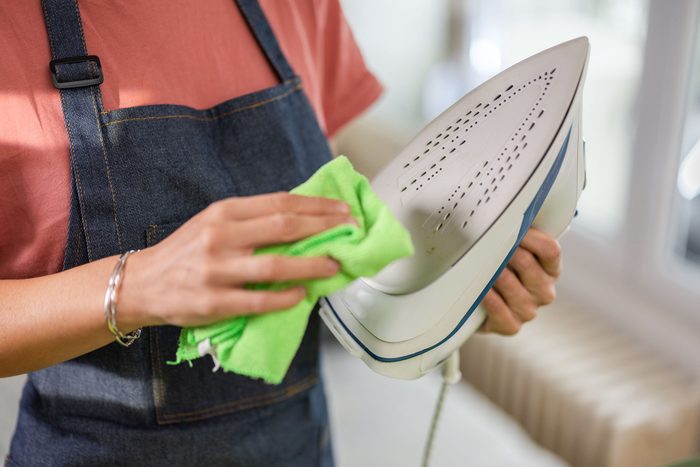
If you have scorch marks on your iron, a gentle paste made from baking soda and water can remove them. The paste will act as a mild abrasive, getting rid of the marks without harming the metal.
- Start with an unplugged, cool iron.
- Mix 1 tablespoon of baking soda with a little water to make a paste that has a thin, toothpaste-like consistency.
- Dip a soft, clean microfiber cloth or sponge in the paste, and rub on the scorch marks until they lift away.
- Rinse the microfiber cloth, and use it to wipe the iron plate clean.
- Continue until the scorch marks and the baking-soda mixture are gone.
FAQs
Can you mix baking soda and detergent?
Yes. Just make sure to fully dissolve the baking soda in warm water so that it’s in the best possible state to work with your favorite detergent. Pre-dissolving the baking soda ensures it’s ready to work right away.
Is vinegar or baking soda better for laundry?
They’re both great, but they have different purposes. When you put baking soda in laundry, it primarily acts as a freshener and deodorizer. You can also use vinegar in laundry for this purpose, but I particularly like using it as a fabric softener. Keep both on hand in the laundry room, and see which you like best for your various tasks.
Can you mix vinegar and baking soda in the laundry machine?
No! Since they are on opposite sides of the pH spectrum—baking soda has an alkaline pH of 9, while white vinegar has an acidic pH of 2—they will cancel each other out when combined.
If you mix them together, you’ll also have an elementary-school science project on your hands. Have you ever tried the “volcano” experiment with your kids that mixes vinegar and baking soda to get a bubbly, overflowing reaction? Let’s just say you don’t want that in your washing machine! That said, you can put baking soda in the washing-machine basin and then vinegar in the softener drawer or a softener ball. This works because the vinegar will release in the rinse cycle after the baking soda has worked its magic.
Where do you put baking soda in a front-loader washing machine?
Dissolve the baking soda in warm water, and place it in the drum with your clothes before you start the load. Alternatively, you can put it into the detergent compartment—again, as long as it’s pre-dissolved. That said, you’ll most likely have more than your detergent compartment can hold, making the drum the best place for the mixture.
Why trust us
At Reader’s Digest, we’re committed to producing high-quality content by writers with expertise and experience in their field in consultation with relevant, qualified experts in the cleaning industry. For this piece on using baking soda in laundry, Becky Rapinchuk, the founder of Clean Mama, tapped her experience as a cleaning expert with more than 15 years of experience, and then Mary Marlowe Leverette, a fabric-care, stain-removal and laundry expert with more than 40 years of industry experience, gave it a rigorous review to ensure that all information is accurate and offers the best possible advice to readers. We verify all facts and data, back them with credible sourcing and revisit them over time to ensure they remain accurate and up to date. Read more about our team, our contributors and our editorial policies.
It’s been more than a decade since the last Harry Potter movie premiered, but fans’ demand for more from the Potterverse hasn’t slowed down. A new streaming series from Max is on the way in 2026, the video game Hogwarts: Legacy released in 2023 to huge success, Harry Potter and the Cursed Child continues its hit run on Broadway and, of course, the Harry Potter theme parks attract massive crowds. We recently caught up with Draco Malfoy actor Tom Felton about the ongoing popularity of the series, his latest ventures and what it’s like to have a Funko Pop figure of yourself, just in time for International Harry Potter Day on May 2.
The now-36-year-old is a far cry from the preteen Draco we knew in the Harry Potter movies. Sitting outside in an off-white sweater and blue scarf, Felton completely disarmed us—not in the “Expelliarmus” way, of course, but with his warm and open personality. “If you hear my dogs barking, you’ll have to excuse me,” he told us. The multitalented star is also a singer and author: Tom Felton’s book, Beyond the Wand: The Magic and Mayhem of Growing Up a Wizard, became a bestseller in 2022. Now, he’s also become a Funko Pop figure with the limited-edition Harry Potter characters inside Kinder Joy Eggs—perfect for Potterheads to collect, like something right out of Honeydukes sweet shop!
Ahead, Felton reveals behind-the-scenes scoop about how close the stars really were, which movie is his favorite and who he’s still friends with from the cast—plus, details on that new Harry Potter merch. Get your broomstick and wand ready!
Get Reader’s Digest’s Read Up newsletter for more entertainment, humor, cleaning, travel, tech and fun facts all week long.
Reader’s Digest: Which was your favorite Harry Potter movie, and why?
Tom Felton: An impossible question for me to answer! Anytime someone asks me that, I return fire. What’s yours?
Reader’s Digest: I think it would have to be the Prisoner of Azkaban.
Tom Felton: They all have arguments to choose which would be your favorite. Chamber of Secrets was really cool because we didn’t know we were going to make a second one. Half-Blood Prince was my favorite as an actor—learning a lot from the wonderful company that I kept there, and being slightly older, obviously. To watch the last one is still probably the most epic. It’s impossible [to choose]. I swear, every time someone asks me, I change my answer. They definitely got darker and deeper in storyline as they went on, but the final film for me is the cherry on the cake. They got it perfect.
Reader’s Digest: What behind-the-scenes Harry Potter details would fans be most surprised to hear, such as unlikely friendships or any special moments between cast members?
Tom Felton: The obvious question I get asked a lot by youngsters is: Are you and Harry actually friends in real life? Like, me and Daniel [Radcliffe, who played Harry]. And obviously I say no at first, and of course I’m joking! It took a long time to make those films, so we only spent maybe 10% of the day in our characters, but we spent a lot of time together as Daniel, Rupert, Emma and Tom. People, for some reason, seem to ask that quite a bit, and they’re quite surprised that Dan’s one of my best friends, and Emma’s very close to me—well, everyone is. It sounds cheesy, but we’re actually a bit of a Potter family. It’s quite fun.

Reader’s Digest: It’s really heartwarming to know that you guys are all still so close.
Tom Felton: It’s quite sad—well, not sad, but it’s quite unfortunate that we always seem to be in four quarters of the earth at the same time, so we rarely get a chance to get together. I just thought of another one, though: The Weasley twins and I have a furious golfing competition. We play quite a lot together, so imagine the Weasley twins and Draco out on the golf course, and them winning most of the time, I’m happy to say.
Reader’s Digest: Do you have a favorite scene that you filmed, or a least-favorite scene, or one that really pushed you as an actor?
Tom Felton: Again, much like your first question, very hard to pick. But what jumps to mind is either the dueling scene in Chamber of Secrets because that was cool—we got to do some of our own stunts—or the bathroom scene in Half-Blood Prince, where Harry and I got to go at it. It was fun to shoot. You lose yourself a lot—in the bathroom scene especially because they rigged all these things to explode when you did the spells, so it was like, “Wow, this wand really works!” It was very cool.
Reader’s Digest: How do you feel about the way Draco’s story resolved? Do you wish it had ended differently for him, and if so, what would you have preferred?
Tom Felton: I don’t think a single word of the books should be changed. There is obviously so much richness to the books, it’s difficult to translate that to the films in a such a short time, but I’m completely and utterly satisfied. And before you ask—no, I would not play any other character. Draco’s my boy. Slytherin for life!
Reader’s Digest: Reading Harry Potter is a rite of passage for most kids. What children’s books had a profound impact on you as a child or just really stuck with you?
Tom Felton: I could go on forever. Obviously Potter is one of them because it was one of the ones that got me back into reading. And I remember very early memories of my dad reading Roald Dahl books and Rudyard Kipling books, How the Rhinoceros Got Its Skin and The BFG. Most recently and still to this day, I love revisiting the Potter books. I’m a big fan.
Reader’s Digest: Are you working on anything now that you’re especially excited about?
Tom Felton: I’m really excited that Kinder Joy Eggs and the Potterverse are colliding, because Kinder Joy Eggs were one of my first memories of a treat. This was pre-Potter. My mom would pick me up from school on a Friday occasionally [with] a Kinder Joy Egg to look forward to, so the fact that they partnered up with Warner Bros. and Funko to make these various different wizarding treats is very exciting. If you told me that was going to happen 25 years ago, I think I would have lost my mind. They literally were two of some of the most important things in my childhood that have come together. It’s pretty cool.
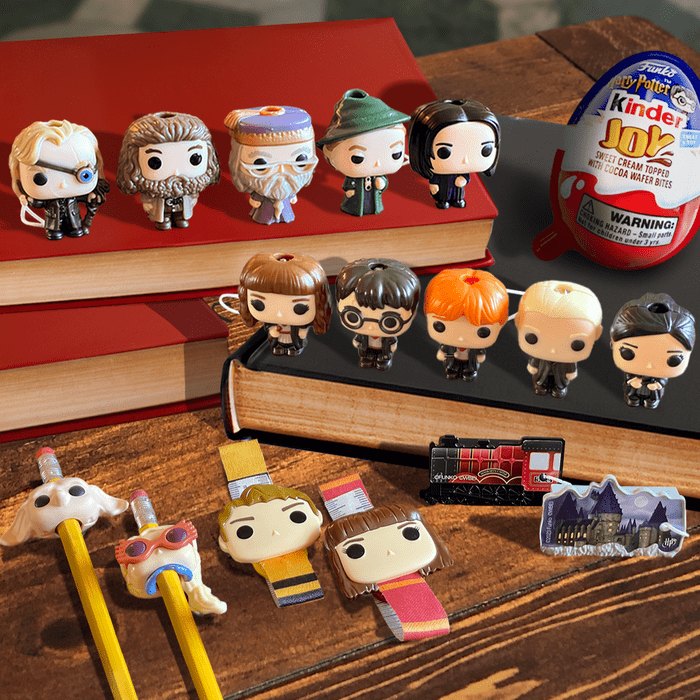
Reader’s Digest: How does it feel to have a toy that looks like you?
Tom Felton: It’s a bit strange the first time you see it. I’ve seen how the world has gone crazy for them. One of my best friends is a huge, huge collector, and it’s very cool. I won’t lie—I have three or four of them in my office, and I’m so excited to start my journey in collecting the new mini versions that are in the Kinder Joy Eggs. I’m going to start my hunt for Draco very soon!
Reader’s Digest: I am also ready to hunt for Funko Pops and expand my own collection as well.
Tom Felton: Which character are you hoping to find first?
Reader’s Digest: Probably Draco.
Tom Felton: Thank you very much. Good answer!
Reader’s Digest: I also would like the little Dobby.
Tom Felton: Let’s just stick to Draco!
Additional reporting by Sadie Reynolds.
This recall is a must-read if you buy laundry detergent pods. The U.S. Consumer Product Safety Commission (CPSC) has shared a recall from Procter & Gamble that affects its popular laundry detergent packets, aka Tide Pods and Gain Flings.
Here’s what to know before doing your next load of laundry.
Get Reader’s Digest’s Read Up newsletter for more cleaning, tech, travel, humor and fun facts all week long.
What laundry detergent is being recalled?
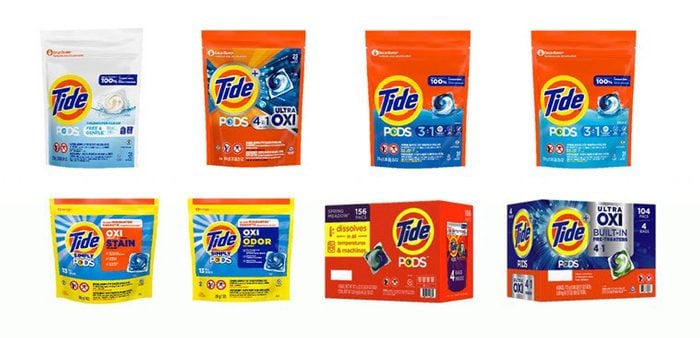
Tide recall
- Tide Pods Original
- Tide Pods Spring Meadow Scent
- Tide Pods Light
- Tide Simply Pods Plus Oxi Boost
- Tide Pods Clean Breeze Scent
- Tide Pods Free & Gentle
- Tide Pods Oxi
- Tide Pods Ultra Oxi
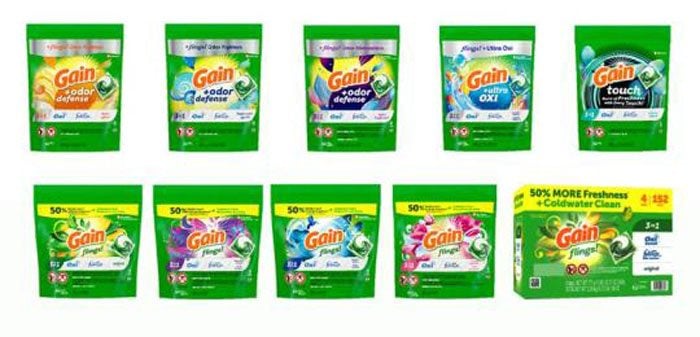
Gain recall
- Gain Flings Original
- Gain Flings Moonlight Breeze Scent
- Gain Flings Blissful Breeze Scent
- Gain Flings Spring Daydream Scent
- Gain Flings Plus Ultra Oxi
- Gain Flings Plus Odor Defense

Other brands
- Ace Pods Clean Breeze
- Ace Pods Spring Meadow
- Ariel Pods Alpine Breeze
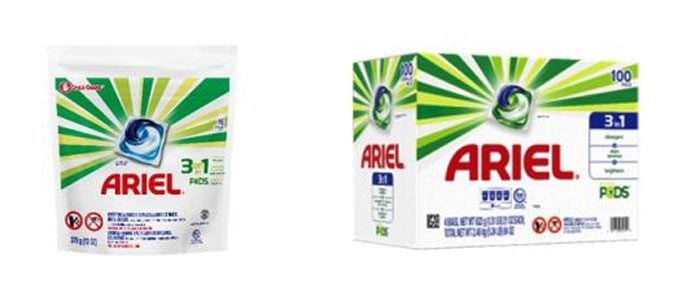
This recall affects only laundry detergent pods sold in bags. The products in hard plastic tubs are fine.
Why is Procter & Gamble recalling these detergent pods?
P&G says the packaging can split open near the zipper track, posing a risk of injury to children and vulnerable adults if they accidentally eat the laundry detergent packets. It happens—so far, four curious kids have accessed the liquid laundry packets, three of which reported ingestion.
How do I know if I bought recalled pods?
To see if your specific Tide, Gain, Ace or Ariel bag is part of the recall, check the lot code on the bottom of the bag. Recalled lot codes will be listed at pg.com/bags.
The recalled P&G detergent has been sold at Big Lots, CVS, Family Dollar, Home Depot, Sam’s Club, Target, Walmart and other major chains, plus on Amazon and other websites. You could have purchased the product any time from September 2023 through today.
What should I do next?
The laundry detergent itself is still safe to use, but store the bags out of sight and reach of kids. If you have a Tide Pods or Gain Flings tub handy, transfer the packets to that tub. Then, contact Procter & Gamble for a full refund and a child-resistant bag to store the product.
Nearly all of us have a set of Corelle dinnerware in the cupboard. It may have been purchased after a ’70s kitchen update or kept on hand since the kids were born in the ’80s. (It is unbreakable, after all.) Because of that decades-long connection, it feels like a member of the family.
But that lengthy life span might also work against some of these pieces. Here’s why you should use caution when eating off of older Corelle dishes—and how you can tell whether your dinnerware is safe.
Get Reader’s Digest’s Read Up newsletter for more dining, humor, travel, tech and fun facts all week long.
It’s a problem with the paint
To understand why you might want to keep retro Corelle in the cabinet, you have to understand the manufacturing process (and how it’s changed over the past several decades). Before the FDA placed regulations on how much lead could be used in tableware, plenty of companies used paints that contained lead on their products. Those regulations came into effect only around 40 years ago, meaning that if you have a set of dishes made before 1980, there could be lead in the paint. If the paint leaches—chipping, flaking off or mixing in with the food—you might consume lead along with your meal.
We don’t have to tell you this, but lead can lead to some nasty side effects. It can be especially harmful to children, and there’s really no safe level of the stuff you can put in your body either. So while dish-related lead poisoning isn’t as serious as exposure to lead from house paints or water, those gorgeous designs on your Corelle could make you sick.
In an email posted on Lead Safe Mama, Corelle itself recommended any dishes made prior to 2005 be used for decoration only.
Do I need to throw away my Corelle dishes?
Not necessarily. Corelle products purchased after 2005 are safe and comply with FDA regulations. But if you have any older dishes, it’s a little trickier. You’ll want to avoid eating off of older Corelle dinnerware if it shows obvious signs of deterioration—for example, if the glaze is worn or the paint is melting or chipping.
To make sure you’re not consuming lead, avoid eating hot foods on the dishes or drinking hot beverages from old cups, and don’t put them in the microwave or store food in them for long periods of time.
What else can I do?
How can you be absolutely sure that your Corelle is safe to serve dinner on? Lead Safe Mama tested a few Corelle pieces. If none of those patterns look like yours and you’re not sure when your set was made, use a lead test kit. Amazon offers several options, although it should be noted that test kits are more useful for detecting high levels of lead, rather than trace amounts.
In the end, if you’re concerned, it’s probably best to put the dishes in a display cabinet and replace them with newer, safer designs.
I only just discovered that WD-40 can do so much more than fix squeaky doors—and I’ve been writing about cleaning and organizing for well over a decade. After speaking with cleaning and chemistry experts, I’m well-versed in how WD–40 Multi-Use Product, the Original WD–40 Formula works and know all of the genius WD-40 uses the pros employ. I, for one, will never be without my own can (or several) again!
WD-40 meets all of my criteria for a household cleaning product everyone should have on hand: It’s extremely versatile and inexpensive, and it both solves and prevents common problems. Ahead, you’ll learn how a WD-40 expert and a chemist suggest using the product around your house.
Get Reader’s Digest’s Read Up newsletter for more cleaning, humor, travel, tech and fun facts all week long.
About the experts
|
The history of WD-40
The name WD-40 hints at the story of how the product came to be, says WD-40 brand manager Stepan Harmanlikian. The product was invented in a San Diego lab in 1953 by Rocket Chemical Company in an effort to develop rust-prevention solvents and degreasers for the aerospace industry. “After 39 attempts, the company’s three employees finally perfected their water-displacing formula on the 40th try,” he says. That formula became WD-40 Multi-Use Product.
WD-40 has a wide variety of uses, including cleaning several notoriously difficult but common types of household messes. And there are even more surprising WD-40 uses, ranging from getting gum unstuck to detangling jewelry.
How does WD-40 work?
While the exact composition of WD-40 is such a closely guarded trade secret that the formula is locked in a California bank vault, the product’s safety data sheet notes that it contains organic solvents, propellants and mineral oil. Erika Womack, PhD, a chemist with the state of Mississippi, an associate research professor and the director of the Chemical Laboratory at Mississippi State University, explains that WD-40 works through lubrication, water displacement, rust prevention and cleaning.
“When sprayed on moving parts, WD-40 leaves behind a thin film of lubricating oil that helps reduce friction, which is useful for loosening hinges, nuts and bolts,” she says. “WD-40 also helps protect against moisture-related issues and prevent rust and corrosion.”
Since water displacement is part of WD-40’s name (yes, that’s what the WD stands for) and a big factor in how it works, it’s helpful to understand a bit more about the process. “Water displacement by the oils in WD-40 is due to the low surface tension,” Womack explains. “The molecules in oil are typically nonpolar, while water molecules are polar. This difference in polarity results in different cohesive forces between the molecules. The oil molecules experience attractive forces among themselves, and they also interact less favorably with the water molecules due to the difference in polarity.”
What does that actually mean? “When WD-40 is introduced onto the water surface, it tends to spread out and push water away due to differences in surface tension between water and WD-40,” Womack says.
Rust prevention occurs through the combination of the lubricating oil and the water-displacing properties of WD-40, which “leaves a protective barrier that inhibits the oxidation process,” she says. Lastly, the “solvents in WD-40 help break down and dissolve dirt, grime and adhesives,” which makes WD-40 an excellent cleaner in some tricky spots, Womack says.
Popular WD-40 uses
Below are the most common WD-40 uses, plus tips for making them work in your home.
Fix squeaky hinges
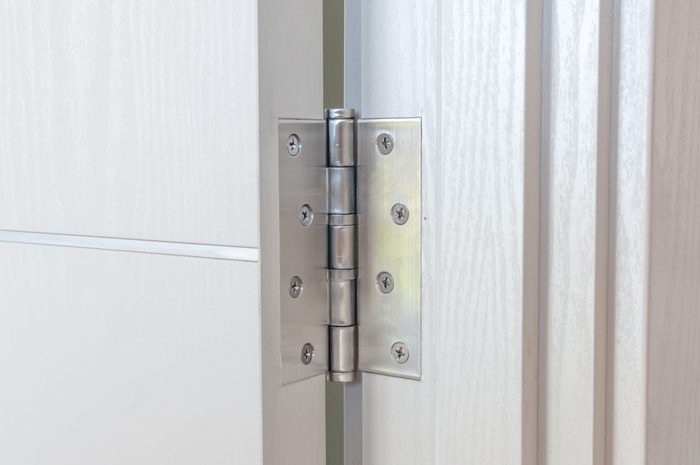
Silencing squeaky hinges is one of the most well-known uses for WD-40 and is probably the reason you have a canister of it in your toolbox. WD-40 can be used on all kinds of noisy hinges, including those on doors, ladders, folding chairs, pruning shears and more. Spray the hinge with a blast WD-40. It will be squeak-free in seconds.
Remove sticky residue
Another of the most popular WD-40 uses is removing sticky residue, such as duct tape residue left on walls or storage bins, stubborn labels on the bottom of glassware or residue from the stickers your kid used to “decorate” the back window of your minivan. To use it, spray WD-40 over the affected area, let it sit for a few minutes, then wipe it away with a cloth or a sponge.
Loosen stuck items
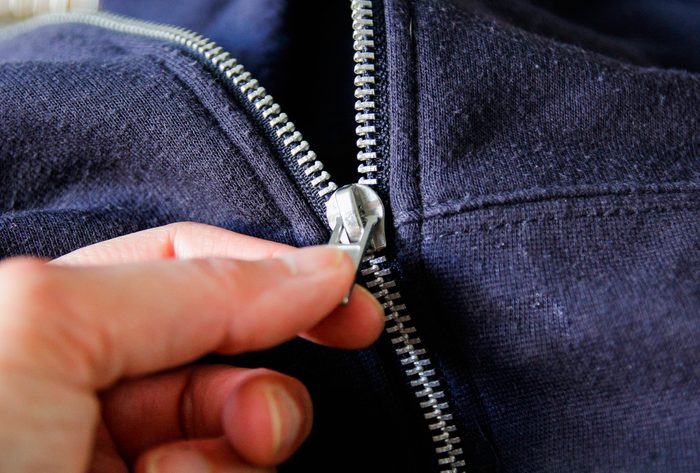
From a zipper that won’t budge to rusted-together nuts and bolts, stuck items are no match for WD-40. Simply spray WD-40 on the trouble spot and allow it to penetrate the area. A jammed zipper may need only a few seconds, while rusted-together nuts and bolts may need up to 30 minutes before they get moving again.
Maintain tools
WD-40 can clean rust and grime from the blades and tines of all your tools. Spray the metal parts of the tool with WD-40, allow it to sit for a few minutes, then wipe it clean with a rag.
Remove wax and glue from surfaces
Get wax and glue off of surfaces without scraping, scrubbing or frustration. Grab some WD-40, spray it on the affected area, allow it to sit for a few minutes, then remove the wax or glue from the surface with a rag.
Cleaning uses for WD-40
WD-40 isn’t just good for unsticking things that are annoyingly stuck. You can also use it to clean bathrooms, floors, stainless steel and more.
Polish stainless steel
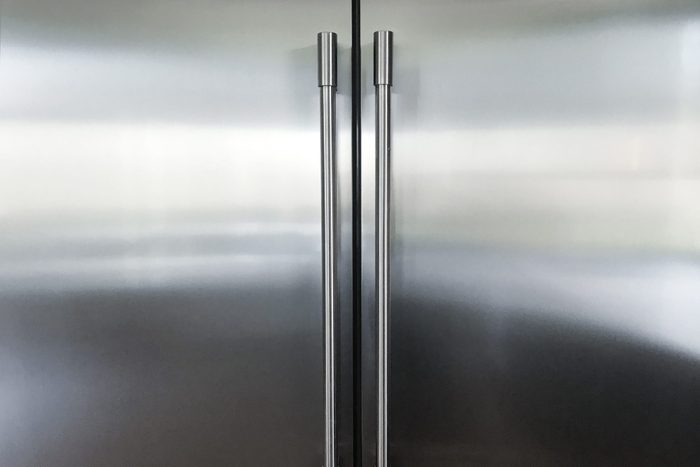
Cleaning stainless steel appliances needs to be a regular part of your cleaning schedule if you want a smudge- and fingerprint-free kitchen. WD-40 can help clean your stainless steel appliances and polish them at the same time. Spray the product onto a rag and buff it into the stainless steel, going with the grain.
Spot-treat stains and scuffs on floors
Cleaning floors is a constant chore, but WD-40 makes it easy to spot-treat scuffs and stains on your floors. Spray the product on the stained area, let it set for a few minutes, then wipe it clean with a rag. The process even works for spilled paint! Just make sure to wipe up any excess product to prevent slips and falls.
Erase crayon marks
Per Harmanlikian, WD-40 is excellent at eliminating crayon marks from just about anything, including wooden furniture, floors and walls. Spray WD-40 onto a rag and rub the affected area until the crayon mark comes off.
Outdoor uses for WD-40
As you might guess, a product that specializes in water displacement and lubrication is useful in outdoor spaces too. Read on to learn about some great WD-40 uses around the house.
Protect pipes from freezing
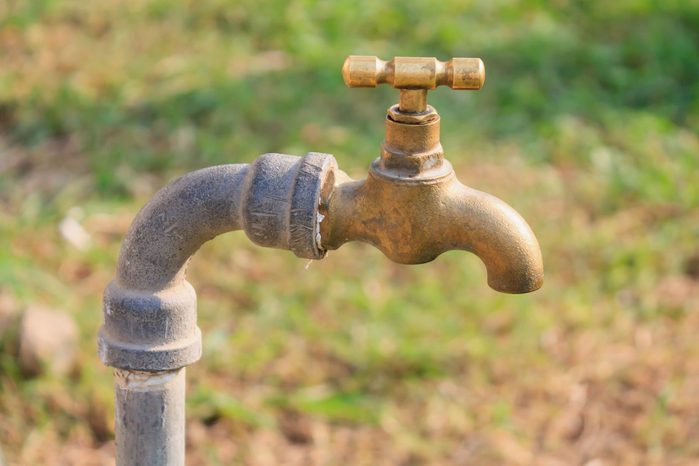
Exposed pipes can freeze in the winter, which can cause big and expensive problems if they burst. In the fall, before cold weather sets in, coat exposed spigots and pipes with a layer of WD-40 to help keep moisture from accumulating.
Prevent snow buildup on windows
Does the weather forecast predict a big winter snowstorm? You can’t stop the snow from falling, but you can prevent it from building up on your house’s windows with this genius WD-40 use. Just spray WD-40 over the outside of your windows before it starts flurrying, and the snow won’t stick.
Repel pests
Spray WD-40 on eaves to prevent wasps from building nests underneath, and use it around exterior window sills and door frames to keep spiders away. According to A-Z Animals, WD-40 repels insects by making surfaces slippery and harder for bugs and pests to grasp onto. Plus, they don’t like its odor. WD-40 also has staying power; the rain won’t wash it away, making it an effective repellant for up to a year.
Keep wooden handles on garden tools splinter-free
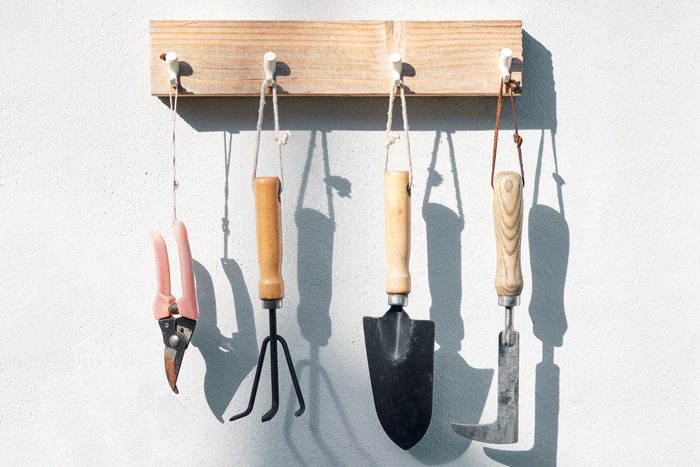
Over time, wooden handles can dry out and eventually splinter, making them not only uncomfortable but also dangerous to use. To prolong the life of your wood-handled gardening tools, refresh them with WD-40. Newer tools need only a light coating, sprayed on and rubbed in with a soft cloth. You may need to sand the handles of older tools before wiping them down with WD-40.
Winterproof boots and shoes
Here’s one of the great WD-40 uses you might not have thought of. Waterproof your winter boots and shoes by giving them a coat of WD-40. It’ll act as a barrier so water can’t penetrate the material.
You can also use WD-40 to remove ugly salt stains from boots and shoes during the winter months. Just spray WD-40 onto the stains and wipe with a clean rag. Your boots and shoes will look almost as good as new.
WD-40 uses for your car
You can use WD-40 to spruce up both the interior and exterior of your car. Just be careful not to use it on plastic bits of the car, as it may damage them.
Polish car exteriors
To remove dirt, grime and paint marks left on your vehicle by other cars, spray WD-40 on a soft cloth and wipe on trouble spots.
Make dashboards and leather shine
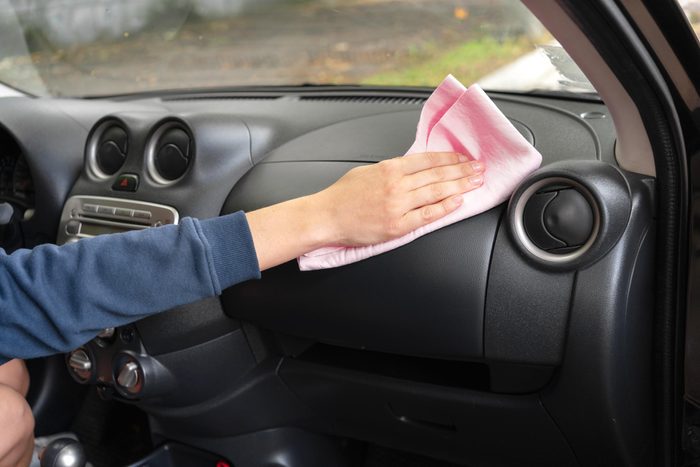
To make leather seats and dashboards gleam, spray WD-40 onto a sponge, then wipe the surfaces. Let the product set for about five minutes, then wipe it dry with a soft cloth. Double-check that your leather interior is not coated with plastic before you start spraying. If it is, avoid using WD-40 on it.
Remove bird poop
Cleaning bird poop from cars can make a bigger mess than you started with if you do it the wrong way. To clean it without having to scrape or scrub, spray the area with WD-40, allow it to sit for about a minute and then wipe or rinse it away.
Restore license plates
To help restore a license plate that is beginning to rust, spray it with WD-40 and wipe it with a clean rag. This will remove light surface rust and will help prevent more rust from forming. It’s an easy way to clean up lightly rusted plates, and it won’t leave a greasy feel.
Clean dead bugs from grilles and windshields
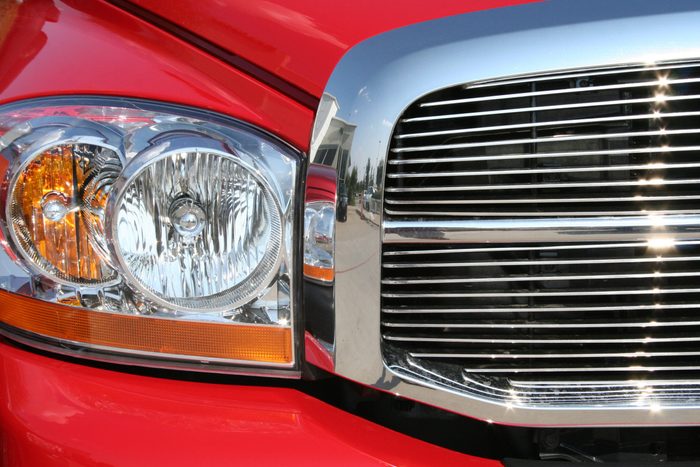
WD-40 is ideal for getting bug splatters off your car’s grille or windshield without damaging the paint. Spray affected areas with WD-40, let the product sit for up to an hour and then rinse it clean. You can also use WD-40 to remove sap and tar from your car without damaging the paint.
Clean oil spots from your driveway
Did a leaky oil pan leave a big, ugly spot in the middle of your concrete driveway? To get rid of an unsightly oil spot, spray it with a generous amount of WD-40 and then hose it down with water.
Unusual uses for WD-40
“Legend has it that police officers used WD-40 Original Formula to lubricate a naked burglar stuck in an air vent and a bus driver [used it] to remove a python from the undercarriage of a bus,” Harmanlikian shares. While you probably won’t find yourself in either of these quandaries, WD-40 has some other unusual uses that you may find applicable.
Get grease or super glue off your hands
If you’ve ever gotten some grease or super glue on your hands, you know it can feel like an exercise in futility to try to wash them with soap and water. Next time, grab some WD-40, apply the product to your palms and rub it around. Wash immediately with soap and water.
Remove gum
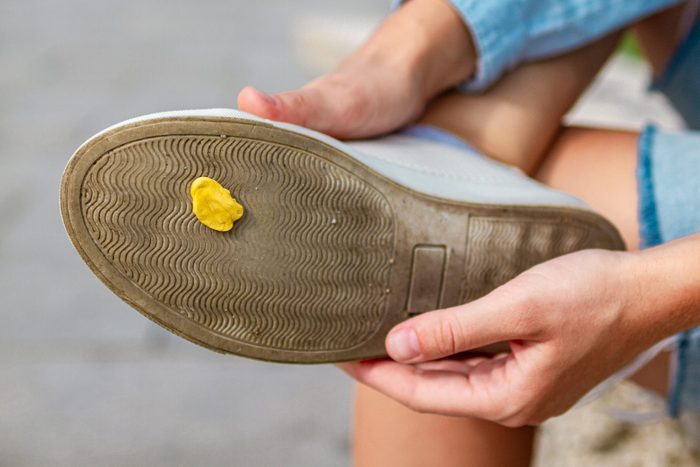
Whether gum has gotten stuck to the bottom of your shoes, the wall, the floor or even in your hair, WD-40 can help, Harmanlikian says. Spray it on the affected area, allow it to penetrate for about a minute and then ease the gum off.
Clean poop off shoes
If you stepped in a mess, remove as much of the poop as possible with a paper towel, then spray WD-40 onto the affected area of the sole of your shoe. It will help loosen the poop so you can scrub it off more easily. Bonus: WD-40 will help keep poop and other dirt from sticking to your shoes in the first place.
Disguise scratches on ceramic, linoleum, marble and wood
WD-40 can fill in scratches on surfaces, including ceramic, linoleum, marble and wood, making them appear less prominent. Spray a rag with WD-40 and buff it into the affected surface.
Condition leather
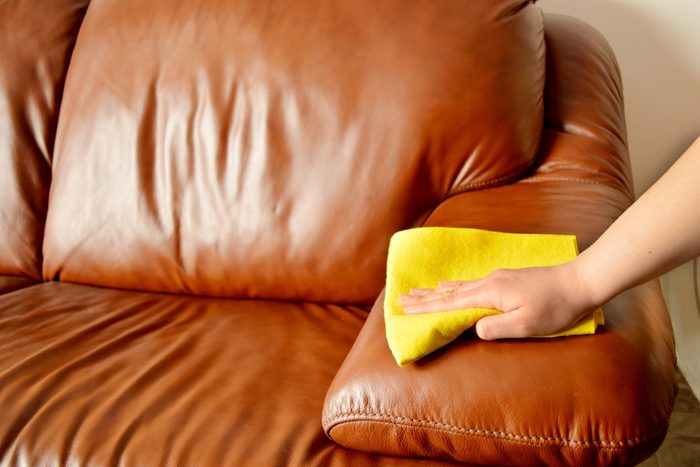
To bring a rich look back to dull or worn leather furniture, handbags or shoes, clean them with a mild solution of dish soap and water on a damp rag. Once the surface is dry, condition and polish the leather by putting a small amount of WD-40 on a rag and rubbing it into the leather.
Prevent fogging on the bathroom mirror
A thin film of WD-40 will keep your mirror clear of steam the next time you take a shower. To keep your mirror free of fog, dampen a rag with WD-40 and wipe the mirror down. Bonus: You’ll clean your mirror at the same time.
Maintain guitar strings
To clean, lubricate and prevent corrosion on guitar strings, apply a small amount of WD-40 after each use. Spray the WD-40 on a rag and wipe the rag over the strings rather than spraying directly on the strings—you don’t want WD-40 to build up on the guitar neck or body. It might seem like WD-40 is a fix-all after reading about all these uses, but there are still times when it’s better not to use it.
Untangle jewelry chains
Don’t risk breaking delicate chains as you detangle them. A spritz of WD-40 on the tangle will lubricate and loosen the knot so you can wear your jewelry again in no time.
De-grime and soften paintbrushes
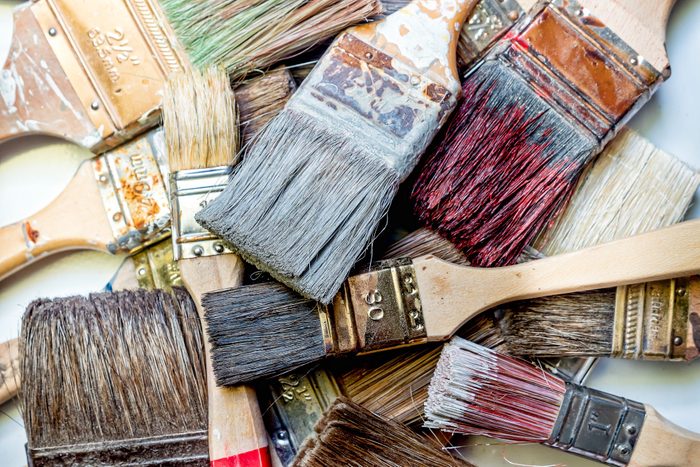
Don’t give up on that old paintbrush yet! To clean brushes, wash them in soap and water, then spray them with WD-40 to help remove stubborn paint.
To soften stiff bristles, simply spray them with WD-40 before storing them. Paint brushes preconditioned with WD-40 are also easier to clean after being used.
Loosen stuck LEGO bricks
Stuck-together LEGO bricks can ruin a good play session, but trying to pry them apart with a knife or other tool can leave marks on the pieces and, worse, injure you. Instead, apply a tiny amount of WD-40, then pull those bricks apart with ease.
Remove tight jewelry
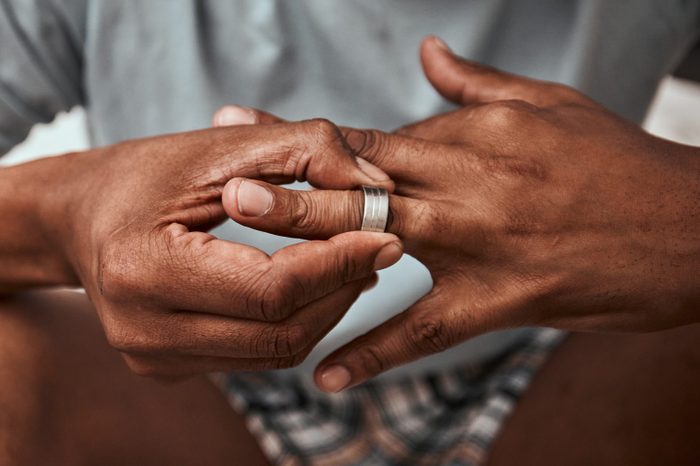
Tight rings aren’t just uncomfortable; if they get stuck, they can be painful and potentially dangerous. Spray a small amount of WD-40 onto the ring, and it should slide off. Be sure to wash your hands thoroughly with soap and water afterward.
Precautions when using WD-40
Before you break out the can of WD-40, it’s important to know the precautions you should follow when using it:
- Use it in a well-ventilated area.
- Avoid contact with your eyes.
- Avoid prolonged skin contact. Wash any skin that comes into contact with WD-40 with soap and water.
- Keep WD-40 away from flames and heat sources, as it’s flammable.
- The contents of a WD-40 can are under pressure, so take care not to puncture the can.
How not to use WD-40
While WD-40 Multi-Use Product has many uses in daily life, it’s important to take note of the times when you shouldn’t use the original formula, including spraying on electronics, plastics, locks or exposed hardware, such as outdoor gate hinges. That said, Harmanlikian points out that there are some special formulations of WD-40 that may be better suited to these uses.
Why trust us
At Reader’s Digest, we’re committed to producing high-quality content by writers with expertise and experience in their field, in consultation with relevant, qualified experts. For this piece, Shifrah Combiths tapped her more than a decade of experience as a cleaning writer. Then cleaning expert Ann Russell, TikTok’s “cleaning auntie” and the author of How to Clean Everything, gave it a rigorous review to ensure that all information is accurate and offers the best possible advice to readers. We relied on reputable primary sources, including cleaning and health experts and reputable organizations. We verified all facts and data and backed them with credible sourcing, and we will revisit them over time to ensure they remain accurate and up to date. Read more about our team, our contributors and our editorial policies.
Sources:
- Stepan Harmanlikian, WD-40 brand manager; email interview, Jan. 5, 2024
- Erika Womack, PhD, Mississippi state chemist and associate research professor and director of the Chemical Laboratory at Mississippi State University; email interview, Feb. 26, 2024
- WD-40: “Safety Data Sheet”
- WD-40: “List of 2000+ Uses”
There are so many things to think about when you’re looking for a new canine companion. Dog behavior, size, age, grooming needs and activity level are all important, but what about male vs. female dogs? Is a dog’s sex something else you should take into consideration before making your decision?
Having been a veterinarian for more than 25 years and a dog parent for even longer, I’ve gotten to know thousands of dogs. Some have conformed to gender stereotypes, while others have not. For example, conventional wisdom says that male dogs are more affectionate than females, and yet, the most affectionate dog I’ve ever had the pleasure of knowing was a male mixed breed named Owen. He followed me everywhere and was simply the most adoring dog you could ever hope to meet. On the other hand, male dogs are also supposed to roam more than females, but it was my female terrier mix, Annie, who simply wouldn’t be fenced in. This little escape artist came to me as a stray, broke out of my well-fenced yard on multiple occasions and loved nothing more than to explore as many mountainsides as possible when we were on hikes together.
But are there some general truisms about male and female dogs? Ahead, we’ll explore what research and anecdotal evidence have to say about the importance of a dog’s sex.
Get Reader’s Digest’s Read Up newsletter for more pets, humor, cleaning, travel, tech and fun facts all week long.
| Reviewed for accuracy by: Wailani Sung, DVM, a vet with a board certification in veterinary behavioral medicine who owns Bay Area Vet Behavior. Dr. Sung is the co-author of From Fearful to Fear Free: A Positive Program to Free Your Dog from Anxiety, Fears and Phobias. |
Does a dog’s sex matter?
Yes and no. Scientific research looking at groups of dogs has found some meaningful differences between males and females, but results like these become almost meaningless if you are interested in the characteristics of a specific dog. For example, spaying female dogs may sometimes lead to increased aggression. However, that spayed female pup you meet at the shelter might be the sweetest thing ever and want nothing more than to sleep in your bed every night. The bottom line: The characteristics of an individual dog are far more important than generalities about their sex. Spending time with a dog, ideally in a variety of situations, is the best way to get a feel for whether its personality will be a good match for you.
Personality differences between male and female dogs
With that said, sex hormones can play some role in shaping a dog’s personality and behavior. Spaying and neutering have a big effect on a dog’s hormonal levels as well, though: Dogs that have been spayed or neutered, particularly at a young age, will usually have fewer hormone-related behaviors.
Personality of male dogs
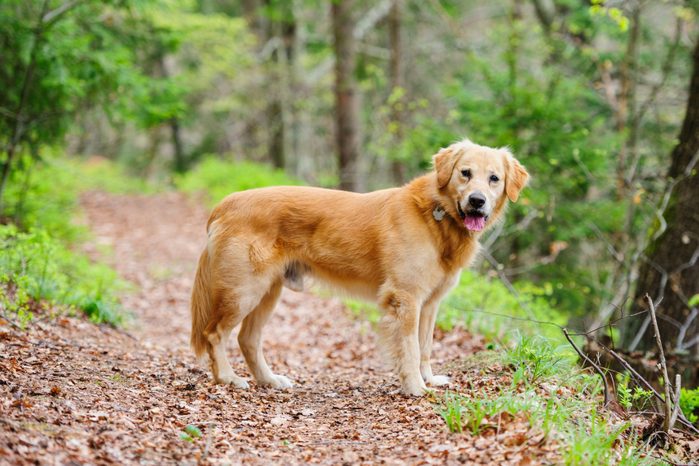
Male dogs that have not been neutered have high levels of testosterone, and testosterone is associated with the problematic behaviors most commonly seen in male dogs. Of course, testosterone isn’t all bad, and it may also play a role in some of the more endearing traits of male dogs.
- Male dogs like to roam. The wild ancestors of dogs were frequently on the move. Males, in particular, had to roam large distances to find mates and defend their territories. This desire to get out and explore is often most evident in intact (non-neutered) male dogs and can lead to problems like getting into dog fights, becoming lost and getting injured.
- Intact male dogs may be more aggressive. In their quest to find a mate, male dogs often have to fight other male dogs. These aggressive tendencies can spill into other parts of their lives, including in their interactions with people. Several studies, including one published in the journal Nature in 2021, have shown that aggression tends to be more common in male vs. female dogs.
- Humping is a bigger problem in male dogs. Humping isn’t always a sexual act in dogs. It’s often just a way to communicate or get attention, or a sign of emotional arousal. That said, male dogs do tend to hump more than females. Dogs can hump other dogs, people and even inanimate objects, which may lead to some awkward conversations!
- Territorial behaviors are more common in males. Male dogs tend to urinate on objects in their environment to mark their territories, which is basically a way of saying, “This area is mine—stay away.” All those stops to pee can make walks slow and more than a little frustrating, but this behavior does have an evolutionary basis. Sometimes the marking behavior can move indoors, which is why you might be looking up how to get dog pee out of your carpet and other surfaces more often than you’d like.
- Male dogs may be more affectionate. People often say that male dogs are more affectionate than females, but there hasn’t been any research to show whether this is actually the case. Of course, it’s the individual’s personality that matters most, but for what it’s worth, my male dogs have always been more willing to dole out the kisses than my females. Many pet parents also say that their male dogs are more active and playful than their female dogs.
Personality of female dogs
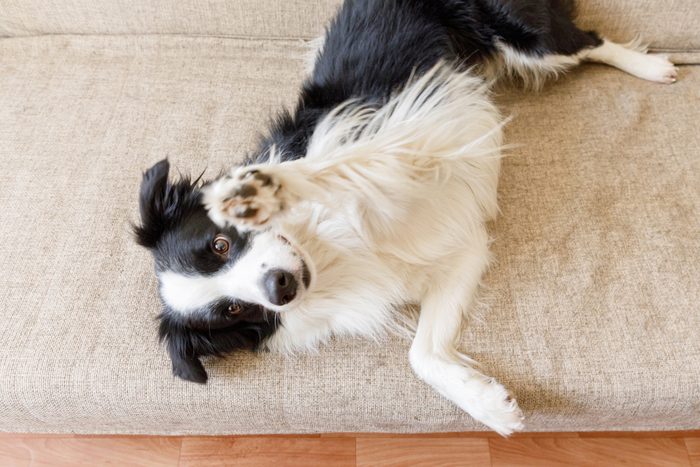
The hormones estrogen, progesterone and oxytocin are all critical to a female dog’s heat cycle and ability to become pregnant and raise a litter of puppies. They may also play a role in some of the personality traits and behaviors that are thought to be more typically female.
- Female dogs tend to be calmer than males. While there haven’t been any scientific studies on the subject, female dogs are often said to be calmer than males. Maybe raising pups requires a degree of level-headedness that male dogs, who aren’t so involved in the upbringing of their offspring, don’t need.
- Female dogs may be easier to train. One study published in Royal Society Open Science in 2017 found that female dogs scored higher than male dogs on measures of obedience, which should make them easier to train. And if female dogs truly are calmer than males, they may be better able to focus on what’s being taught rather than being distracted by every squirrel that runs by.
- Unspayed female dogs need to nurture. After an unspayed female dog goes through her heat cycle, she experiences all the hormones associated with pregnancy, even if she’s not carrying pups! This means that about two months after her heat cycle is over, you might see your dog getting ready to take care of puppies. She may even build a nest. These nurturing tendencies can surface at other times as well, such as when she gently carries a stuffed animal around in her mouth or comforts you when you’re upset.
- Loyalty is a trait often associated with female dogs. In my experience, male and female dogs are both capable of intense loyalty. Nevertheless, females tend to have higher levels of oxytocin, the hormone that promotes bonding between mothers and their offspring, which may explain why female dogs are sometimes said to be more loyal than males. But according to a study published in Science in 2015, you and your female or male dog can experience higher oxytocin levels simply by staring into each other’s eyes.
Health differences in male and female dogs
Dogs of one sex aren’t necessarily healthier than the other, but certain health problems are more common in male vs. female dogs. Of course, conditions that affect the reproductive tract will vary, but there are some surprising differences as well. I can’t explain why, but every dog that I’ve treated for gastric dilatation and volvulus (a potentially fatal twisting of the stomach) has been a male.
Health of male dogs
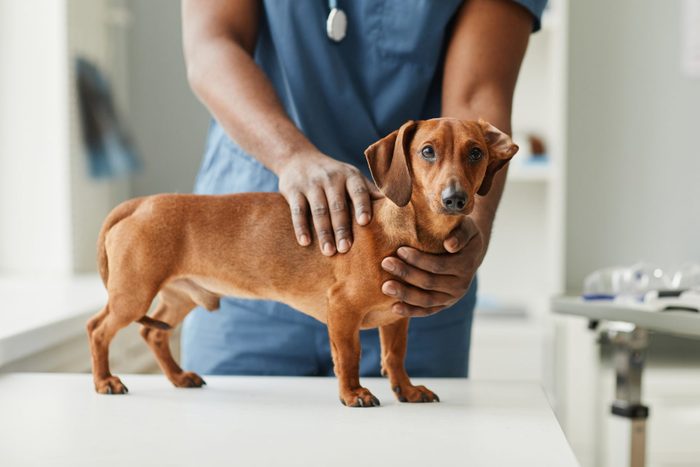
Male dogs are prone to certain health problems because of their anatomy and hormones. Knowing which diseases are most common in your dog will help you know what symptoms to watch for.
- Testicular tumors can develop when male dogs aren’t neutered. Tumors involving the testicles are the most common form of reproductive-tract cancer in male dogs. Most tumors develop later in life and are malignant, although neutering can cure the condition if it’s caught early enough. Neutering is also the best way to prevent testicular tumors in dogs.
- Prostate-gland diseases are common. The prostate gland may cause problems, particularly as dogs age. Benign prostatic hyperplasia (BPH) is the most common prostate disease and usually affects older, intact male dogs, but infections, cysts and cancer are also possible. How will you know if your dog has a prostate issue? These diseases cause the gland to enlarge, which may make it hard for the dog to pee and poop.
- Tumors around the anus can cause trouble. High testosterone levels increase the risk that a dog will develop a type of tumor called a perianal gland adenoma. Most of these tumors are benign, but they may need to be removed to prevent infections; if they get large enough, they can also block the normal passage of poop, causing dogs to strain or poop small amounts more frequently than is normal.
- Male dogs have more inherited joint problems. Perhaps it’s because they tend to grow faster and larger in comparison to females, but male dogs are more likely to develop symptoms associated with joint problems that they inherit from their parents. For example, elbow dysplasia is more common in male vs. female dogs, and while hip dysplasia affects both sexes equally, the condition tends to progress more quickly in males. Affected dogs often develop arthritis in their affected joints, sometimes at a very young age.
Many of these health problems can be prevented by neutering male dogs, but a few actually become more likely, particularly in certain breeds, if dogs are neutered before they have fully matured. For example, it’s best not to neuter male golden retrievers until after they are 1 year old because dogs who are neutered before this time have an increased risk of cancer and joint problems. A veterinarian can help you determine the best time to neuter your dog.
Health of female dogs
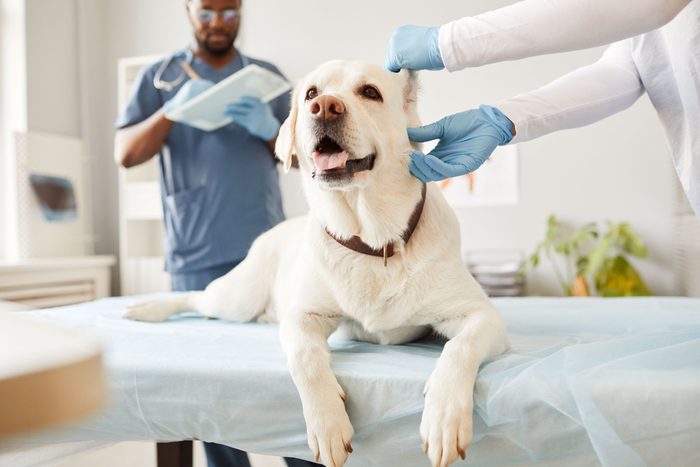
Health problems affecting the ovaries and uterus obviously only affect female dogs, but other conditions are more likely as well if your dog is a female—particularly if she isn’t spayed or was spayed later in life.
- Mammary tumors are common in unspayed female dogs. Because of the effects of estrogen, both benign and malignant mammary (breast) cancer is much more common in female vs. male dogs. Get your dog seen by a veterinarian whenever you notice a lump or bump, because early treatment yields the greatest chance of success. Spaying a dog before she has gone through her first heat cycle almost eliminates the risk of mammary tumors, but this protection disappears after she has gone through two heats.
- Uterine infections can be deadly. A female dog’s uterus can become infected and filled with so much pus that it ruptures. This condition is called pyometra, and it develops because of the hormone changes that dogs go through after every heat cycle. Spaying a dog will block these hormonal shifts and also prevent pyometra. Up to 25% of unspayed female dogs will develop this condition during their lives.
- Female dogs can develop ovarian cancer. Spaying a dog involves removing her ovaries, so her risk of ovarian cancer is eliminated after the surgery. Ovarian cancer can be benign or malignant, but luckily, it isn’t very common, probably because most pet parents elect to spay their dogs before the condition has a chance to develop.
- Urinary tract problems are common. The female urethra is short and wide, giving bacteria easier access to the bladder and increasing the risk of a urinary tract infection. Signs of a urinary tract infection can include experiencing discomfort when urinating, producing small amounts of urine frequently and having accidents in the house. And while spaying helps prevent many health problems in female dogs, some will leak urine after being spayed. Thankfully, medications will usually improve the situation.
A veterinarian can help you figure out if and when your female dog should be spayed based on their breed and overall health status.
FAQs about male vs. female dogs
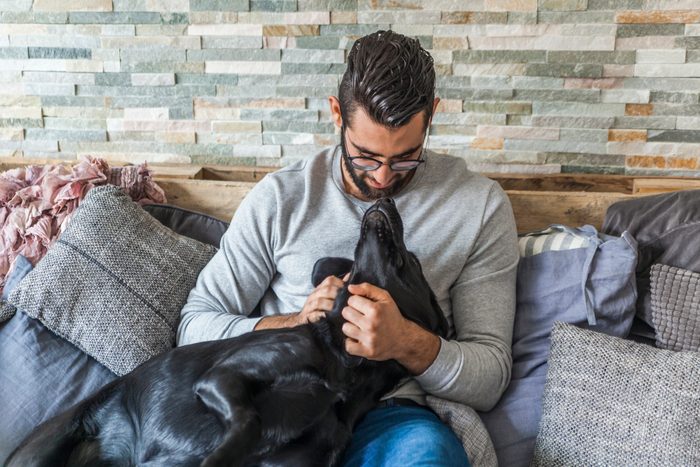
Are male dogs more affectionate?
Male dogs have a reputation for being more affectionate than females, but in truth, you can find many extremely affectionate female dogs and some male dogs who prefer to be left alone. What’s most important is the individual dog’s temperament. Some breeds also tend to be more affectionate than others.
Do female dogs prefer female owners?
Not necessarily. Both female and male dogs feel more comfortable with the types of people they’ve had positive experiences with in the past. So if a female dog had been cared for by a loving female owner, they probably would prefer females, but the same thing would apply to a male dog who had previous good experiences with women.
Are male or female dogs better for emotional support?
Both females and males can be wonderful emotional support dogs; it really depends on the traits you’re looking for. Conventional wisdom says that female dogs may be calmer and more loyal, while males may be more outwardly affectionate, but these are only generalizations and do not apply in every case.
Are female dogs less aggressive?
Studies have shown that, in general, female dogs are less aggressive than males. However, any dog can act aggressively when they are frightened or put in situations that they find threatening.
Are female dogs more loyal?
You’ll often hear people say that female dogs are more loyal than males, but in my experience, both males and females can be incredibly loyal. An individual dog’s personality and how they have been treated by the people around them are far more important than their sex in determining how loyal they will be.
Are male dogs harder to potty train?
There isn’t much of a difference when it comes to potty training male or female dogs. Both sexes require close monitoring, frequent trips outside and lots of positive reinforcement while they are being potty trained. Putting your dog in a comfortable crate when you can’t keep an eye on them can help immensely. However, marking can be a hard habit to break, and it is more common in males than females. Get advice from your veterinarian as soon as possible if your dog likes to pee on everything they see.
Do dogs prefer male or female owners?
Some dogs seem to prefer women over men, probably because traits that are more typically female (a higher voice, for example) are less threatening and more appealing to dogs. However, other dogs prefer men, particularly if they’ve had good experiences with them in the past or if they’ve had bad experiences with women.
Why trust us
At Reader’s Digest, we’re committed to producing high-quality content by writers with expertise and experience in their field in consultation with relevant, qualified experts. For this piece, Jennifer Coates, DVM, tapped her experience as a veterinarian with more than 25 years of professional experience, and then Wailani Sung, DVM, DACVB, PhD, a veterinarian specializing in behavioral medicine and the co-author of From Fearful to Fear Free: A Positive Program to Free Your Dog from Anxiety, Fears and Phobias, gave it a rigorous review to ensure that all information is accurate and offers the best possible advice to readers. We verify all facts and data, back them with credible sourcing and revisit them over time to ensure they remain accurate and up to date. Read more about our team, our contributors and our editorial policies.
Sources:
- Nature: Scientific Reports: “Aggressive behaviour is affected by demographic, environmental and behavioural factors in purebred dogs”
- Royal Society of Open Science: “Assessment of owner-directed aggressive behavioural tendencies of dogs in situations of possession and manipulation”
- Science: “Oxytocin-gaze positive loop and the coevolution of human-dog bonds”
- BMC Veterinary Research: “Prevalence of commonly diagnosed disorders in UK dogs under primary veterinary care: results and applications”
- Frontiers in Veterinary Science: “Assisting Decision-Making on Age of Neutering for 35 Breeds of Dogs: Associated Joint Disorders, Cancers, and Urinary Incontinence”
Learning how to clean your dog’s teeth helps prevent bad breath and tooth pain. But just because dogs won’t naturally open wide and say “ahh,” doesn’t mean you need to turn to a professional every time their teeth need brushing. At-home dog-teeth cleaning can save you major vet costs and even extend your dog’s life (periodontal disease affects the whole body, after all).
As a certified animal behavior consultant, a Fear Free–certified trainer and author of more than 35 pet-care books, I’ve written about and taught cooperative dog-handling tips for more than 30 years. And like your pets, my dog doesn’t automatically accept invasive handling without lots of preparation. Without training, pups dive under the bed, run away or struggle—even if you know how to groom your dog. And the process can break your heart—nobody wants their dogs to be scared.
But never fear. With the help of board-certified veterinary dentist Naomi Hoyer, DVM, I’ve created the ultimate guide to cleaning your dog’s teeth. With the doggy dental tips and tricks below, you can ensure your pup’s teeth get clean. My pets come running for tooth care now—and yours can too.
Get Reader’s Digest’s Read Up newsletter for more pets, humor, travel, tech and fun facts all week long.
About the experts
Reviewed for accuracy by: Wailani Sung, MS, PhD, DVM, DACVB, a board-certified veterinarian and veterinary behaviorist who is the owner of Bay Area Vet Behavior. |
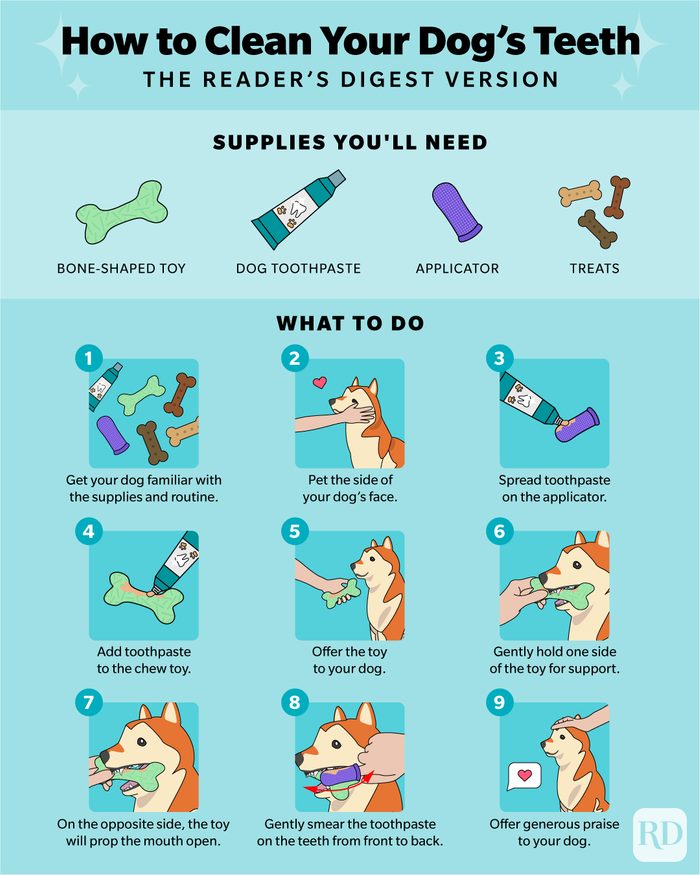
Why is it so important to brush your dog’s teeth?
According to Dr. Hoyer, learning how to clean your dog’s teeth is the best way to control plaque accumulation and prevent dental disease. “Plaque mixes with the minerals in saliva and is known as calculus [tartar] and then is very challenging to remove from teeth.”
And because tartar (the yellow or brown spots you notice on your pup’s teeth) impacts whole-body health, brushing teeth is necessary to prevent additional problems that could cut your dog’s life short. The same bacteria found in a dog’s mouth with dental disease is often implicated in endocarditis, an inflammatory heart disease, according to VCA Animal Hospital experts. The liver and kidneys also are affected by oral bacteria, because these organs filter bad stuff out of the blood.
“Dental disease is the most common disease in our small animal patients (both dogs and cats),” says Dr. Hoyer. “Greater than 70% of dogs more than 3 years of age have some form of dental disease. All dogs, no matter the breed can develop dental disease.”
Besides tooth loss and painful chewing, you may notice a variety of dog illness symptoms in pups with dental disease, including fever, weight loss and loss of appetite.
Also Check: Sweet puppy breath is a fleeting joy. But what causes it and how long can you expect it to stick around?
How often should you brush your dog’s teeth?
Ideally, you should brush your dog’s teeth daily, says Dr. Hoyer. But when you have a busy schedule like I do, it proves challenging to brush a dog’s teeth after every visit to the food bowl. “If the goal is to reduce calculus (mineralized plaque), then you need to brush at least three times per week,” says Dr. Hoyer. Even a couple of times a week improves a dog’s oral health—any amount of dog-teeth cleaning works better than doing nothing at all.
Start brushing your dog’s teeth as a puppy. Youngsters more easily accept tooth brushing as normal—they don’t know any better, and their smaller size makes them easier to manage. Adult dogs may object to the intrusion, but they still can learn to accept tooth care. Cleaning your dog’s teeth is part of grooming and is as important as giving your dog a bath.
How to get your dog comfortable with teeth cleaning
You already know how to brush your own teeth, and the same technique actually applies to cleaning your dog’s teeth. But a vital part of cleaning a dog’s teeth includes teaching them what to expect, so they won’t feel scared. Remember: Teaching any dog takes time. Don’t rush or force your pet. It may take three days or three weeks before a dog will let you clean its teeth. Once a dog understands and accepts the procedure, the teeth cleaning won’t take more than a few minutes. Before you even bring out the toothbrush, take time to train your dog on its new teeth-cleaning routine. Here’s how to get your dog comfortable with teeth cleaning.
Step 1: Schedule training
Dogs love routine, so cleaning your pet’s teeth in the same location and at the time each day can help your furry friend view teeth cleaning as part of a normal day.
Step 2: Signal tooth time with a towel
Until your dog learns to accept you brushing its teeth, things can get messy. A towel helps contain any mess and also lets your dog know what to expect. That can comfort a shy or fearful dog too. For a small dog, spread the towel on your lap. This helps you control the interaction better, as it will feel similar to a snuggle session. For big dogs, lay the towel on the floor and kneel next to your pup, with the dog between your knees, facing out.
Step 3: Touch your dog’s mouth
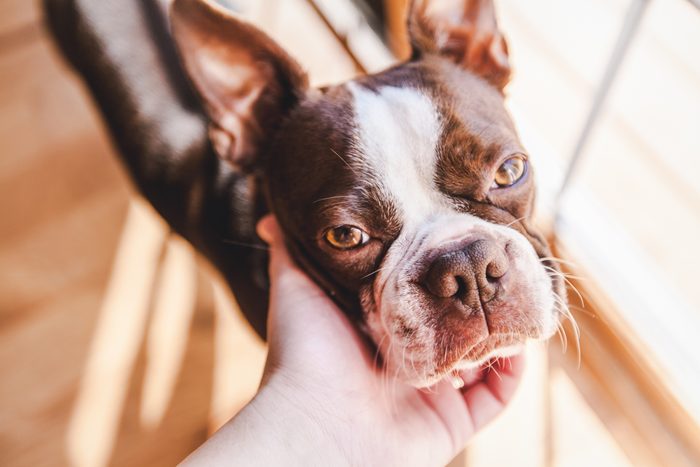
Start by petting the side of your pup’s face, paying particular attention to the outside of their mouth and lips. If you feel comfortable, allow mouthing, which is when a dog puts its teeth and mouth over a person’s skin while using little or no pressure from the jaws. This way, you can easily touch the outsides of the dog’s teeth. Do this for five minutes and offer a treat each time your dog lets you stroke their gums or touch a tooth. Repeat this step once or twice a day for three to five days. After the dog accepts your handling of its mouth, move on to using toothpaste.
Step 4: Teach with a tasty toy bone
Spread dog toothpaste on a non-fabric toy, such as a rubber chew bone. Choose a large chew bone that the dog can comfortably grasp. (It should also be big enough to extend out each side of the mouth and keep the jaw slightly open.) Let your pup lick off the paste—many dogs enjoy flavored pet toothpaste like a treat. Canine toothpaste includes ingredients that help clean teeth even without brushing, so that’s a great first step. You want to associate the toy with the yummy flavor.
Step 5: Offer a toothpaste-coated toy bone
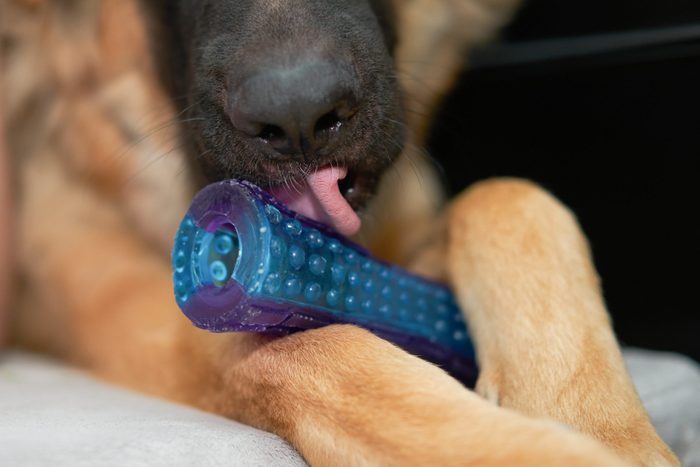
If your dog wants to take the toy into its mouth, that’s great! As the dog takes the toy, say, “Open.” That teaches the cue word and essentially trains the dog to open wide on its own, so there’s no need for scary unproductive wrestling. Eventually, you’ll only need to say the word to prompt the dog to take the toy.
Step 6: Gently hold one side of the toy for support
When your dog has the bone in its mount, hold one side of the toy steady and in place with one hand. That way, the flavored toy props the mouth slightly open enough to offer a gap in which to begin brushing with the other hand. Never squeeze the dog’s muzzle. And keep in mind that dogs are sensitive about toys in their mouth, which makes this an important training step. Ideally, once trained, your dog will know to take the flavored toy into its mouth and allow you to gently hold the toy steady to administer the toothpaste.
Step 7: Get your dog comfortable with the toy routine
Reserve this special toy for teeth cleaning so your pet only gets the yummy paste and other treats for this purpose—they’ll look forward to the fun. When you start out, spend about five minutes playing with the toy, taking it from your dog to add paste. Say, “Open,” to cue your dog to take the toy. Say, “Drop it,” for a release. Praise after each time and reward with a treat. Repeat this step once or twice a day for several days in a row.
Step 8: Introduce the applicator
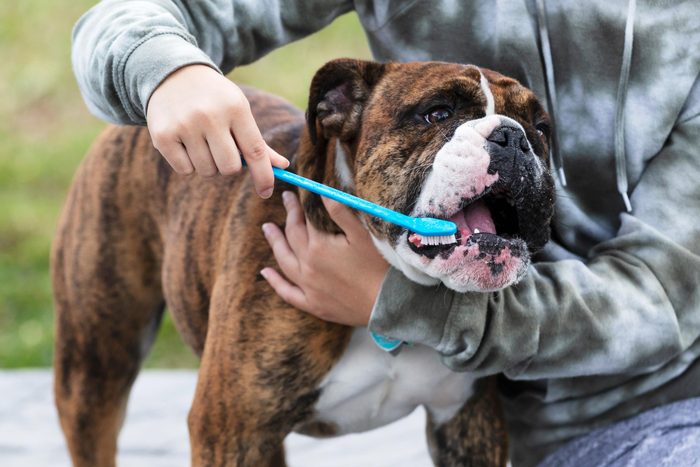
Once your dog accepts the above steps, introduce the applicator of your choice. You must feel comfortable using it or your dog will sense your stress and feel equally uneasy. You can do this! Choose a finger toothbrush, doggy toothbrush or gauze-wrapped finger. Let them sniff your application of choice first. Then add the toothpaste. While holding the toy bone propped inside the dog’s mouth with one hand, use your other hand to slip the toothpaste-loaded applicator inside the dog’s lips. Leave it only a few seconds, then remove and release the dog’s toy bone as you say, “Drop it.” Used consistently, your dog will learn to drop it when you ask.
Step 9: Praise your dog
Give extravagant praise as your dog licks their lips. And congratulate yourself, too. Follow up immediately with a favorite treat or game to reward your dog’s extraordinary intelligence and tolerance. Once your dog acts excited at the sight of the towel, toy and paste, you can move on to routine dog-teeth cleaning.
How to clean your dog’s teeth
I recommend training your dog to accept the process well before you start brushing the teeth. Set aside at least a couple of weeks for preparation and training. Dogs can’t learn when scared, so strive to make the experience pleasant with lots of rewards (treats, cuddling, praise, games—whatever your dog loves). Even the best-natured dogs may growl or snarl when they don’t understand what you want, feel scared or are accidentally hurt. Stop immediately if this happens! That growl or snarl warns you to stop, so feel grateful that dogs communicate with us—and listen to them.
It’s best to begin brushing a dog’s teeth before problems develop. For adult dogs, have your veterinarian provide a professional cleaning first, if needed, so you can maintain the healthy start. Otherwise, dogs won’t want you touching sore, painful gums. I also highly recommend using the rubber bone or toy prop because it gives your dog something to chomp besides your fingers and prevents an accidental bite, which can do major damage.
And pro tip: Don’t touch inside the mouth (behind the teeth). Because the tongue keeps the inside surface of the teeth clean, you only need to clean the outside surface, so don’t risk fingers poking inside the mouth!
Supplies you’ll need
Bring everything you plan to use to the location you’ll be cleaning your dog’s teeth. You may want to keep teeth-cleaning tools in the same place as your other grooming supplies. Your pup should eventually enjoy the experience and expect the event. To speed up the process, choose somewhere your dog already associates with fun times or yummy rewards, like in the kitchen near the food bowl.
- Chew toy: A rubber bone-shaped dental toy works great, sized large enough so that the ends stick out of the dog’s mouth on each side when held. Dental toys usually have nubs that help clean teeth as the dog chews or that hold dog toothpaste.
- Bath towel: A towel provides an easy-to-clean surface for training and eventual teeth cleaning. Using the same towel each time signals to your dog what happens next.
- Dog toothpaste: Never use human toothpaste with your dog. Dogs can’t spit and shouldn’t swallow the fluoride that human products contain. Dogs also hate the foaming action. Don’t use baking soda, either, as the high alkalinity can upset canine tummies when swallowed. Instead, choose a toothpaste designed specifically for dogs. Pet toothpaste comes in flavors that dogs love, like chicken.
- Applicator: Choose a tool you feel most comfortable using. A dog toothbrush, finger toothbrush that slips over your finger or a disposable gauze pad that slips over your finger all work well to spread the toothpaste.
- Bonus rewards: Dogs liked getting “paid” for being good, just like humans enjoy a bonus for a job well done. If your dog loves treats, offer dental treats after the session. Or if a play session or car ride prompt bigger wags, “pay” your dog with the preferred reward.
Step 1: Prepare the applicator with toothpaste
Whether you’re using a finger toothbrush, gauze pad or dog toothbrush, you’ll want to spread dog toothpaste onto the brushing material. You won’t need a lot of paste, so just add enough to cover the end of your finger.
Step 2: Add toothpaste to the rubber chew toy
Spread dog toothpaste on your chosen chew toy. Since you’ve already taught your dog what the yummy-flavored dog toy means, this signals to them that more treats will come.
Step 3: Offer the rubber chew toy
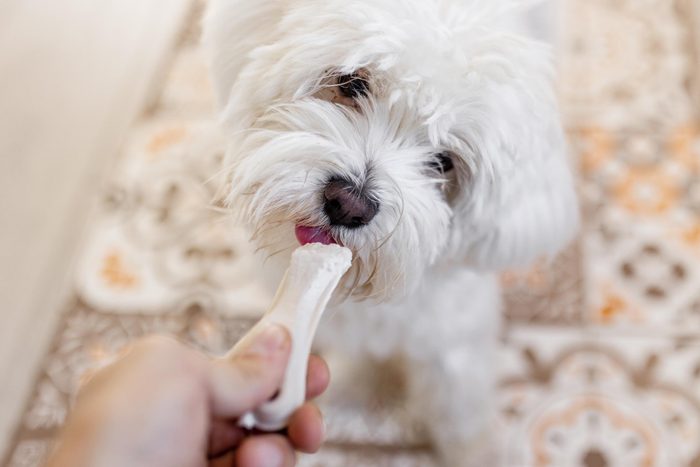
Gently stroke your dog’s face and muzzle in preparation for inserting the toy bone. Say, “Open,” and praise when the dog grasps the toothpaste-covered toy.
Step 4: Hold the toy in place
As your dog closes its mouth around the toy, hold it in place with one hand. Avoid squeezing the muzzle. Your hand should support rather than restrain the dog in this position. For small dogs, it can help to kneel on the floor with your pup between your knees, facing out, so they can’t wiggle away. Holding the toothpaste-coated toy in place should offer a gap in which to begin brushing.
Step 5: Clean one side of the teeth first
With one hand wrapped around the opposite side of the dog’s toy, use the toothpaste-covered applicator to wipe the outside of the dog’s teeth on one side of its mouth. Do the top jaw first, and if your dog is still fine with it, finish with the bottom teeth on the same side. You don’t need to scrub—simply wipe the paste from side to side. Start out with a brief front-to-back (or back-to-front) smear of paste on the sides of the teeth, whichever feels most comfortable for you. Then release and remove the toy. The dog will lick lips and savor the paste you’ve left on the teeth. When you’re first starting out, be satisfied with one side and a quick smear. Then quit for the day.
Step 6: Clean the other side of the teeth
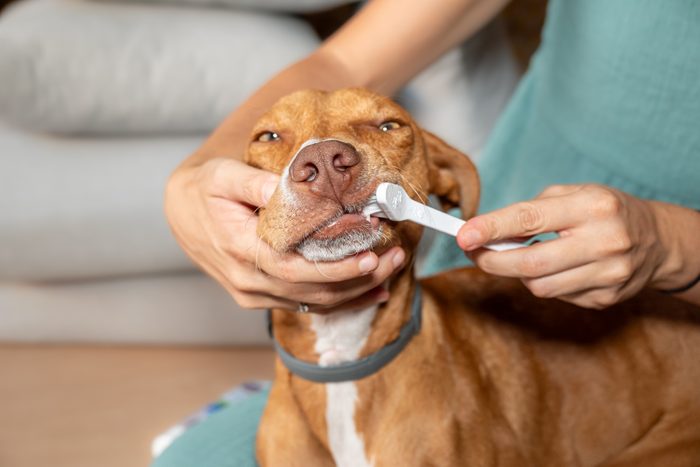
The next day, repeat the previous steps. This time, you’ll clean the teeth on the other side of your dog’s mouth. Remember, there’s no need to clean the inside of the teeth since the dog’s tongue keeps those surfaces clean. Just wipe the outside of the teeth. As your dog builds up tolerance, and you become more comfortable, you can spend more time gently rubbing the teeth back and forth. Again, you’re not scrubbing hard. You want the process to feel gentle and safe.
Step 7: Offer generous praise
Always quit before your dog asks you to stop; it’ll leave your pup wanting more. Then offer praise to your happy dog and treat generously.
Step 8: Move on to cleaning both sides
After two weeks of alternating one-sided teeth cleanings, your dog should understand the process. Hopefully, it also looks forward to this teeth-cleaning routine. Now it’s time to graduate to cleaning all of the teeth at once. This shouldn’t take more than five minutes, including preparation time. If possible, brush daily.
What else keeps a dog’s teeth clean?
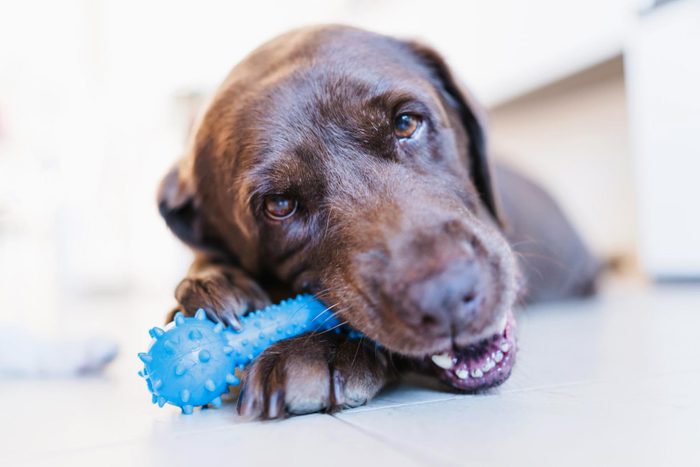
Let’s face it, some dogs refuse to put up with teeth-brushing no matter how slowly and well you train. It’s not worth risking a bite or damaging the relationship you have with your dog. While brushing is ideal, rather than force the issue, there are other ways that help keep your dog’s teeth clean. “If brushing isn’t an option, then other modalities, such as dental diets and dental chews, can be used,” says Dr. Hoyer. “But they aren’t as good as brushing.” Here are some options.
- Dental food: Dogs evolved to gulp and gorge, not to chew. The detergent action of scrubbing teeth by chewing up healthy treats, such as apples and carrots, can help but not as much as we’d like. Thankfully, today we have special foods designed to help reduce or prevent the formation of tartar and plaque. The Veterinary Oral Health Council endorses certain supplements, rinses, pastes and treats that have met this criteria. Look for products that include the VOHC seal of approval and ask your veterinarian for a recommendation.
- Chew toys: Dogs love to chew. Besides the edible chews and treats recommended by VOHC, a wide array of dental chew toys are available. From rope-type dog toys to rubber chews with dental-scrubbing nubs, you can find nearly any size and configuration to fit your tiny-to-giant dog’s mouth. These work by scrubbing the teeth as the dog gnaws. You can improve the effectiveness by adding a dental treat that prolongs the chewing and offers enzymatic or other benefits that address tartar.
- Dental treats: We love to treat our dogs anyway, and offering treats with the VOHC seal ensures we’re helping and not adding to our dog’s dental issues. One of my favorites, Greenies, works great and comes in a variety of sizes and shapes for any size dog. My dog and cats adore Greenies and line up with eager wags and purrs to get their daily treats.
- Dental rinse: There are products you can use to rinse off your dog’s teeth after brushing the teeth. Some you just add to your dog’s water to help keep its teeth clean. They can also help with pungent breath issues.
Do you also have to get your dog’s teeth cleaned professionally?
In a word, yes, says Dr. Hoyer. “Comprehensive anesthetized dental procedures are important, because even if an owner is able to brush every day, there are areas that are impossible to clean unless a patient is anesthetized.” General practice veterinarians are a critical part of providing dental care, and many can perform extractions and other surgical procedures. She says a comprehensive professional veterinary dental procedure includes:
- Pre-anesthetic evaluation (usually including blood work)
- Anesthetized oral examination
- Full-mouth intraoral radiographs (X-rays)
- Cleaning and polishing of all teeth
- Treatment of any identified oral pathology
Dr. Hoyer says monitoring anesthetized pet patients is important. “In dogs, we often don’t know what is actually going on with their oral cavity until after we get the radiographs, which can only be performed in anesthetized patients.”
The general practice veterinarian may not perform specialized procedures like root canals, or want to treat a high-risk anesthesia patient, and instead may refer you to a veterinary dental specialist. Never hesitate to request a referral if you feel more comfortable with a specialist caring for your special pet. “Quality dentistry care is often expensive care,” she says, and it varies so much based on where you live. Call your local veterinarian for a general ballpark, but be aware that the cost may increase depending on what the doctor sees during the procedure.
She suggests asking these questions so you understand the costs involved and what to expect:
- Will the person monitoring my pet’s anesthesia also be performing the dental cleaning?
- What anesthetic monitoring techniques are used?
- Are full-mouth radiographs obtained for every procedure?
- Are the radiographs reviewed by a veterinarian?
- Who performs the anesthetized oral examination?
- What are the plans if my animal develops an anesthetic complication?
- If my pet needs extractions, how will I be informed, and who will perform them?
In most cases, damaged or decayed teeth get removed, not repaired. That’s why brushing your dog’s teeth not only improves their health but also saves you pocketbook pain. You can reduce the frequency of required professional cleanings by learning how to clean your dog’s teeth at home.
Signs of dental disease in dogs
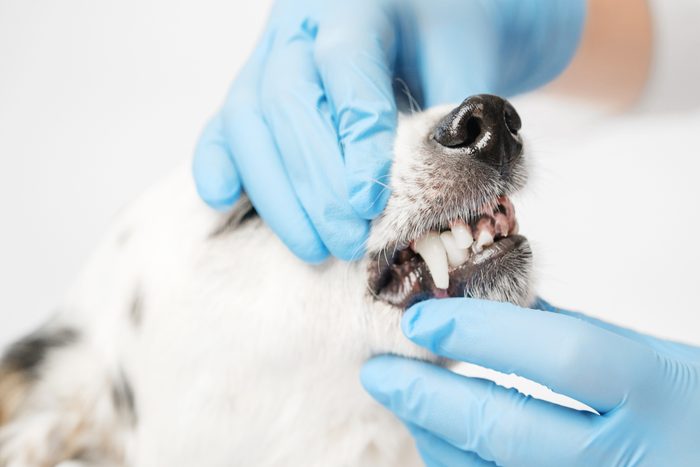
Unfortunately, you probably won’t notice dog dental problems until they become advanced. “Often, pets don’t show any signs of periodontal disease, but things to look for at home include bad breath, red and bleeding gums, changes in eating behaviors and signs of pain around the mouth,” says Dr. Hoyer. Other warning signs may include:
- Broken teeth: Dogs that chew hard objects like rocks, sticks or hard toys may break off or loosen teeth.
- Yellow to brown plaque: One of the most noticeable signs of periodontal disease is a buildup of gross-looking hard deposits at the base of the dog’s teeth.
- Discolored teeth: A discolored tooth could indicate the death of the tooth root or a crack in the enamel. That can cause great pain.
- Facial swelling: Just as with people, an abscessed tooth can cause swelling of the jaw.
- Blood on a toy: You might never notice the dog’s bleeding gums until blood stains a toy.
- Irritability: A classic sign of dog dental issues is a gradual change in behavior. Happy dogs become snappy; energetic dogs may sleep more and become reluctant to play. Once teeth problems resolve with treatment, dog owners often are amazed at how they act like a puppies again.
FAQs
What softens tartar on a dog’s teeth?
Tartar is a film that grows on teeth. It can be dissolved with some of the dental diet and treat formulations (and dog toothpaste) that help prevent it sticking to the teeth or forming in the first place. A dental chew toy can help mechanically remove tartar film, as can brushing the dog’s teeth.
Should I scrape the plaque off my dog’s teeth?
No. Any kind of tool capable of mechanically scraping away plaque could also slip and injure your dog. Plaque also extends below the gum line, and you can’t access that while your dog remains awake.
What is the best natural way to clean a dog’s teeth?
The best way to naturally clean a dog’s teeth is to provide healthy and safe chew options, brush the dog’s teeth and provide a dental diet and/or treats that help prevent tartar buildup.
Is it too late to start brushing my dog’s teeth?
No. While puppies often accept new things more readily, with patience, dogs of any age can learn to accept home dental care.
Why trust us
At Reader’s Digest, we’re committed to producing high-quality content by writers with expertise and experience in their field in consultation with relevant, qualified experts. For this piece, dog exert Amy Shojai, CABC, tapped 30 years of experience teaching and writing about pet behavior, and then Wailani Sung, MS, PhD, DVM, DACVB, a board-certified veterinary behaviorist in San Francisco, gave it a rigorous review to ensure that all information is accurate and offers the best possible advice to readers. For this piece, we relied on reputable primary sources, including a veterinarian and certified dog behaviorists. We verified all facts and data and backed them with credible sourcing, and we will revisit them over time to ensure they remain accurate and up to date. Read more about our team, our contributors and our editorial policies.
Sources:
- Naomi Hoyer, DVM, DAVDC, board-certified veterinary dentist; email interview, Feb. 20, 2024
- VCA Animal Hospitals: “Dental Disease and Its Relation to Systemic Disease in Pets”
- The Veterinary Oral Health Council: “VOHC Accepted Products”
- American Veterinary Dental College: “Mission and Objectives”
- Cornell Richard P. Riney Canine Health Center: “Periodontal Disease”
We’re rounding the corner into 2024, and everyone is more than ready to usher in the new year. Some people are celebrating by throwing a New Year’s Eve party (complete with some super fun games), whereas others are watching New Year’s Eve movies while waiting for the ball to drop.
No matter what you do, though, there’s always room for New Year’s humor. And lucky for us, there are plenty of New Year’s jokes! So kick off 2024 with some laughs by telling these hilarious puns and one-liners all the way to midnight.
Get Reader’s Digest’s Read Up newsletter for more humor, holiday tips, cleaning, travel, tech and fun facts all week long.

The funniest New Year’s jokes and puns
1. What is a New Year’s resolution?
Something that goes in one year and out the other.
2. What do snowmen like to do on New Year’s Eve?
Chill out.
3. Youth is when you’re allowed to stay up on New Year’s Eve. Middle age is when you’re forced to.
4. What do New Year’s Day parades have in common with Santa Claus?
No one is awake to see either of them.
5. My grandparents had resolutions like donating more time and money to charities. I’ve decided to make my own coffee once a week.
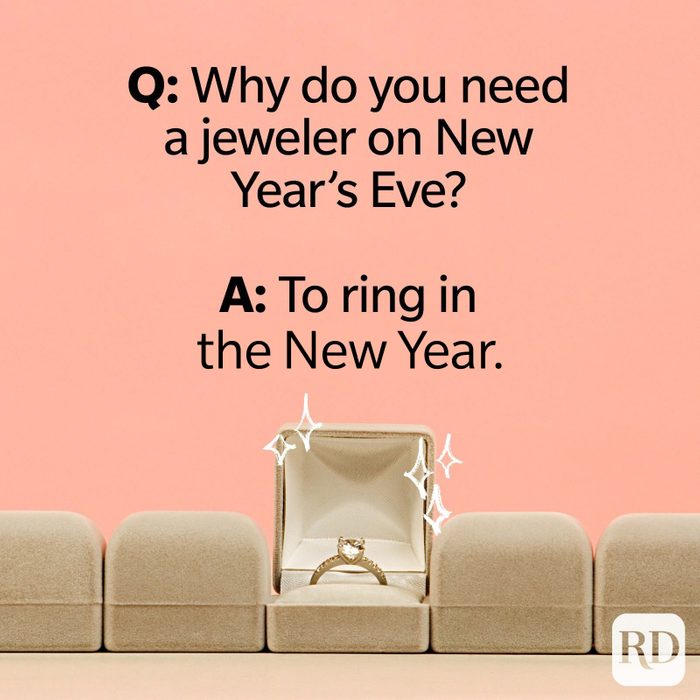
6. Why do you need a jeweler on New Year’s Eve?
To ring in the New Year.
7. My New Year’s resolution is to stop hanging out with people who ask me about my New Year’s resolution.
8. What did the little champagne bottle call his father?
Pop!
9. What’s a cow’s favorite holiday?
Moo Year’s Eve.
10. Where can you find comedians on New Year’s Eve?
Waiting for the punch line.
11. What do farmers give their wives at midnight on New Year’s Eve?
Hogs and kisses.
12. An optimist stays up until midnight to see the new year in. A pessimist stays up to make sure the old year leaves.
Loving these New Year’s jokes? Feel free to use them as funny New Year’s captions on Instagram.
13. What did the ghost say on Jan. 1?
Happy Boo Year!
14. What do you call always wanting a date for New Year’s Eve?
Social security.
15. What’s a digital camera’s New Year’s resolution?
1080p.
16. This New Year’s, I’m going to make a resolution I can keep: no dieting all year long.
17. Knock, knock.
Who’s there?
Abby.
Abby who?
Abby New Year!
18. Where can you go to practice math on New Year’s Eve?
Times Square.
19. Why should you put your new calendar in the freezer?
To start off the New Year in a cool way.
20. What do you tell someone you didn’t see on New Year’s Eve?
I haven’t seen you for a year!
21. This New Year’s, I’ve resolved to lead a better life. Now all I have to do is find someone who will trade lives with me.
22. What happened to the man who shoplifted a calendar on New Year’s Eve?
He got 12 months!

23. What is corn’s favorite holiday?
New Ears Day!
24. What’s the one group that hates New Year’s Day?
The New Year’s Eve cleanup crew.
25. What did Adam say to Eve on Dec. 31?
It’s New Year’s, Eve.
26. Why was the telephone late for work on Jan. 1?
It was busy ringing in the new year!
27. What did George Washington do in the days leading up to New Year’s?
He made a New Year’s revolution.
28. What compliment did the drink glass give to the champagne on New Year’s Eve?
“You’re so bubbly!”
29. I don’t know why people flock to Times Square on New Year’s Eve. They always drop the ball.
30. Why is New Year’s a slice of bread’s least favorite holiday?
It has to make a toast.
31. Why did the man stand on one leg at midnight on New Year’s?
He wanted to start the year on the right foot.
32. Why was the Hershey bar bummed on New Year’s Eve?
It got stuck waiting for a midnight Kiss.
33. What do kangaroos say to each other at midnight on Jan. 1?
“Hoppy New Year!”
34. What did the woman say when she was offered a raisin on New Year’s Eve?
“No thanks. I already have a date.”
Looking for more New Year’s jokes and humor? These funny New Year’s memes will have you laughing into 2024.

35. What was the opening line of the spice rack’s New Year’s toast?
“Cheers to the good thymes!”
36. My dad gave up smoking cold turkey for New Year’s. He’s doing better now but … he’s still coughing up feathers.
37. What was Dr. Frankenstein’s New Year’s resolution?
To make new friends.
38. What do you call someone who says they know all the words to “Auld Lang Syne“?
A liar.
39. What’s the worst part of jogging on New Year’s Eve?
The ice falling out of your drink!
40. I made a New Year’s resolution to drink more water. I’ve only gotten as far as “drink more.”
41. What New Year’s resolution should a basketball player never make?
To travel more.
42. Did you hear about the guy who started fixing breakfast at midnight on Dec. 31?
He wanted to make a New Year’s toast.
43. Why did the man sprinkle sugar on his pillow on New Year’s Eve?
He wanted to start the year with sweet dreams.
44. Knock Knock.
Who’s there?
Radio.
Radio who?
Radio not, it’s a new year.
45. What should people never eat on New Year’s Eve?
Fire crackers.
46. What does a caterpillar do on Jan. 1?
Turns over a new leaf.
New Year’s one-liners
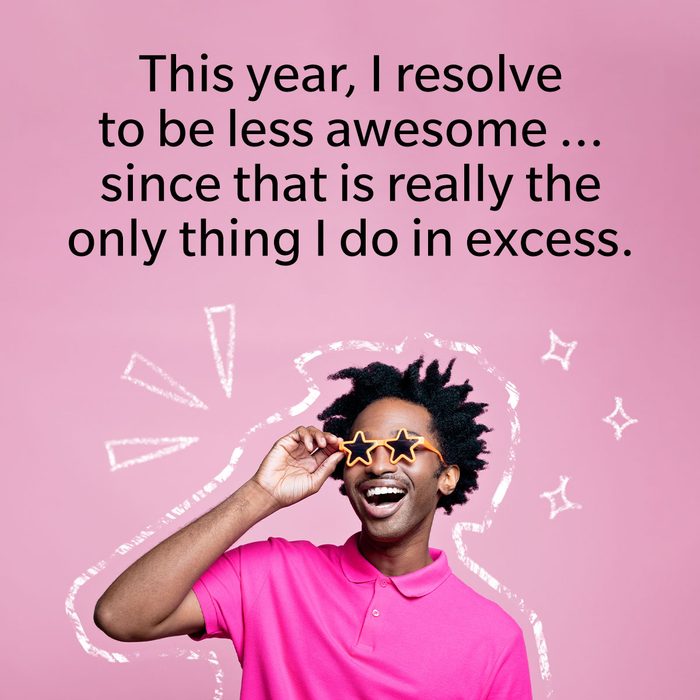
47. This New Year, I resolve to be less awesome … since that is really the only thing I do in excess.
48. Not to brag, but I already have a date for New Year’s Eve—Dec. 31.
49. My New Year’s resolution is to get better at pretending to know the words to “Auld Lang Syne.”
50. My resolution was to read more, so I turned on the subtitles on my TV.
51. I was going to quit all my bad habits for the new year, but then I remembered that nobody likes a quitter.
52. I see no need to make more New Year’s resolutions when the ones already on the books aren’t being enforced.
Submit your best joke here, and get $25 if Reader’s Digest runs it.
Start your morning with a cuppa jokes (and some funny coffee quotes). Drink up these coffee puns based on your flavor-ite songs, bands, movies, TV shows, and books. Cool story, brew! If you like your roast strong, hit the (coffee) grounds running, with these nutty, rich, and stimulating puns! They’re perk-fection for procaffeinating during the daily grind. Stay frappé! (P.S.—save these hilarious wine puns to browse through during happy hour.)
“Pour some sugar on me” with these choc’ n’ roll coffee puns set to music!
“I love brew. I honestly love brew.”
Remember Olivia Brew-ton John’s mega pop hit from the seventies? Her vocal sweetness captures how we all feel about coffee.
“Excuse me while I kiss the chai.”
Imagine if Jimi Hendrix’s legendary rock song “Purple Haze” was really an ode to a chai tea latte? All any of us need is a little caffeine to clear the haze.
“Thank you for bean a friend!”
Of course, The Golden Girls theme song is a celebration of friendship, just like the show itself. Coffee is also your BFF. (Brewed Full-bodied Forever!) Check out these un-beetable vegetable puns for more laughs.
“Wake me up before you cocoa!”
Wham’s totally addictive ’80s pop hit perfectly captures our need for a hot beverage in the morning!
“My coffee amour, milky little cup that I adore.”
Stevie Wonder’s beautiful soul song gets it exactly right when it comes to your love affair with coffee. Why do we love it so much? Check out the things that happen to your body when you drink coffee every day.
Here are your TV show coffee puns—just add streaming and sugar

The X-Filters
This sci-fi classic follows Scully and Mulder as they hunt for the perfect cappuccino and UFOs—Unidentified Fair-trade Organic coffees.
Pretty Little Lattes
A coffee klatch of teen girls face the mystery of a lost barista in this bold drama that’s fresh and flavorful.
Twin Perks
Tensions percolate in this regional tale about dark roasts that move at a slow drip. Will give you the jitters!
Coffee, the Vampire Slayer
Trouble brews when creatures of the dark try to switch to decaf. So, a robust, young woman, “Cuffy,” fulfills her destiny and gets in hot water as she tracks caf-fiends.
Friday Night Lattes
It’s full steam ahead in this show about a beverage joe and his football bean. It may be a small-town Texas bean, but it boasts the greatest joe on earth. The teenaged beans grind it out with a full cold press in this earthy drama. A true brew-mance! Check out the best coffee shop in Texas, and all the 50 states.
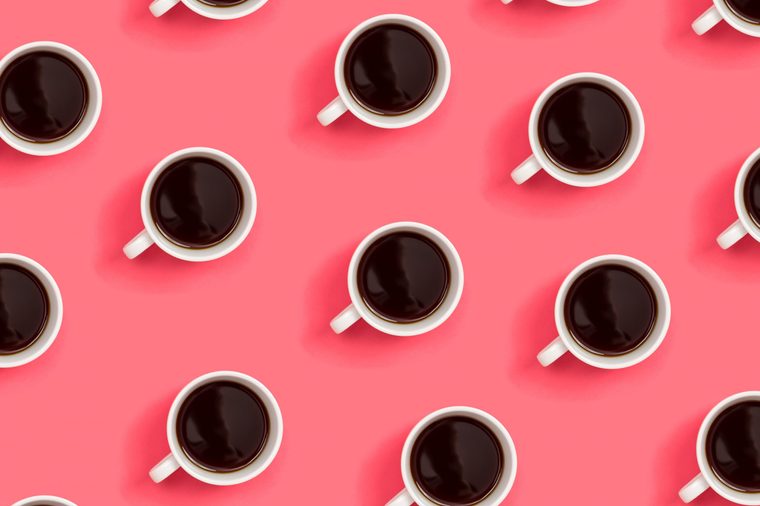
Pour-over these addictive novels about coffee—with puns! Hold my brew!
For Whom the Bean Tolls
It tolls for beans! Ernest Hemingway’s classic novel about the nature and experience of Spanish coffee got its title from John Donne’s famous poem about beankind. Because no bean is an island.
David Coffeefield
The famous first line of Charles Dickens’ epic novel states, “Whether coffee shall turn out to be the hero of my own life, or whether that station will be held by tea, these pages must show.” If you enjoy Dickens, next try Great Percolations, Bleak Coffee House, and A Tale of Two Chicories.
The Count of Macchiato
This strong, saucy tale by Alexandre Dumas follows a man who is wrongly given decaf coffee—for years—and justifiably, must seek revenge.
The Lord of the Beans
J.R.R. Tolkien’s epic fantasy about the coffee bean industry of middle earth brims with rich nuttiness.
The Brothers Caramel Mocha
You may find Fyodor Dostoevsky’s bitter, aromatic novel far less sweet than its title suggests. Did you know that people who like to drink their coffee black may be psychotic?
What’s the best band of coffee? Give it your best shot with these coffee pun band names
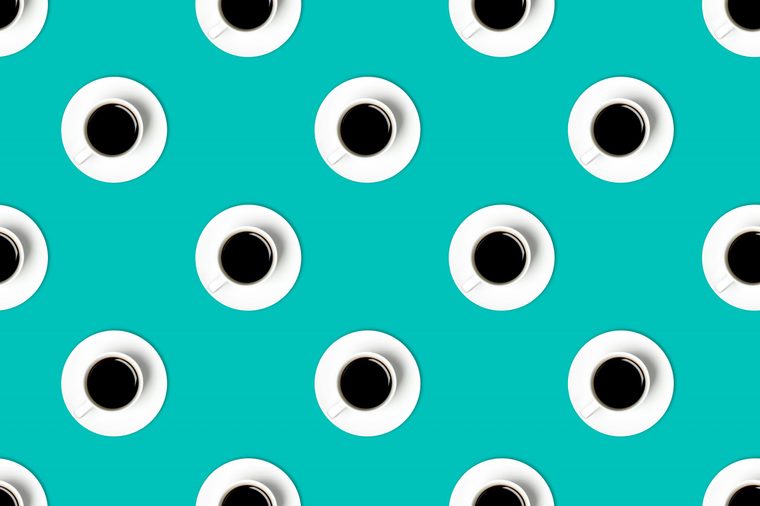
The Smashing Pumpkin Spice Lattes
Their ’90s album “Mellon Collie and the Infinite Sadness” may make you a little despresso.
Rage Against the Espresso Machine
These rock purists feature blends of punk, thrash, metal, and hip-hop in their grinds.
The Red Hot Coffee Peppers
Caffeine-infused vibes and intense percolations make for a robust band of Americano brews.
AC/Decaf
Their vigorous album, “For Those About to Rock, We Salute Brew,” uses hard beans with dark, metallic undertones.
Fleetwood Macchiato
Their pop hit, “Don’t Stop Thinking About Your Coffee,” will really perk you up.
More of a tea person? You’ll love these hilarious tea puns!
Coffee puns at the box office—for some good clean pun! It’s a wonderful latte!
There’s Something about Mocha
It’s the adventure of a bunch of brews obsessed with a brew-tiful blonde.
That Thing You Brew!
This feel-good romp features a perky hit song that you’ll like a latte.
Back to the Frother
When it comes to froth, you need perfect timing. Better latte than never.
The Polar Espresso
Kids escape late at night to visit Sanka, and shouldn’t they be grounded?
He’s Just Not That Into Brew
There are a few frappé cup-ples by the end of this brew-mance that features mugs and kisses. Are you the type to annoy your barista? Check out the 10 rude coffee shop habits you can stop doing a latte.
